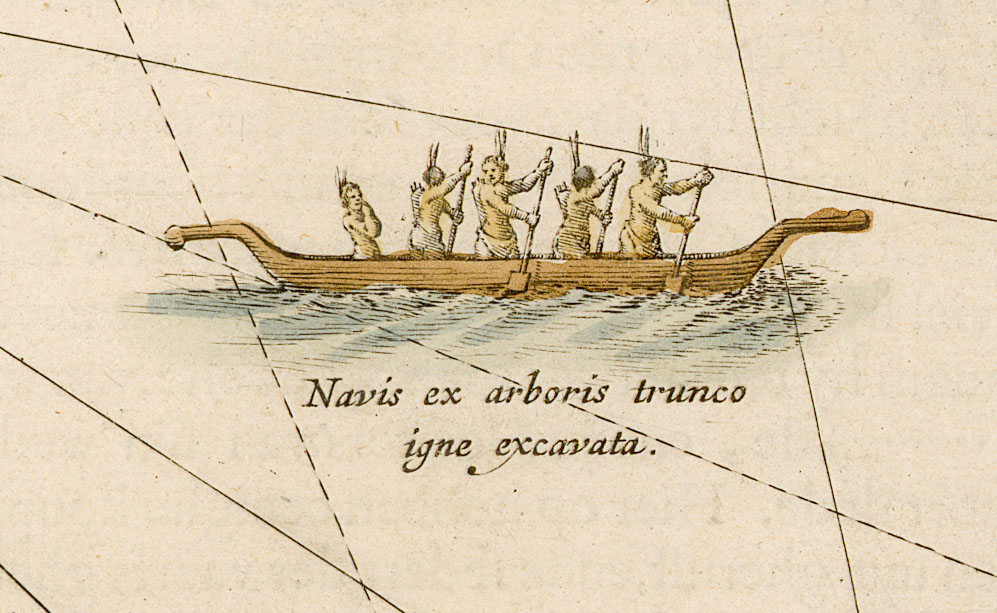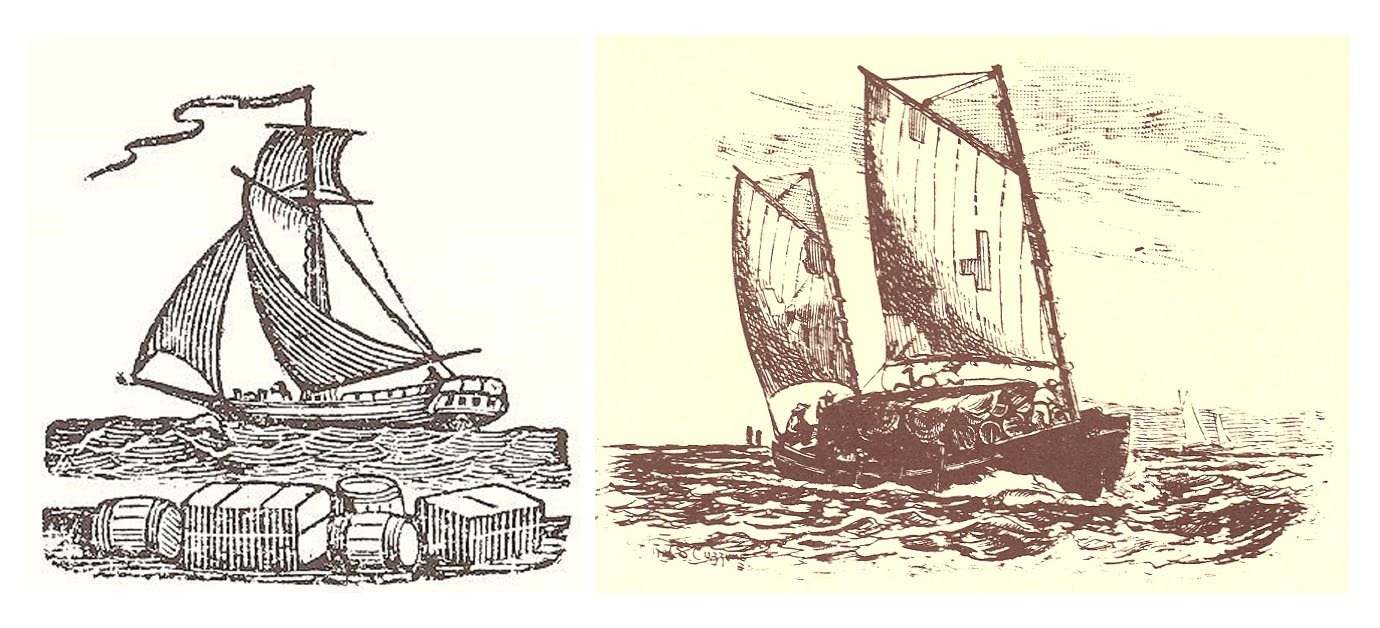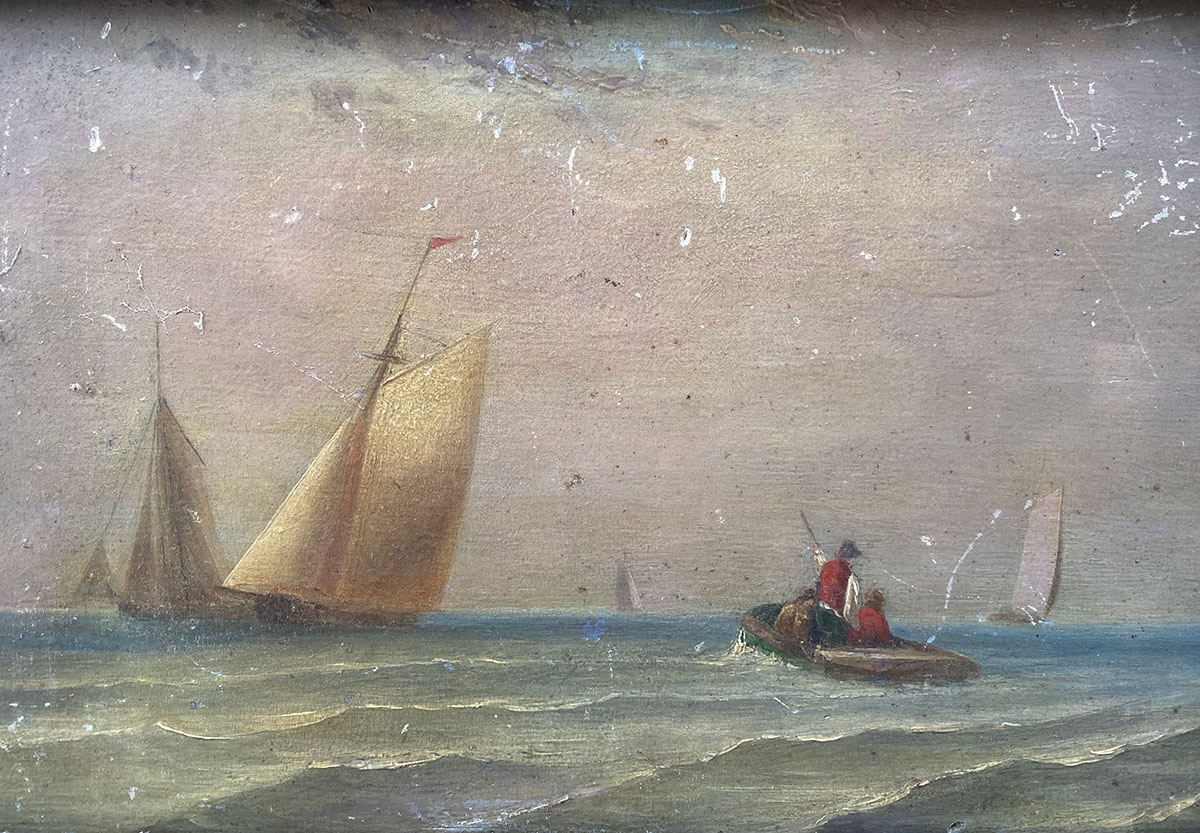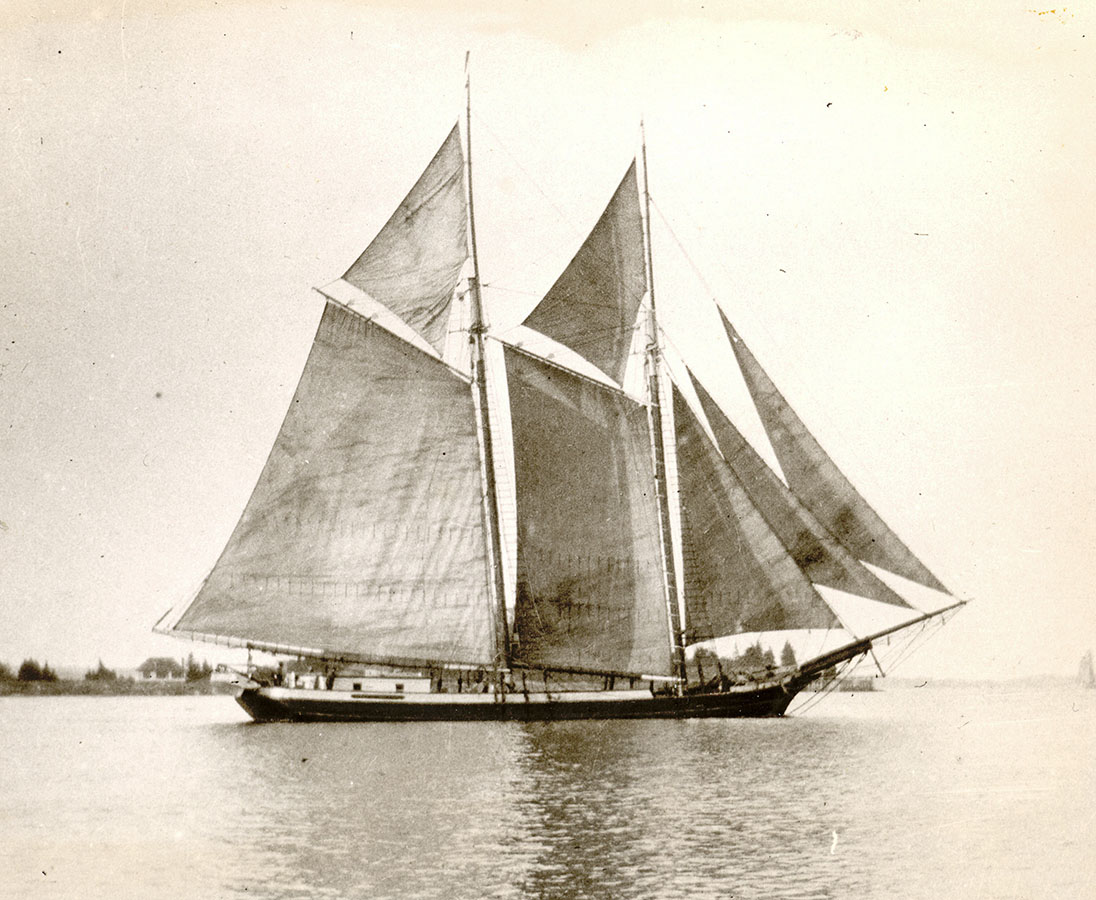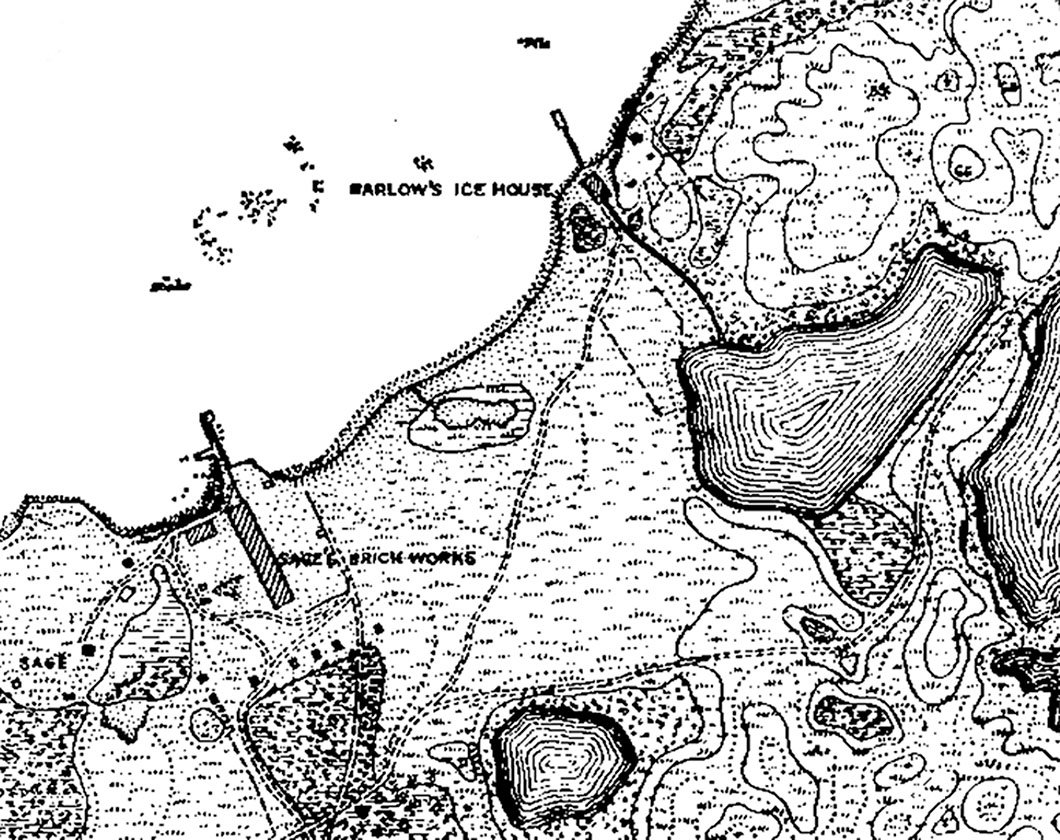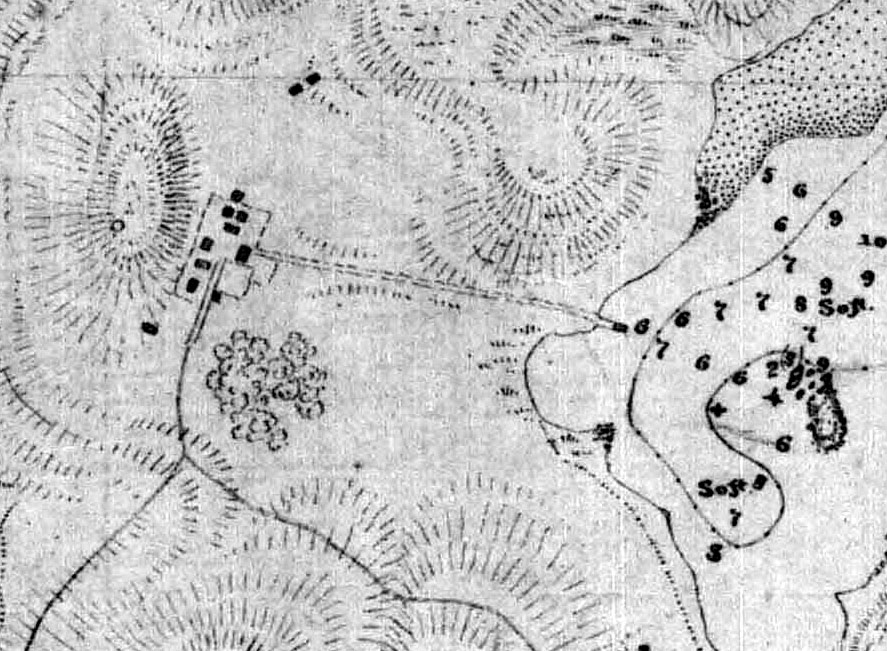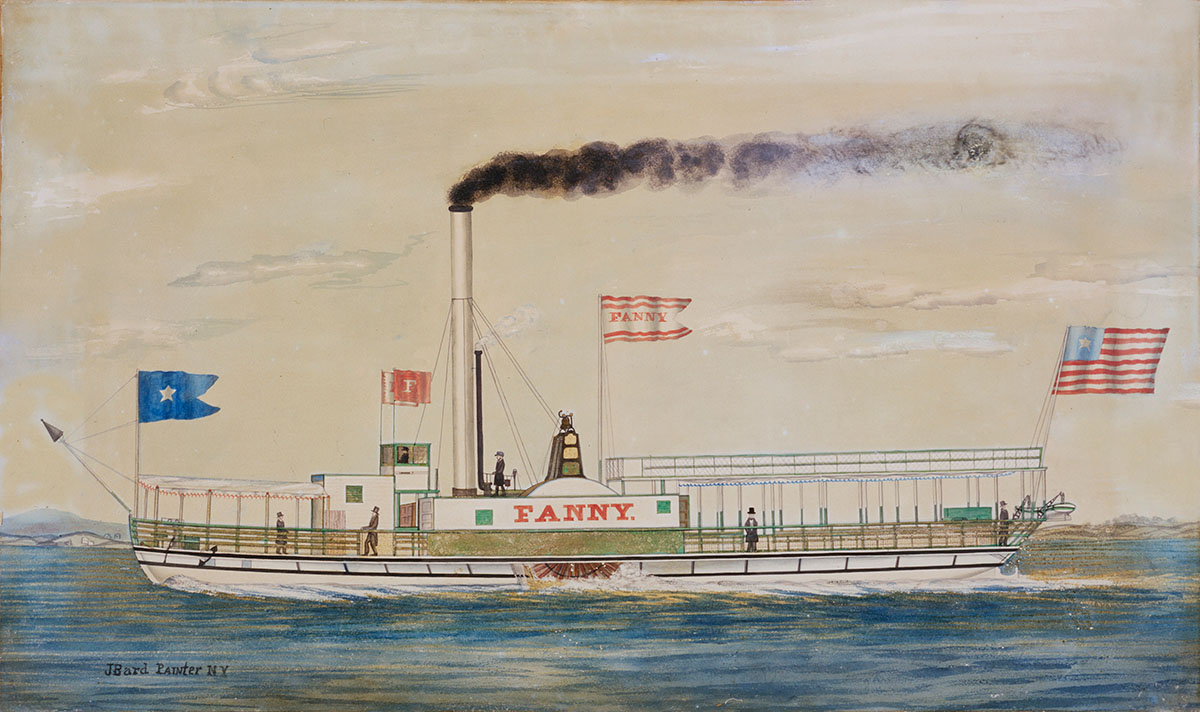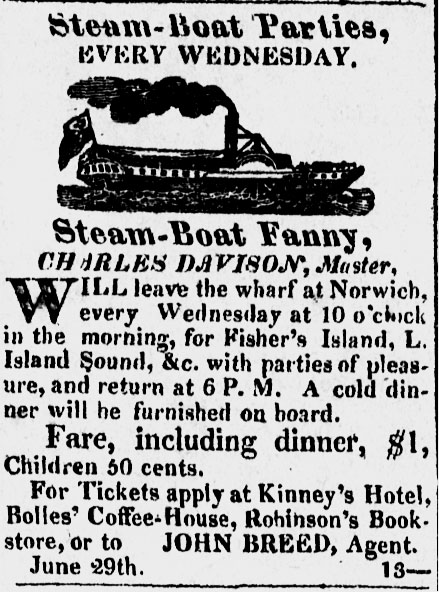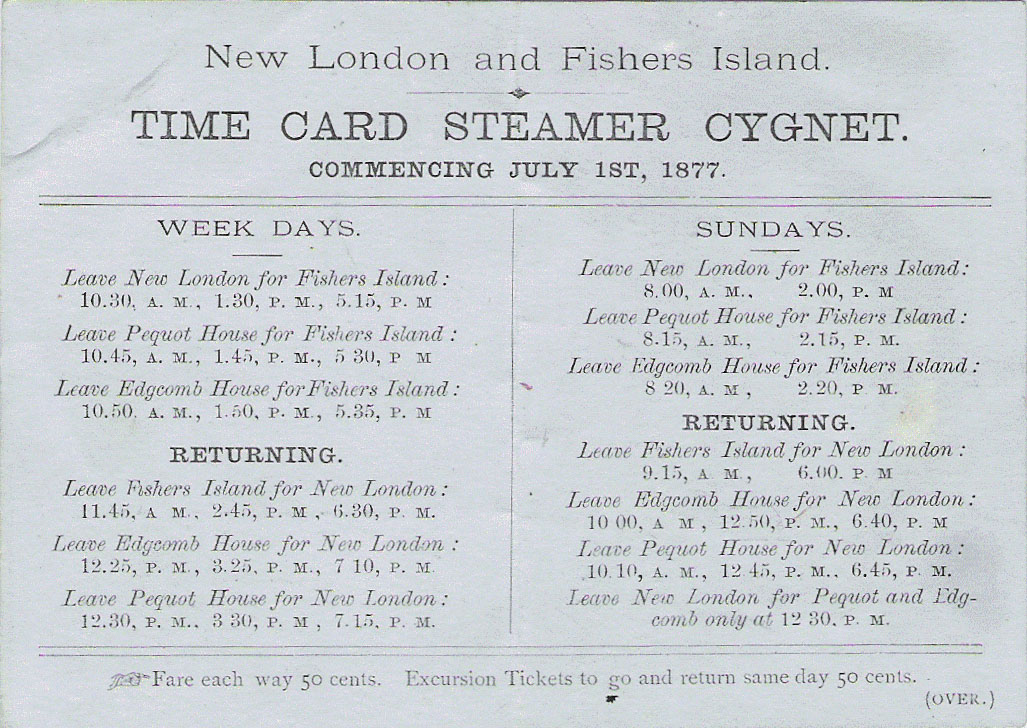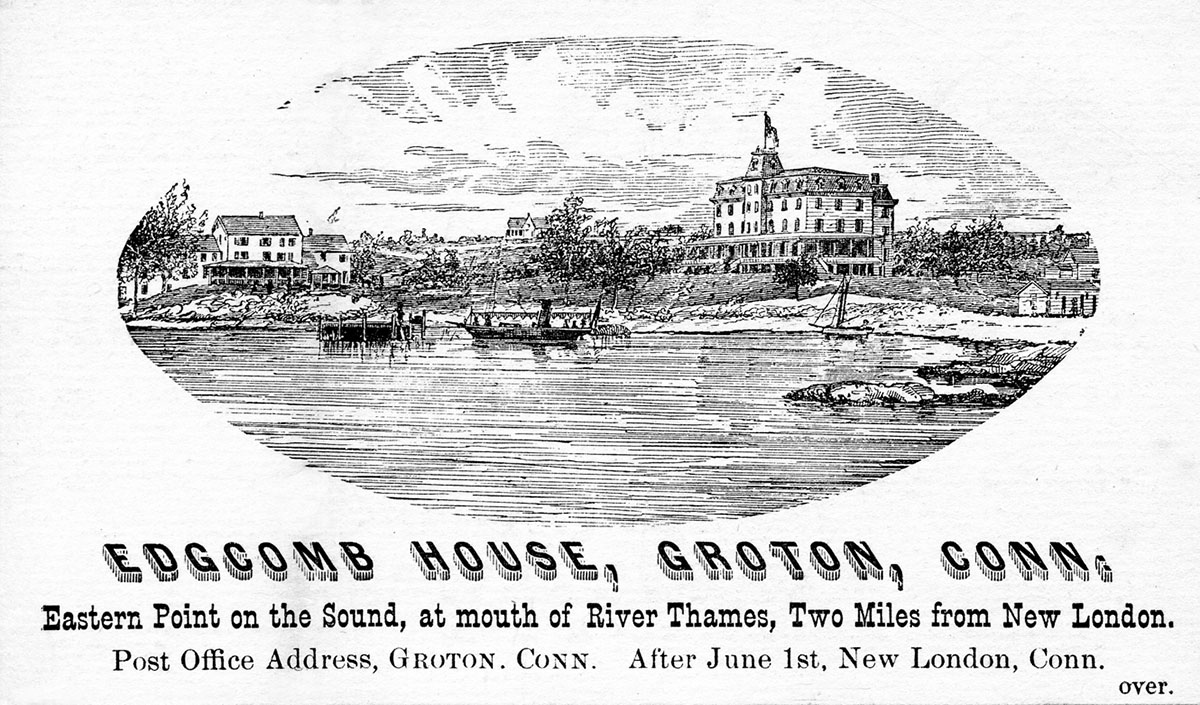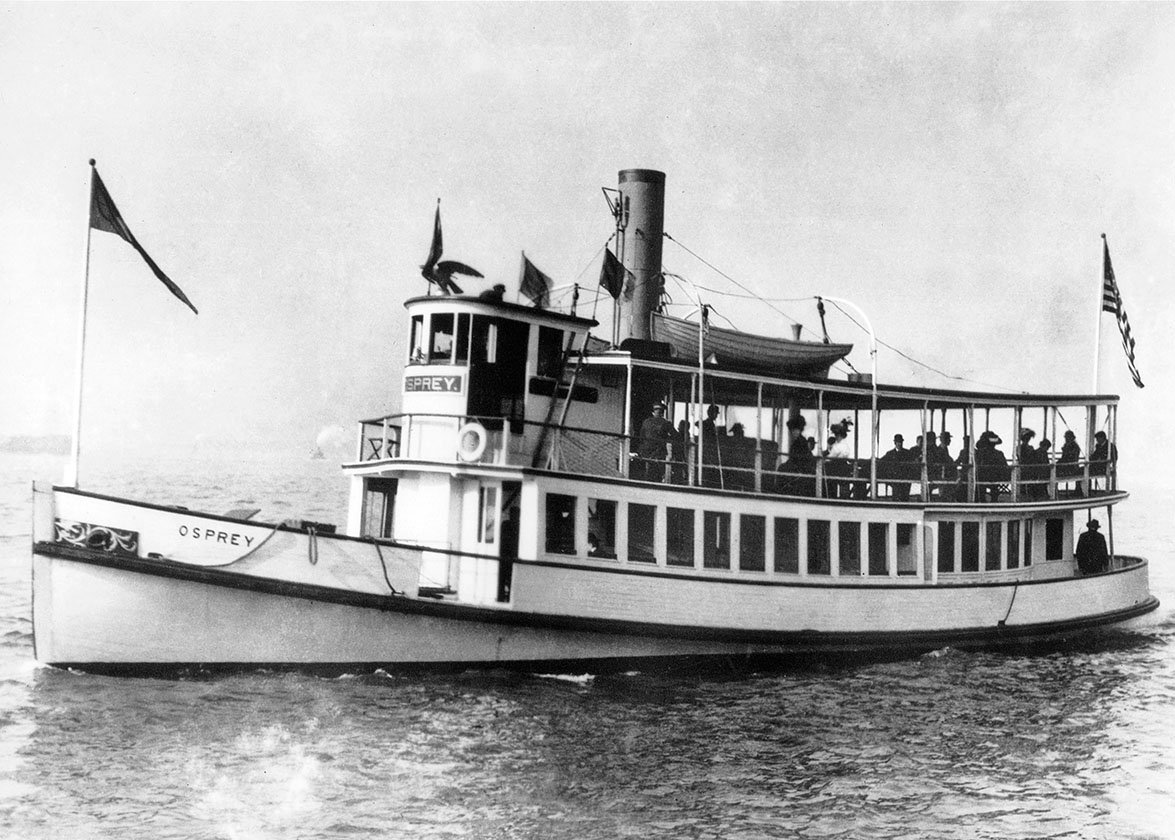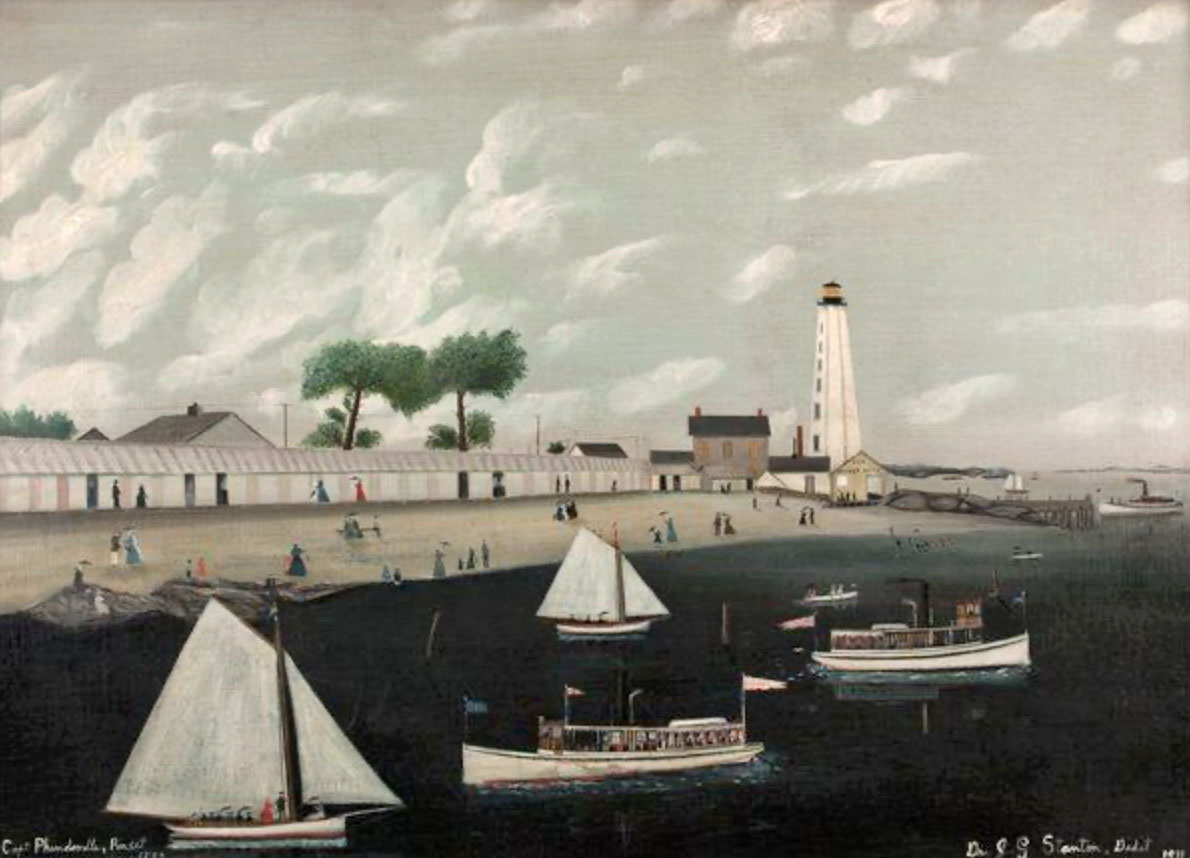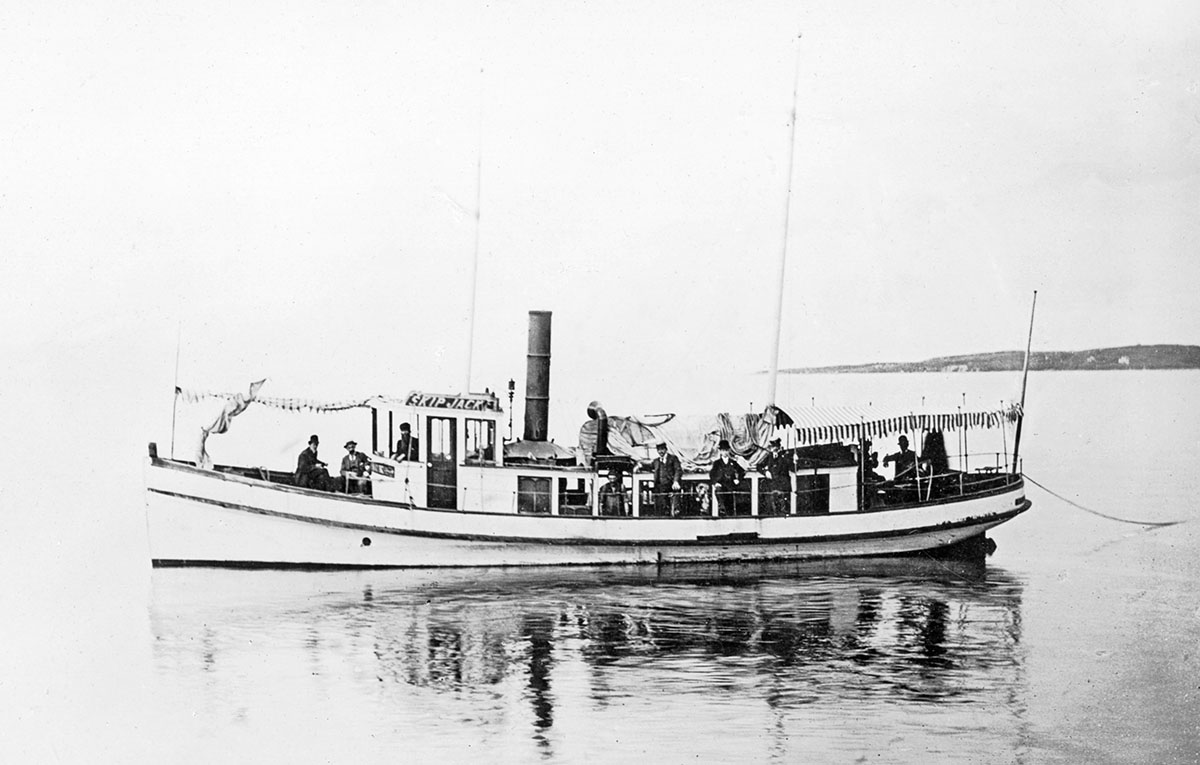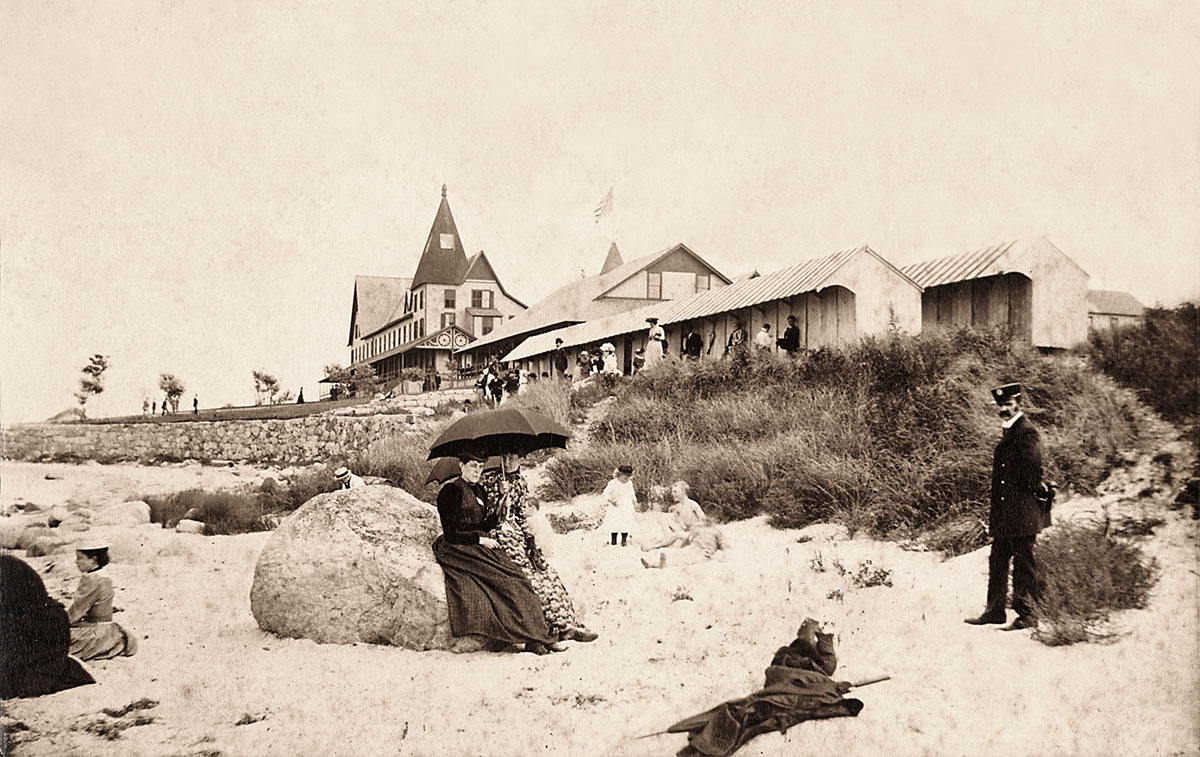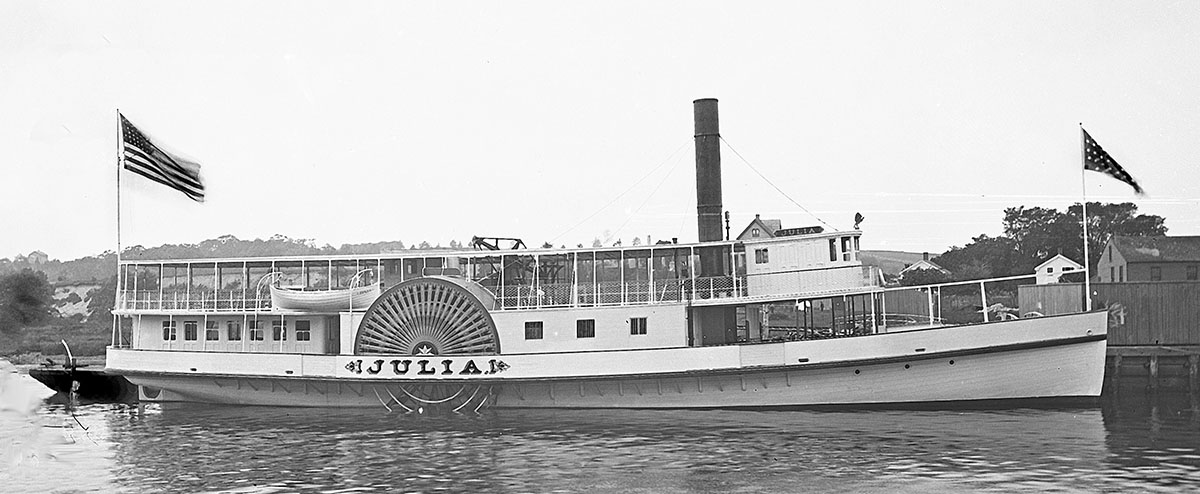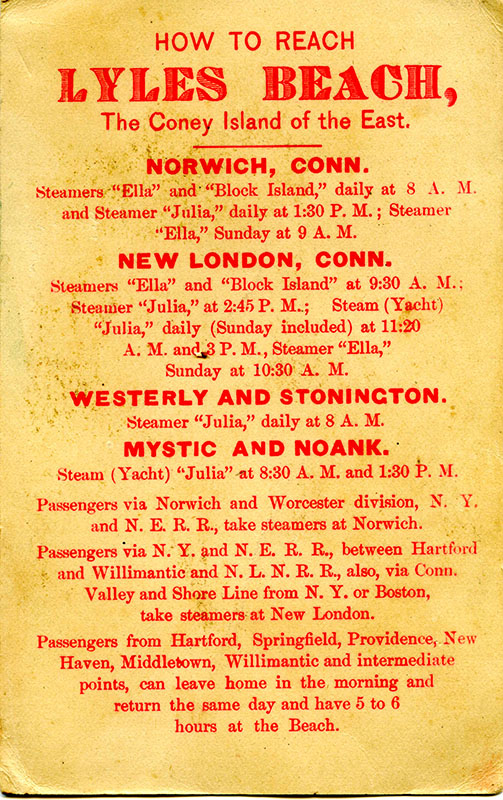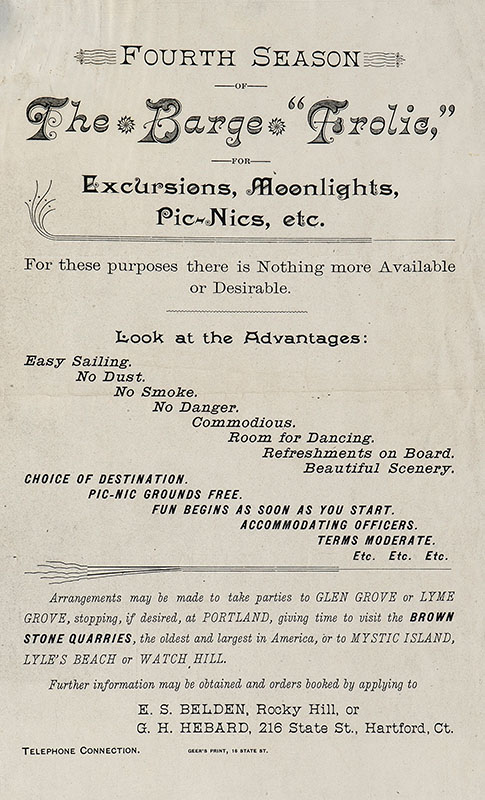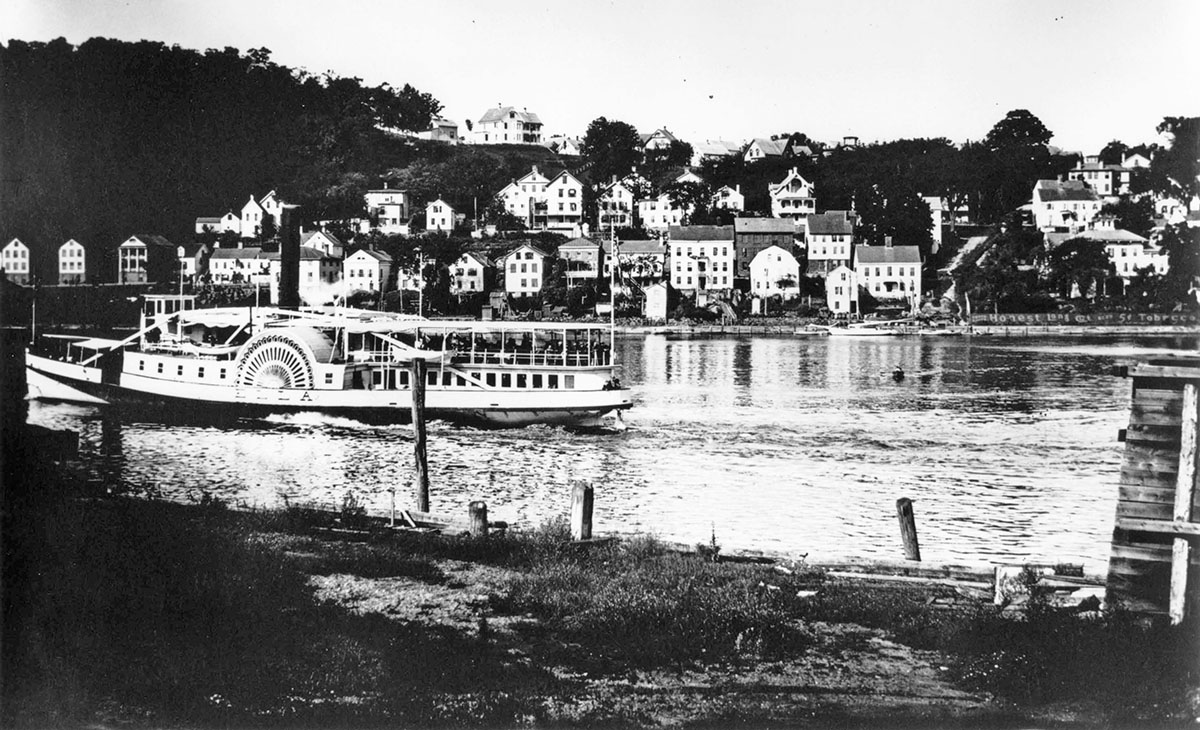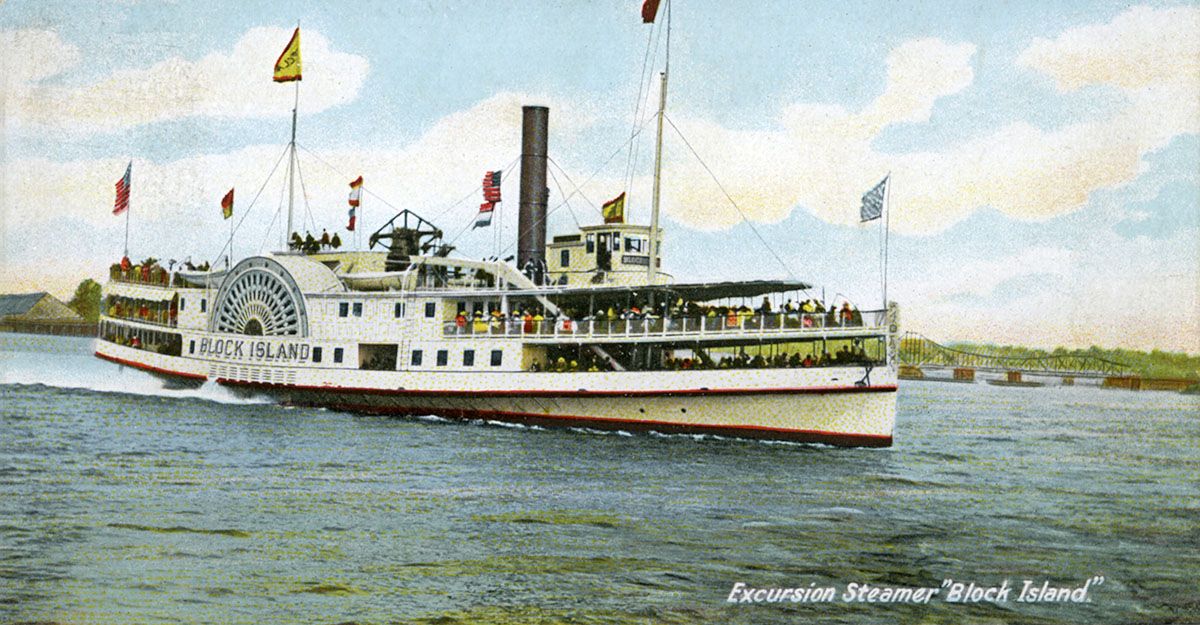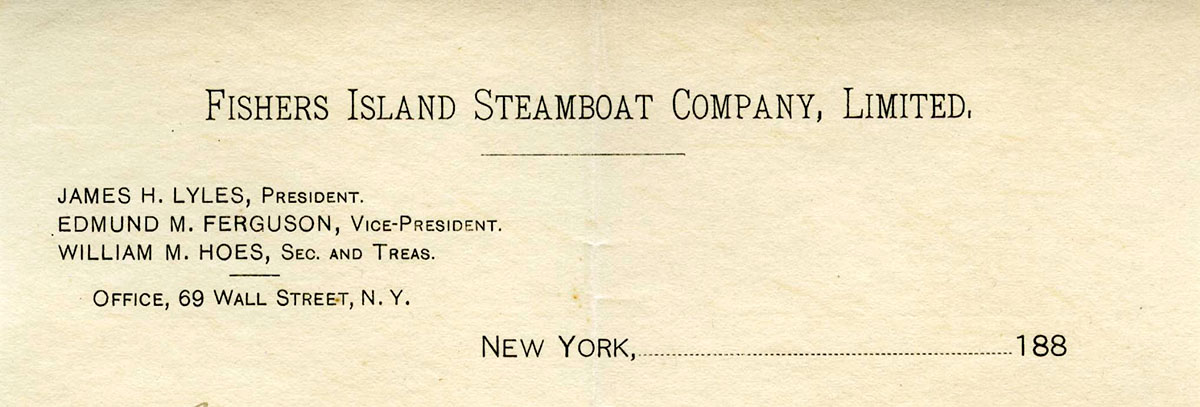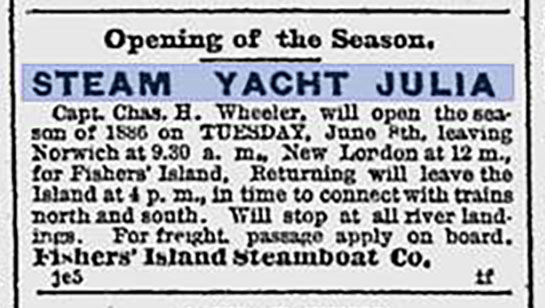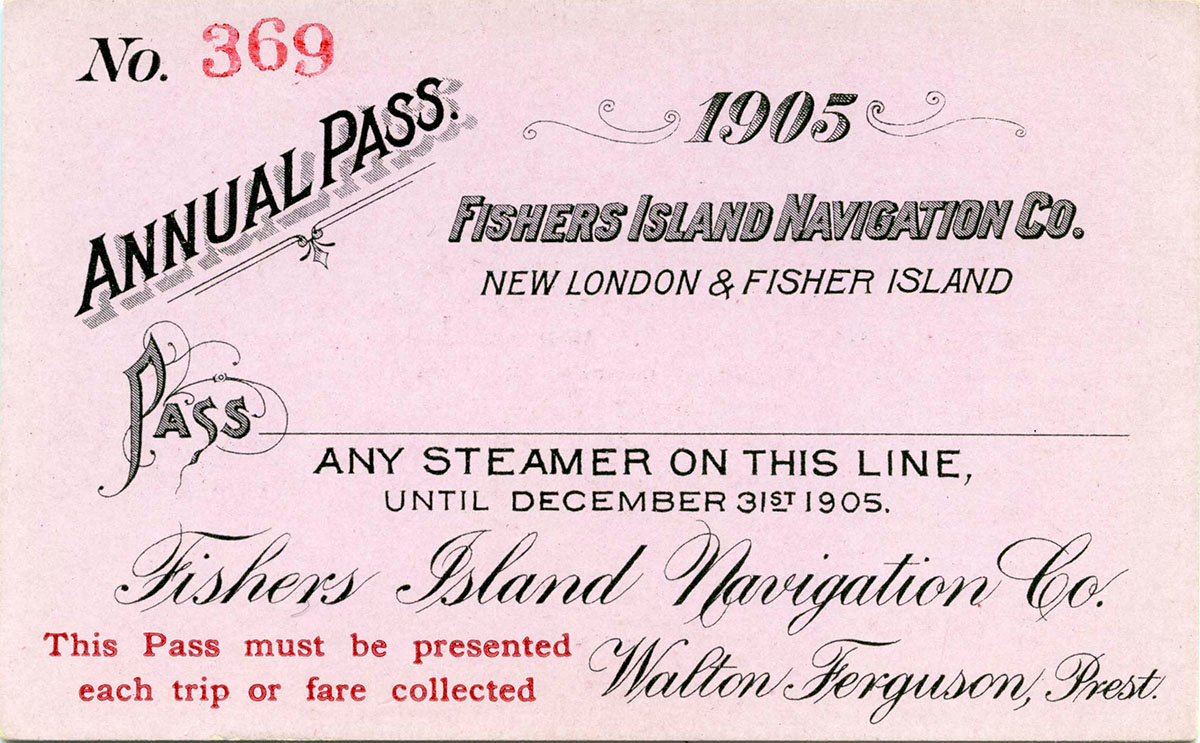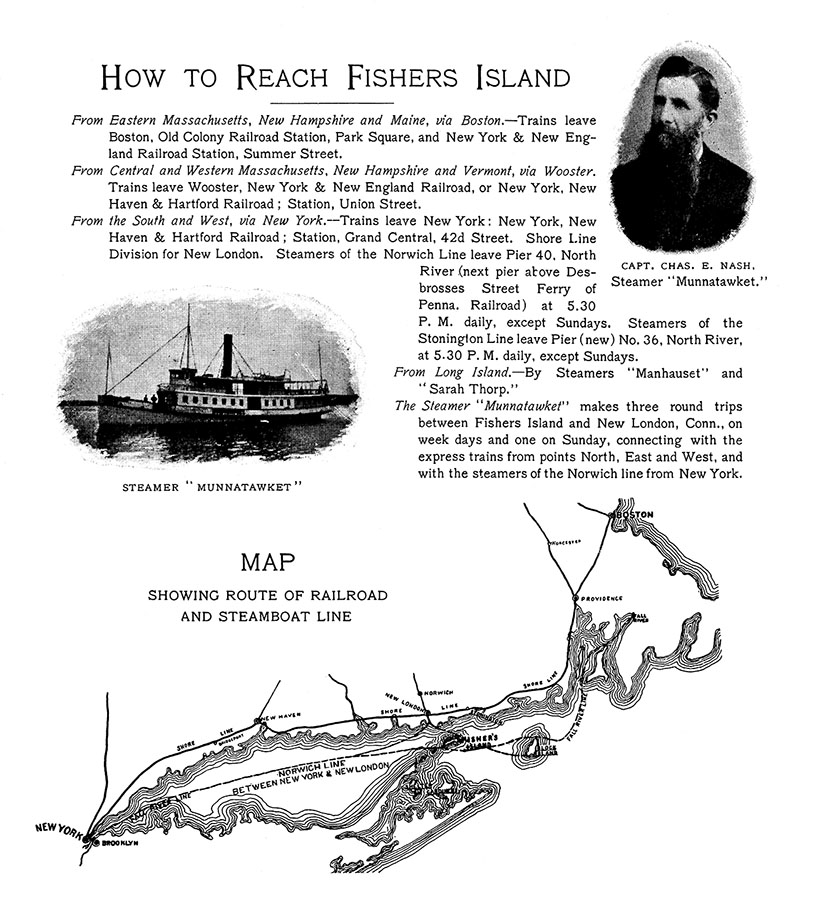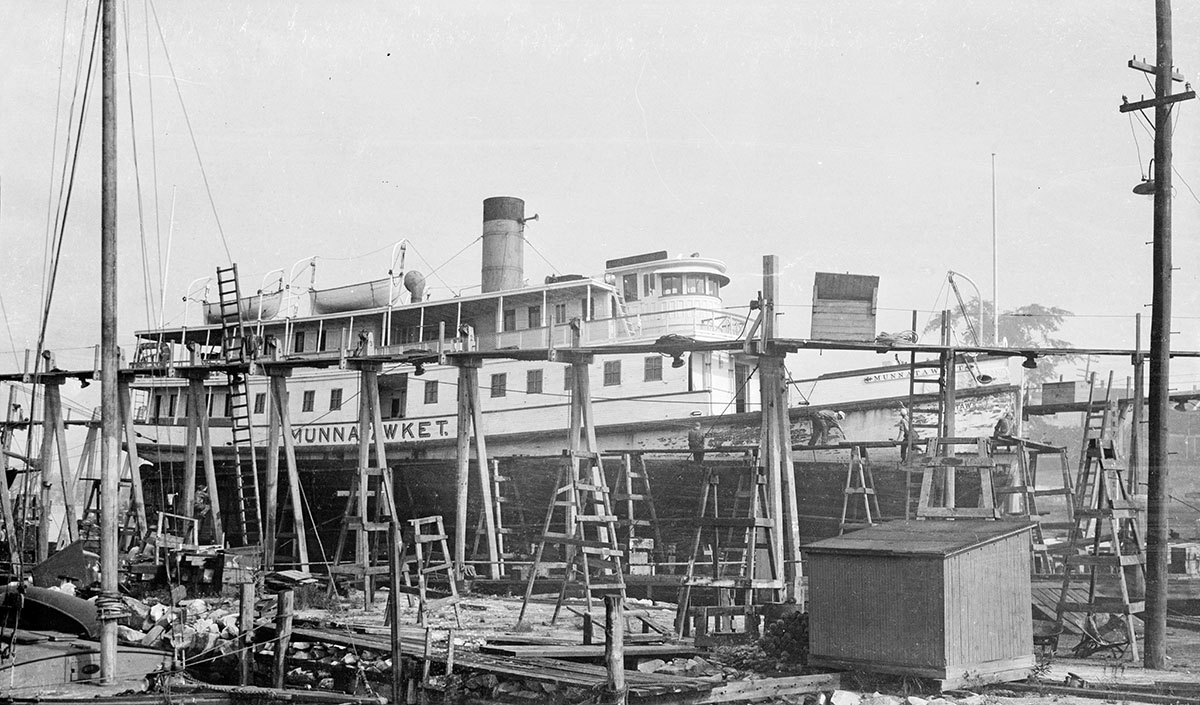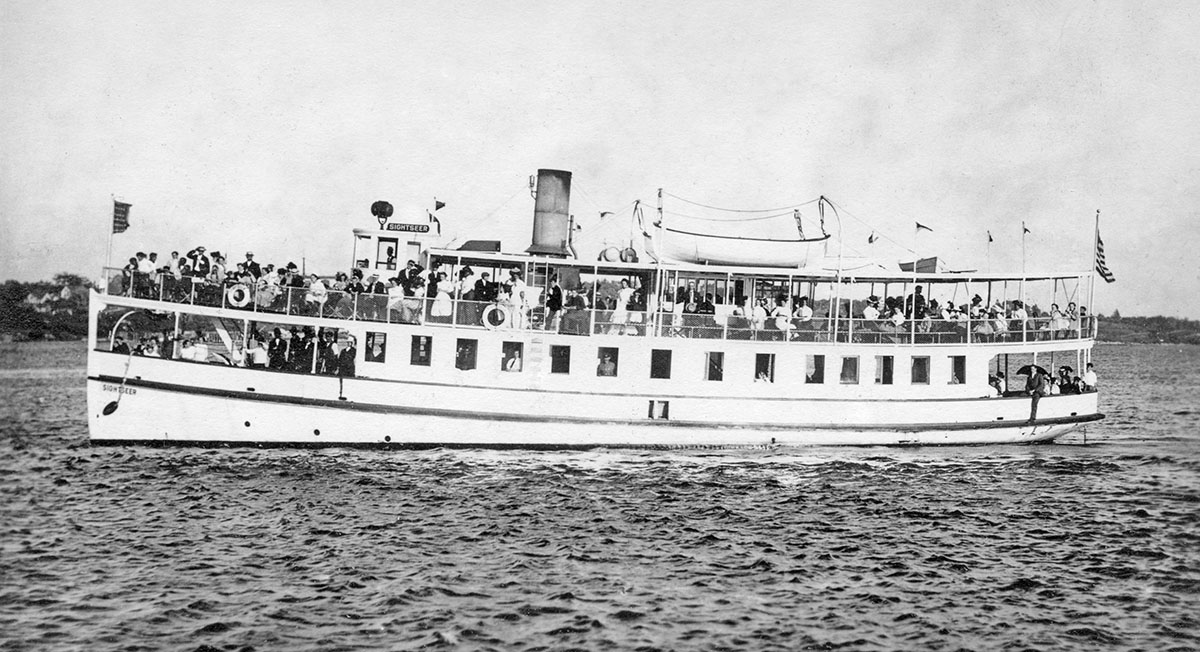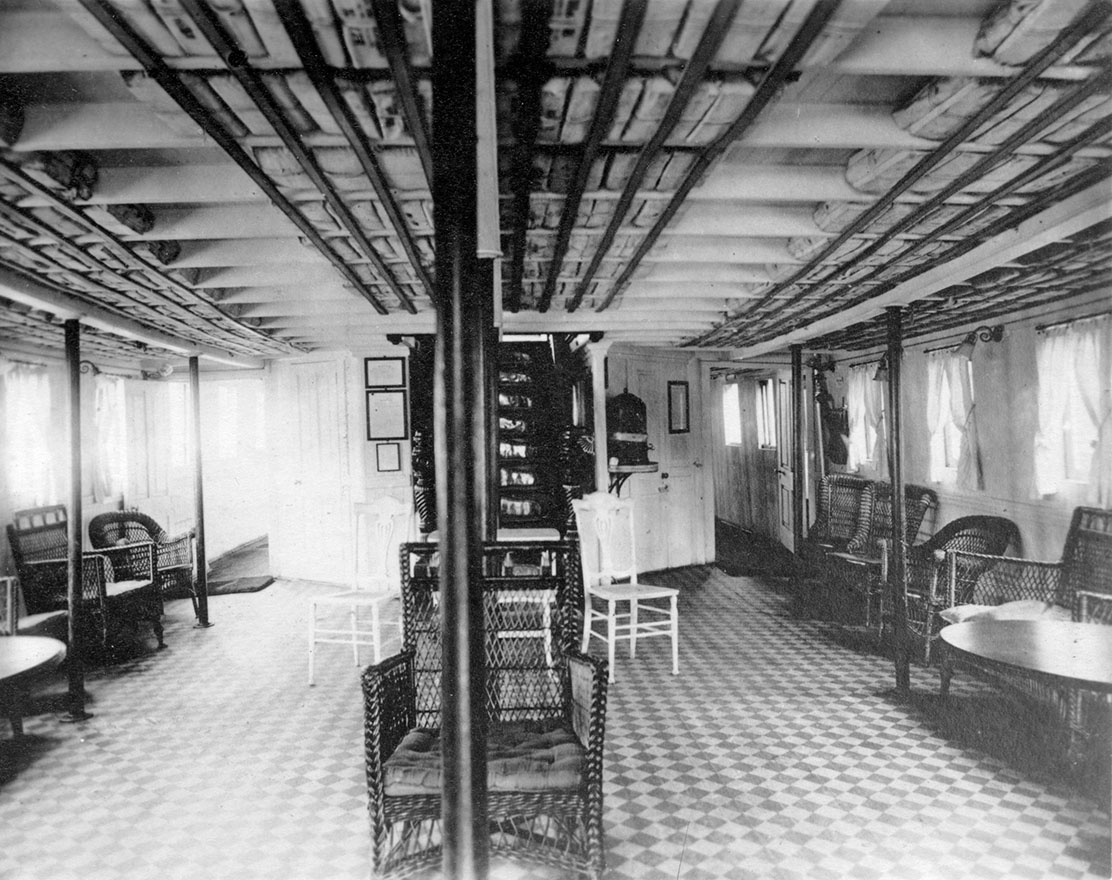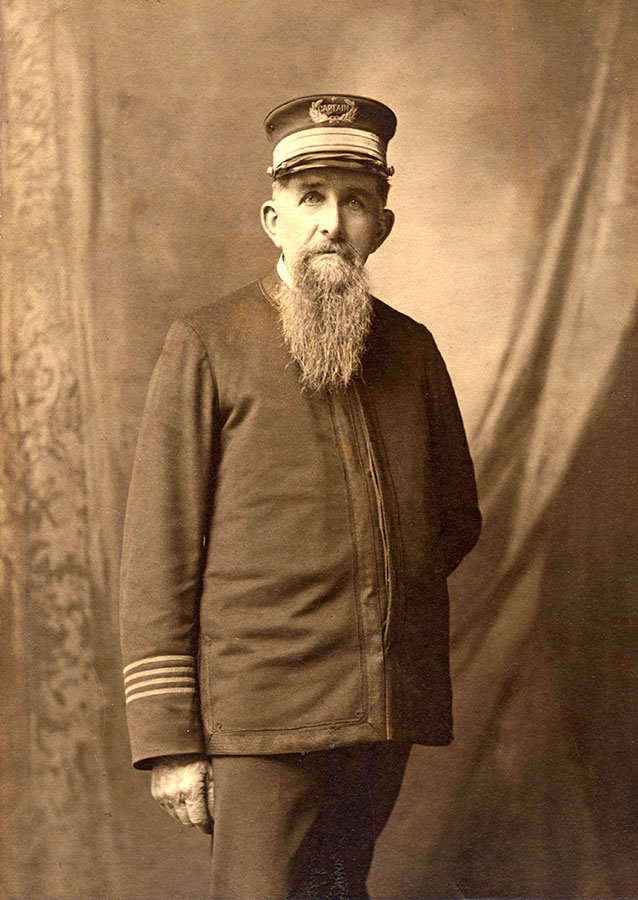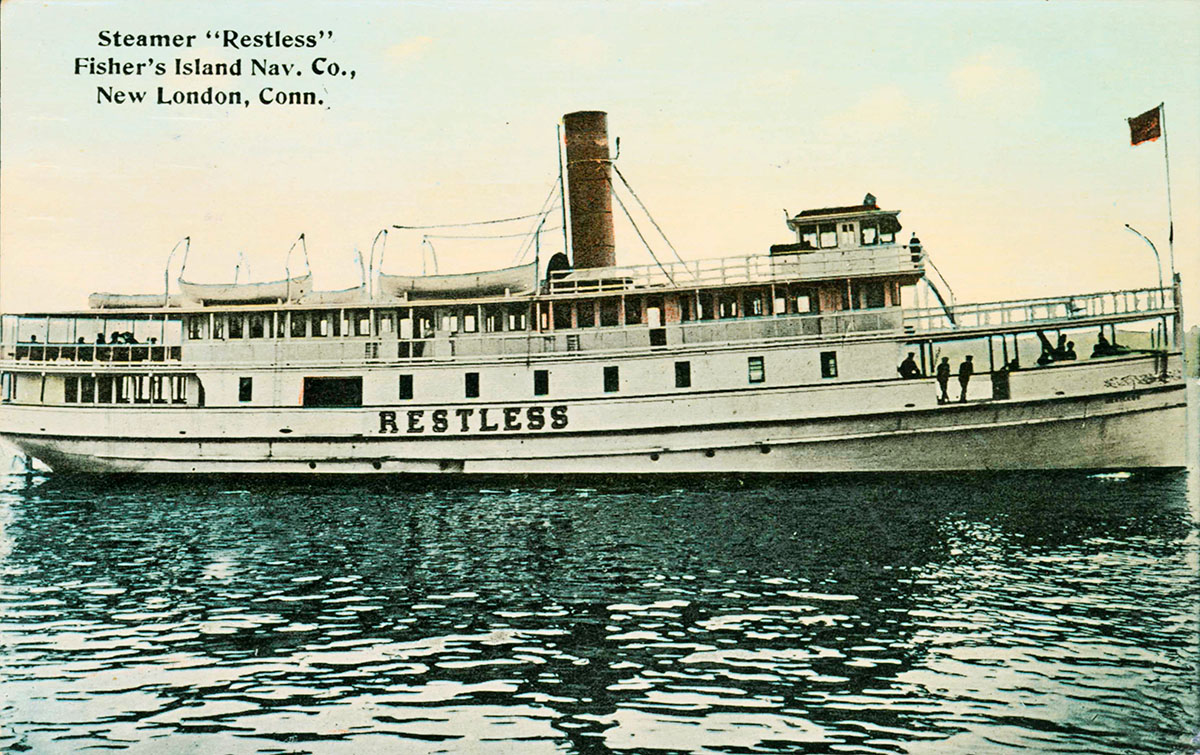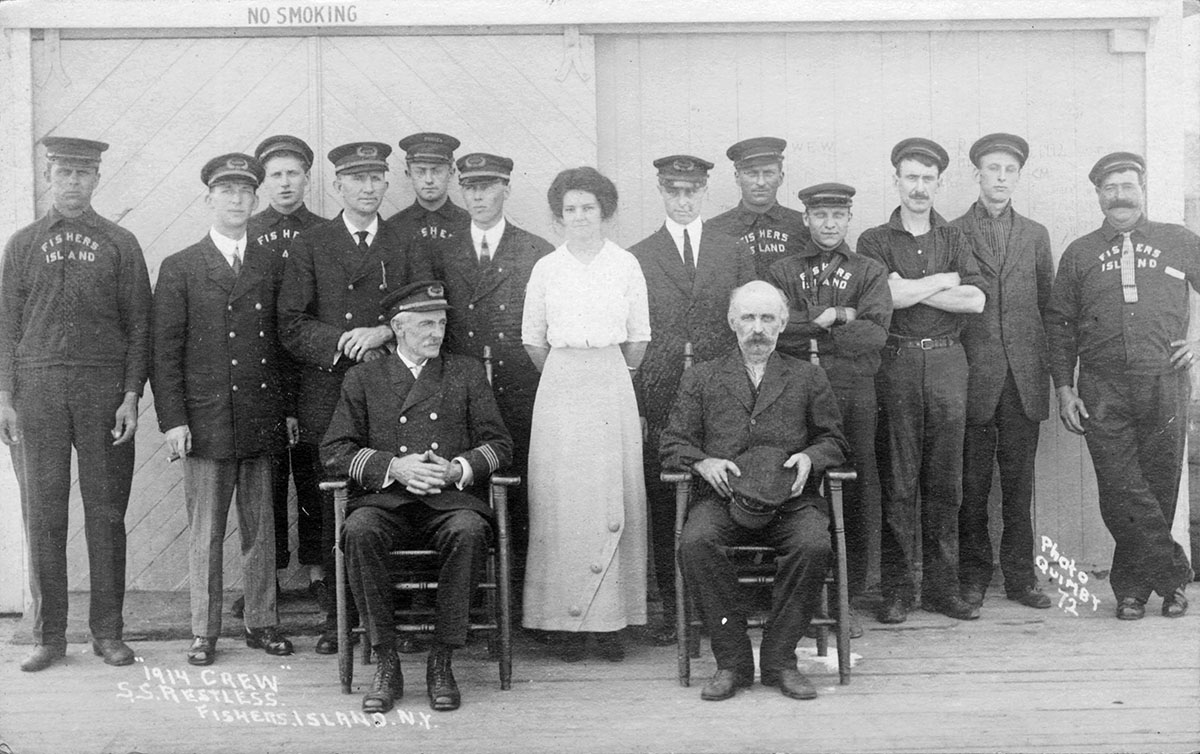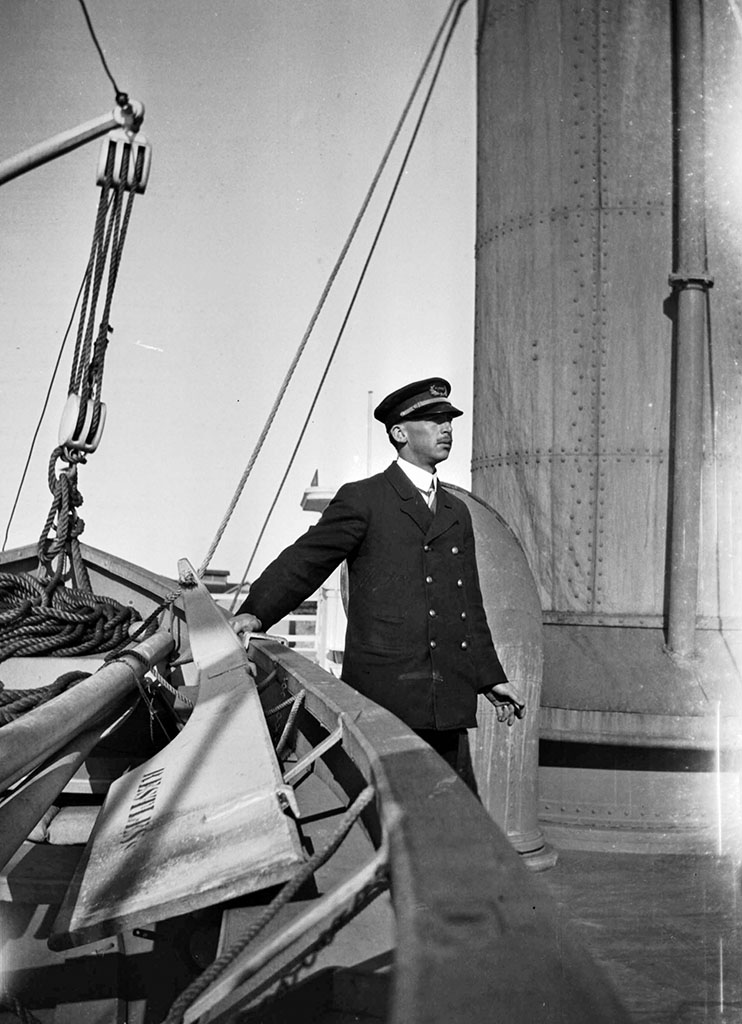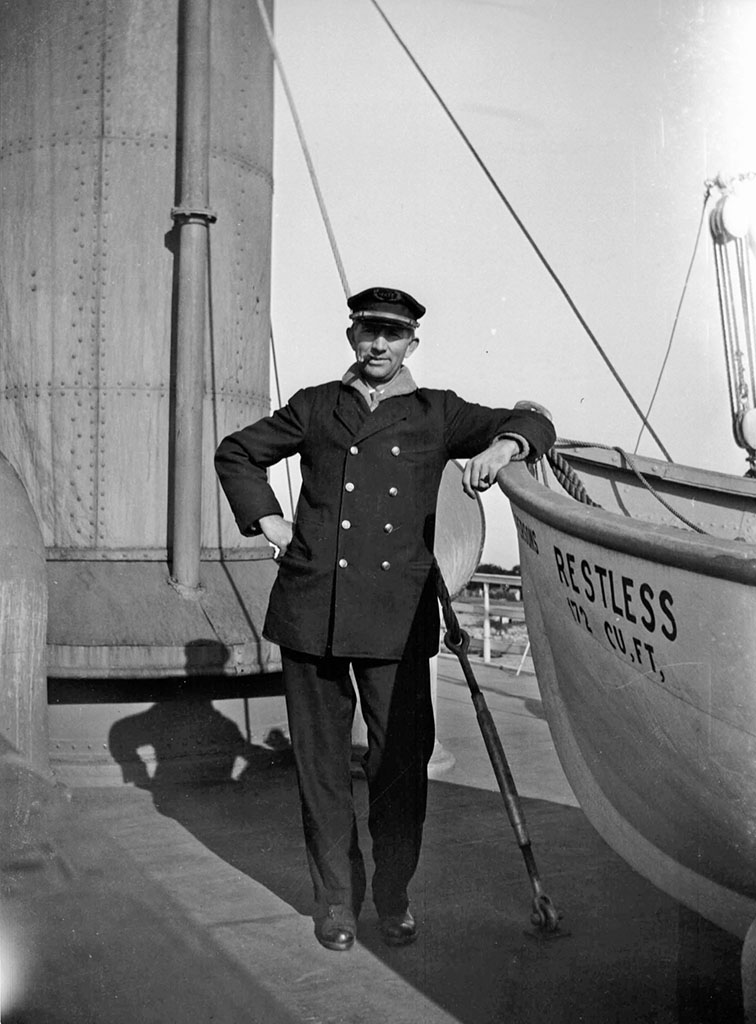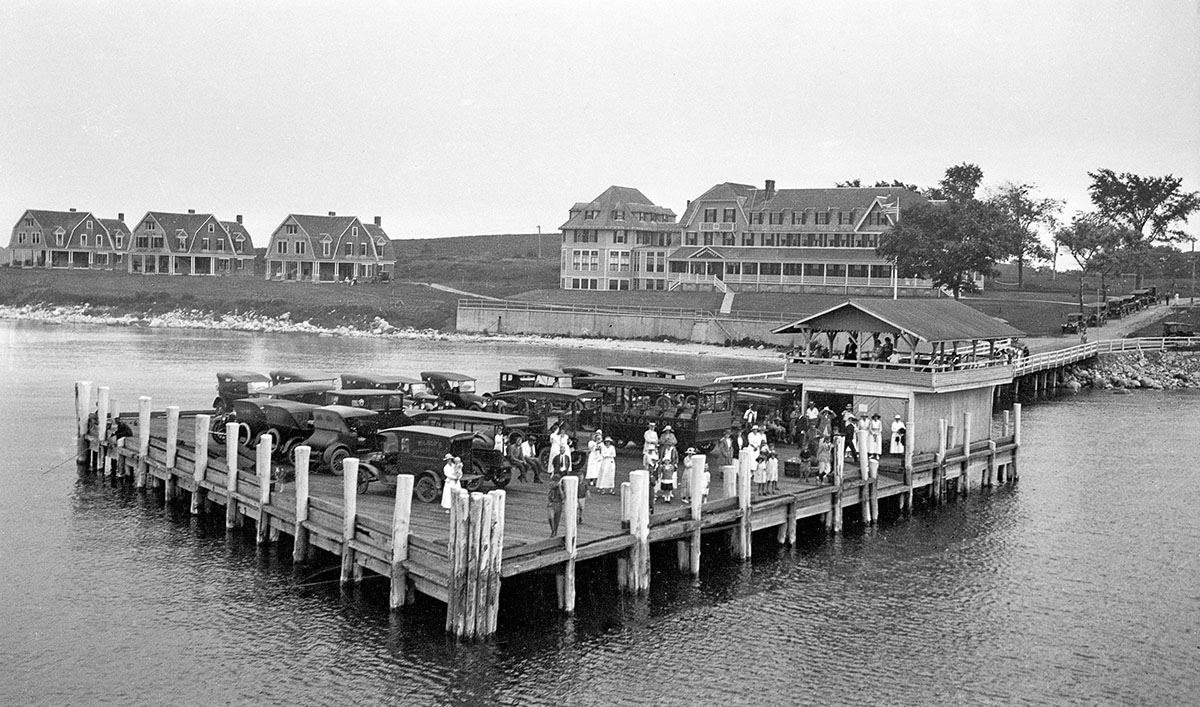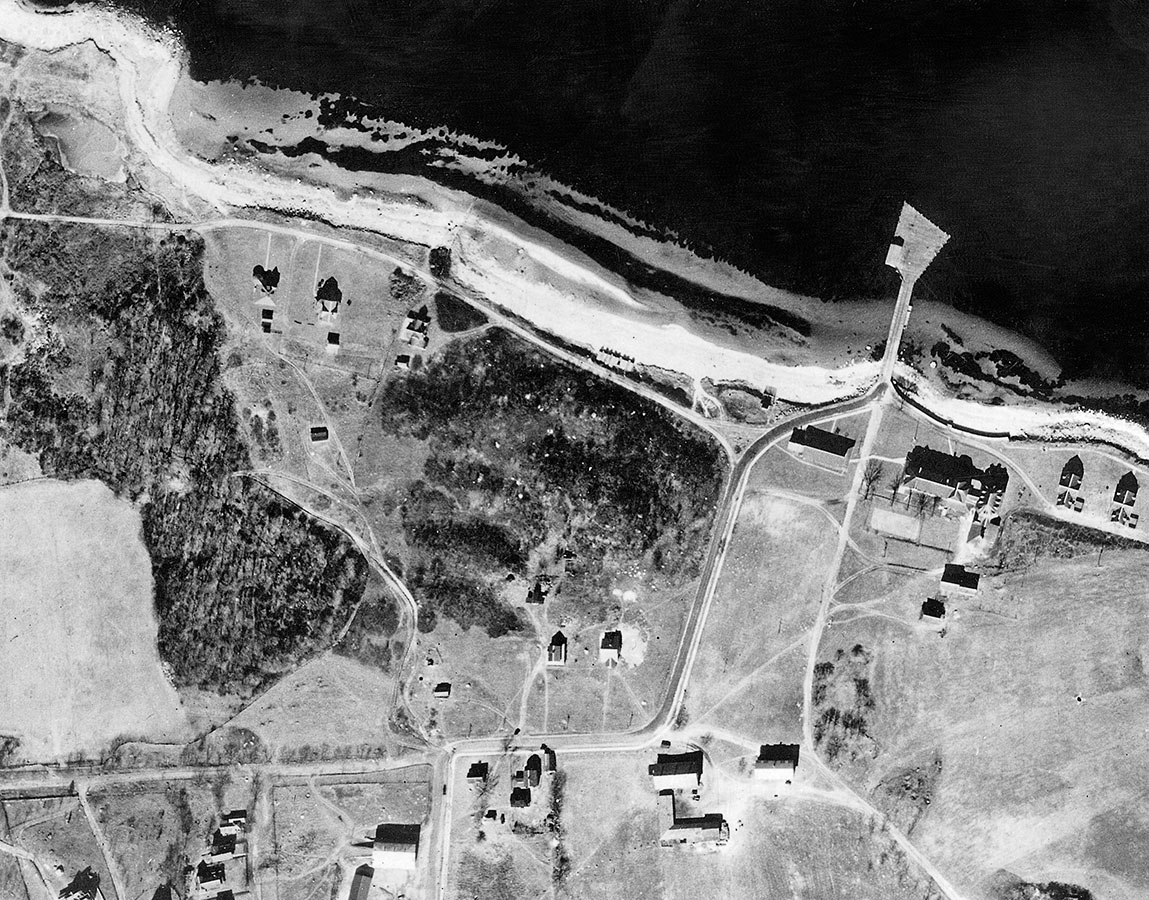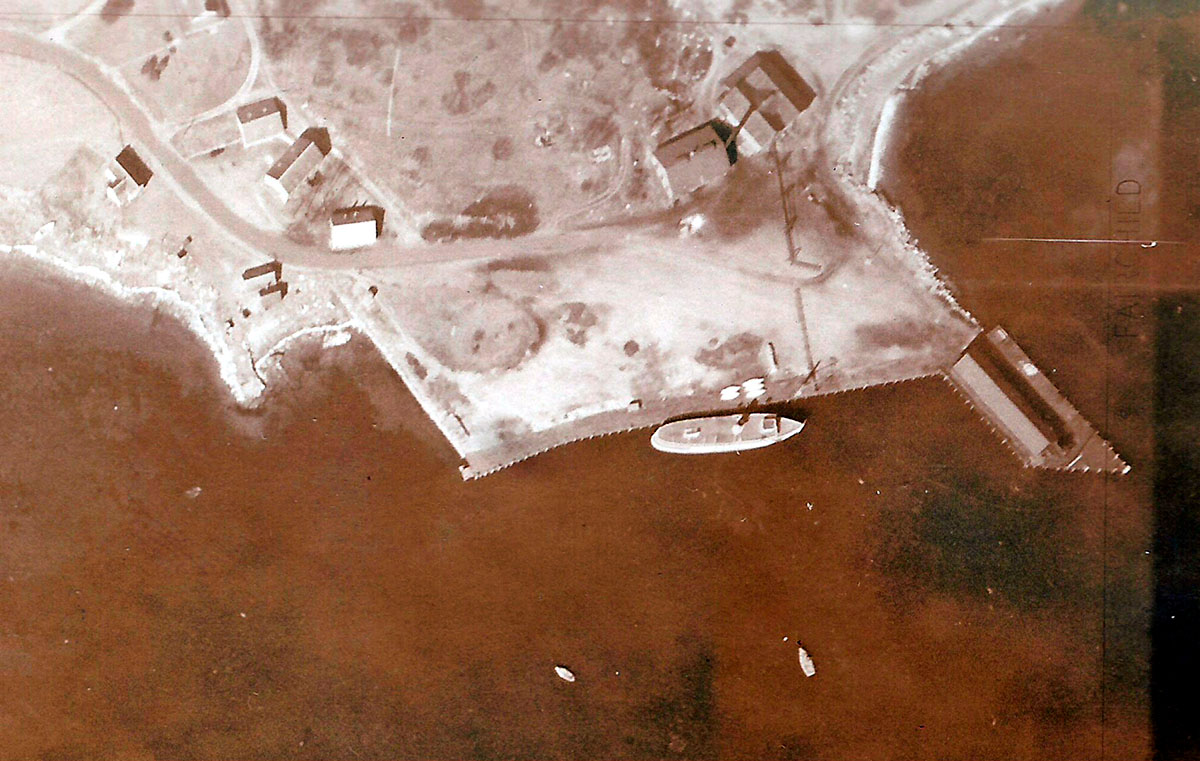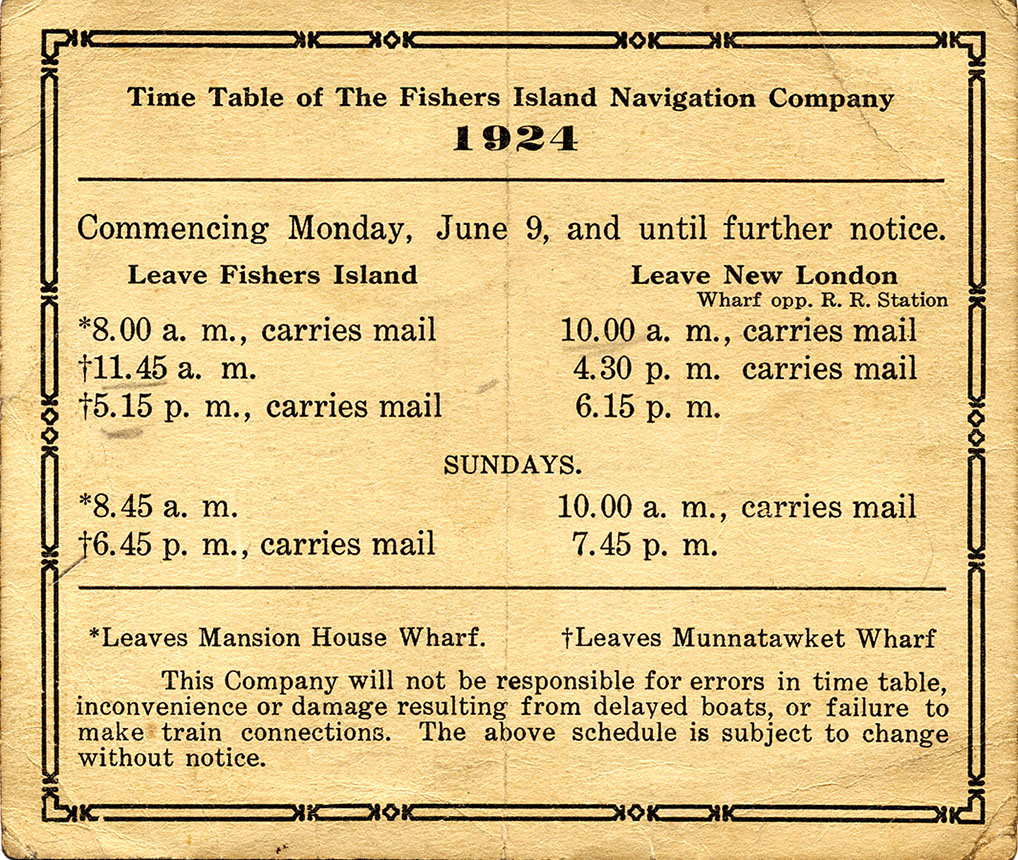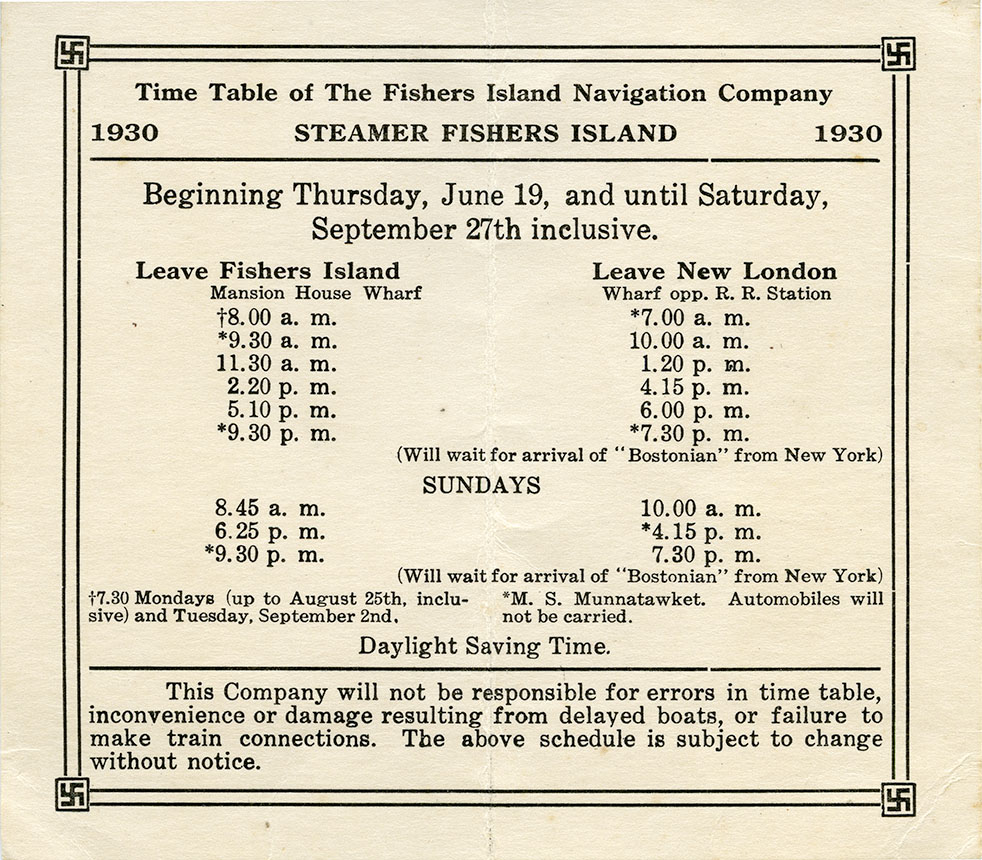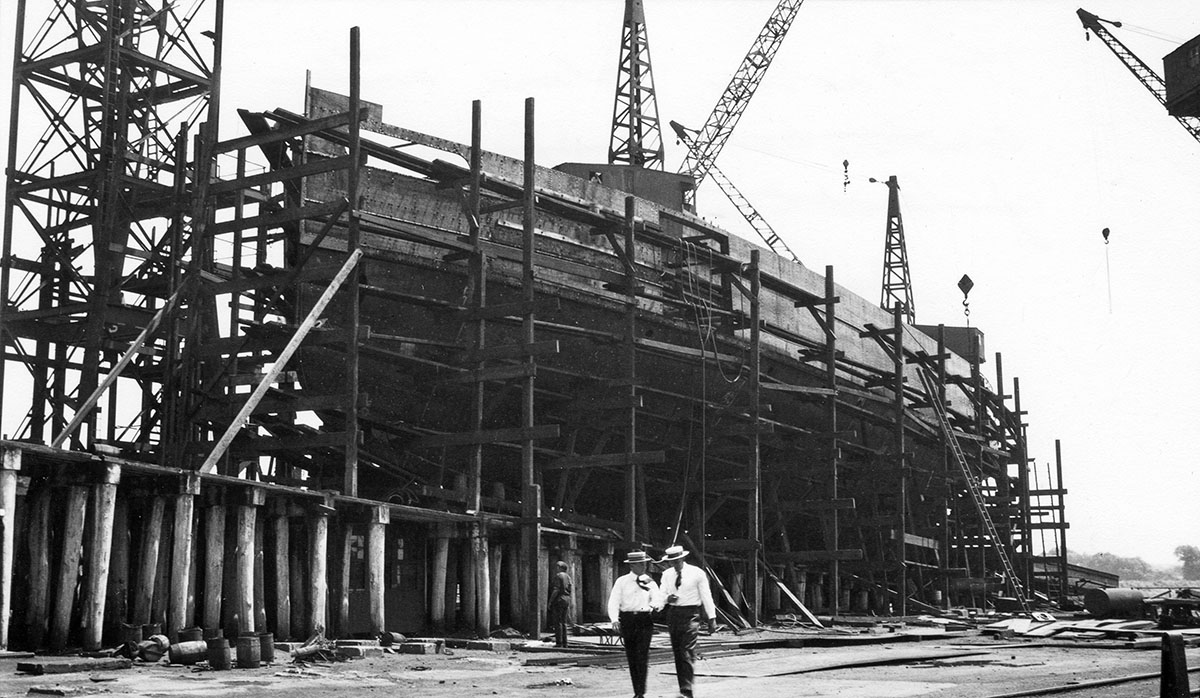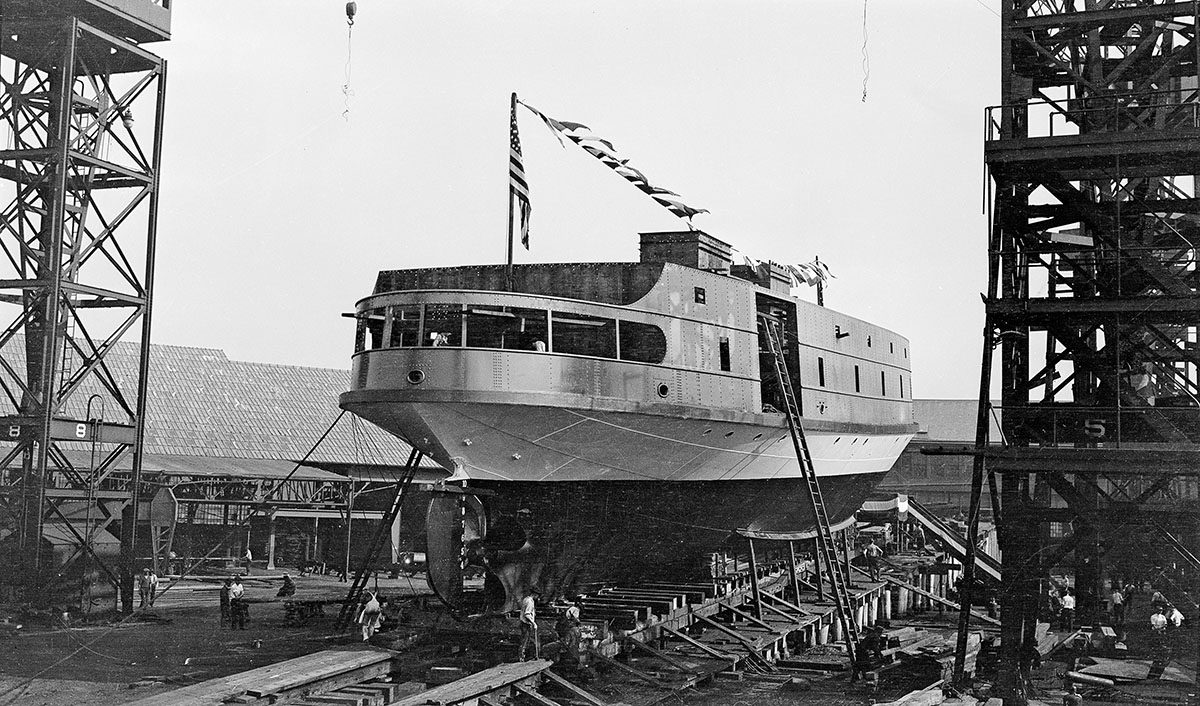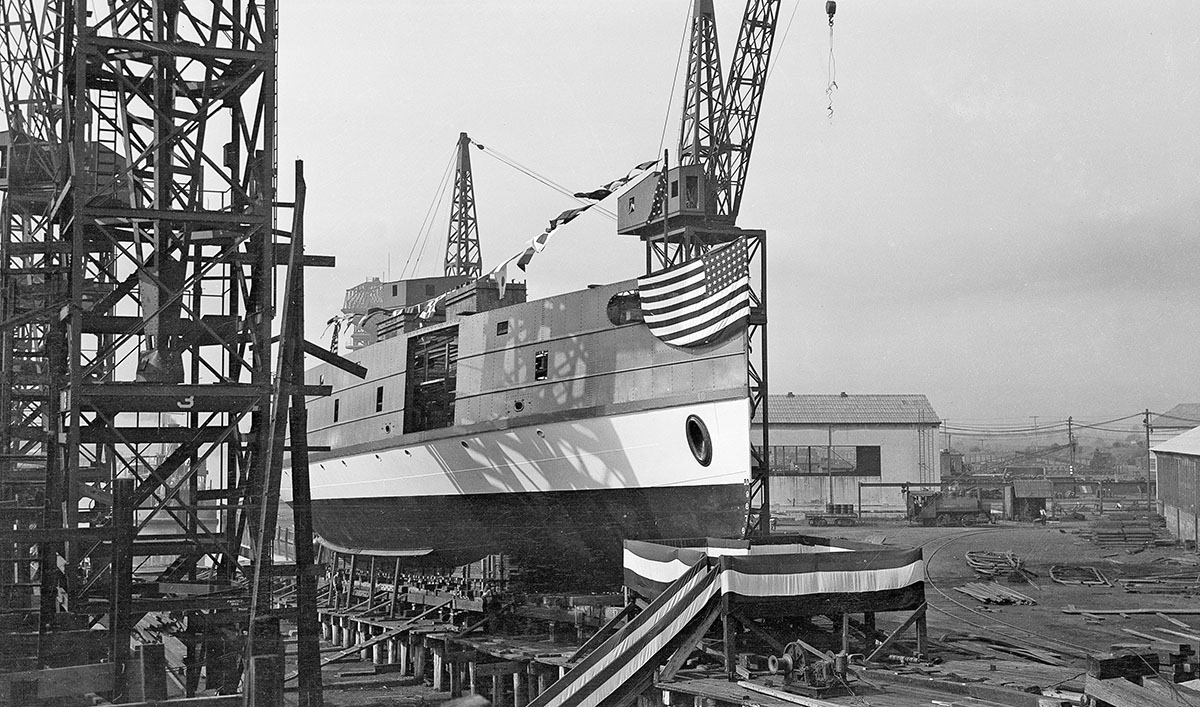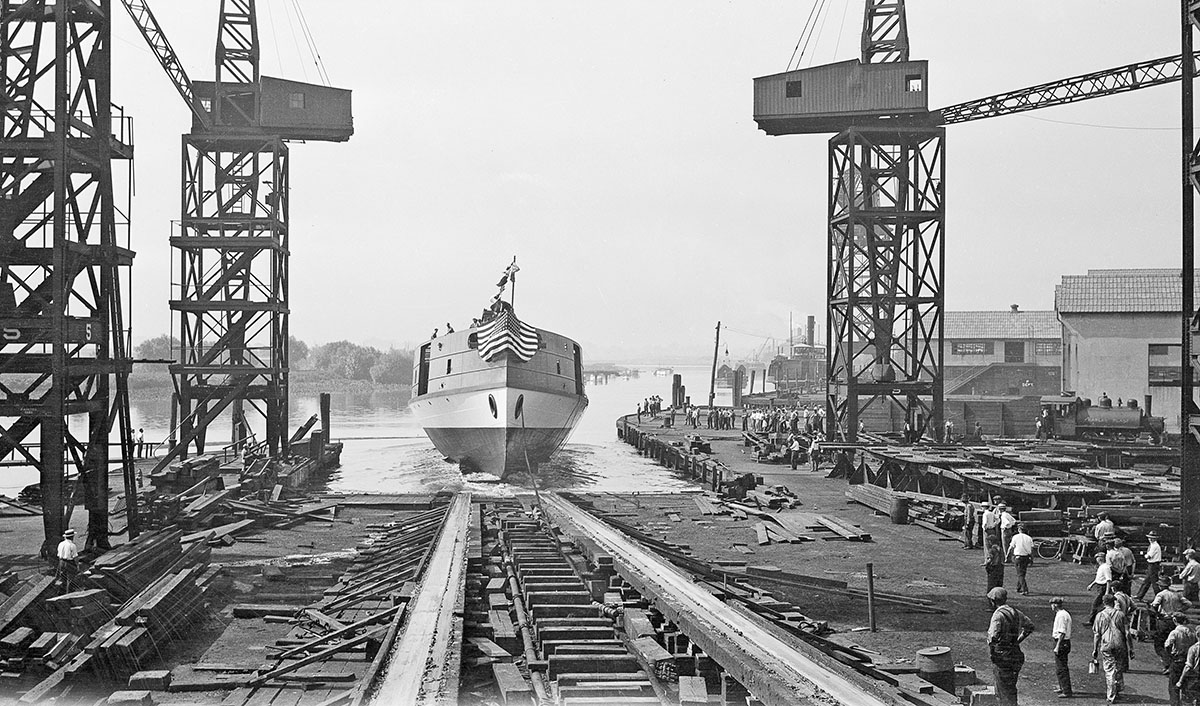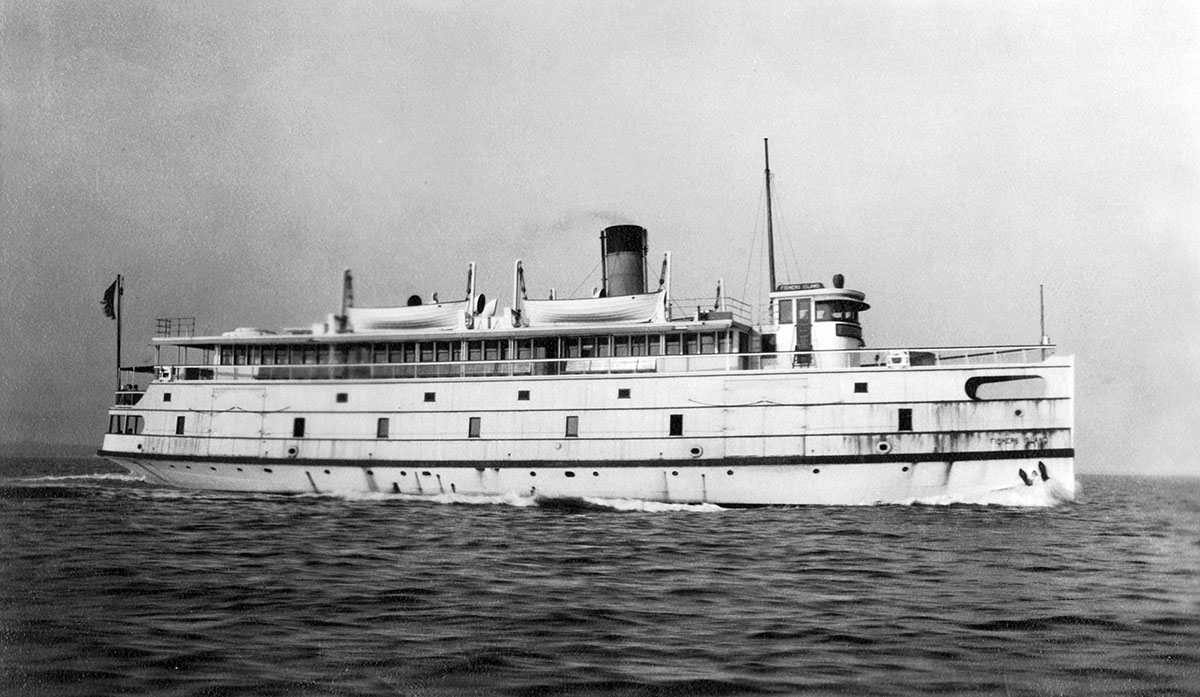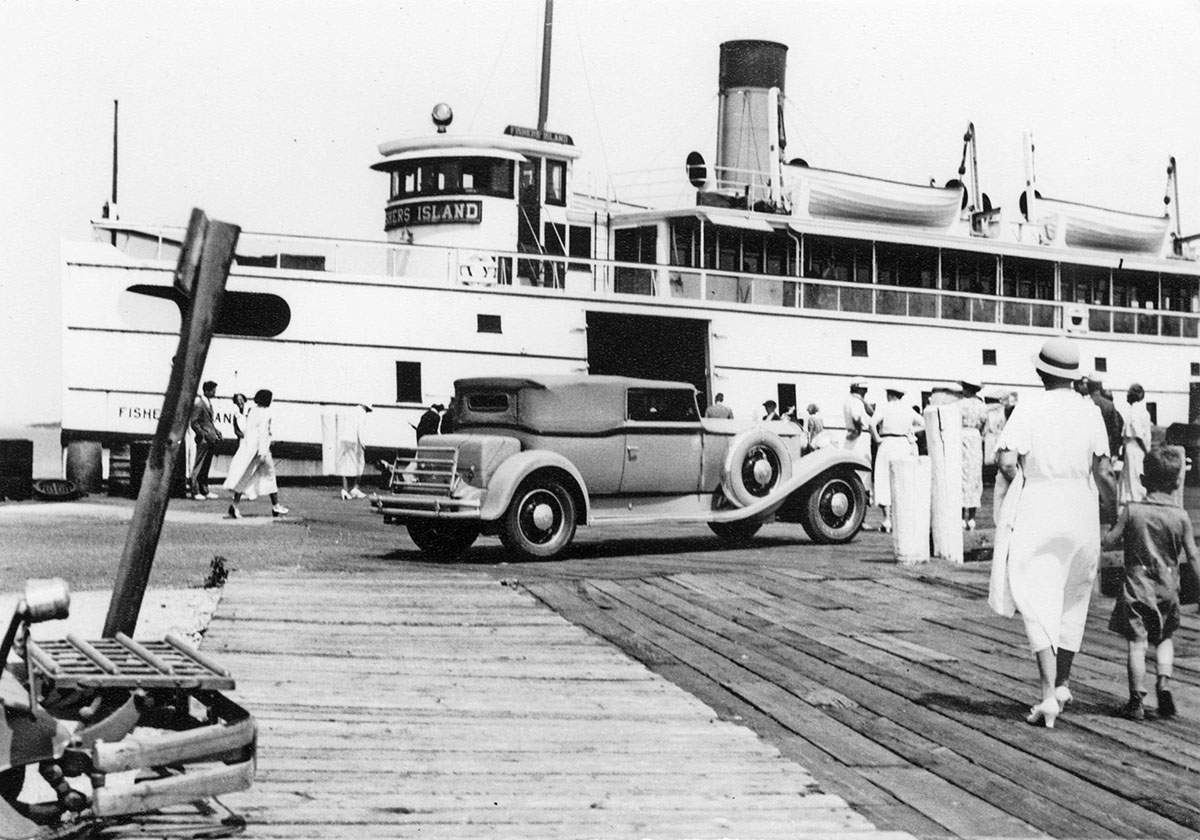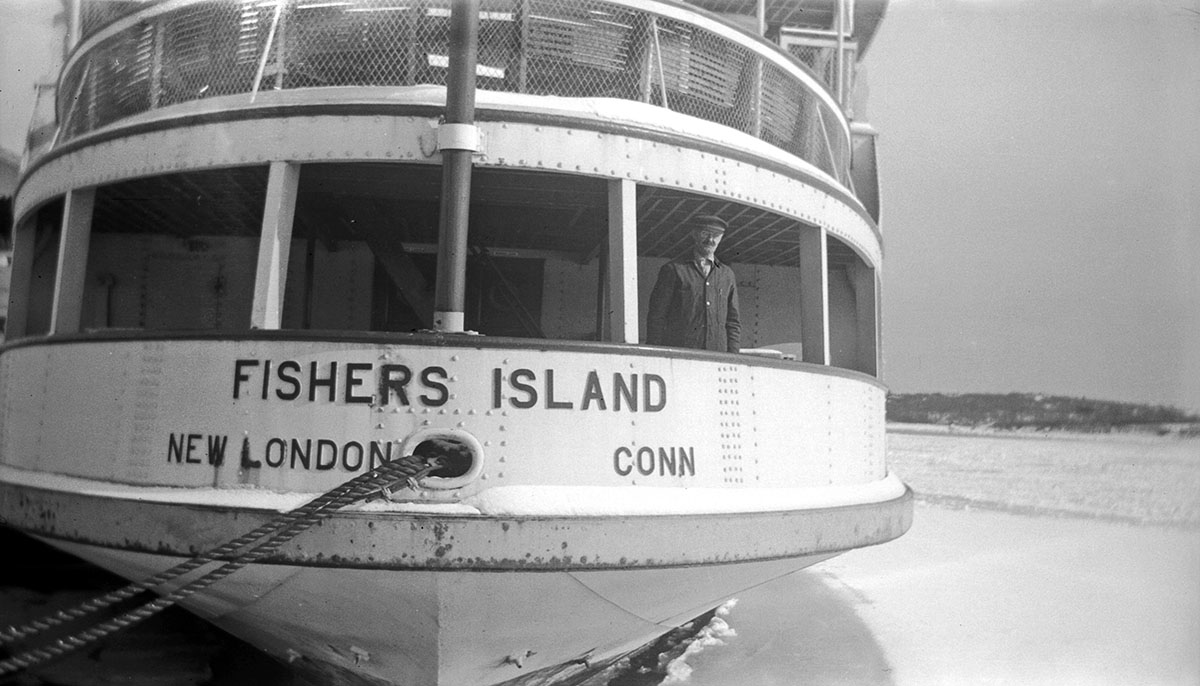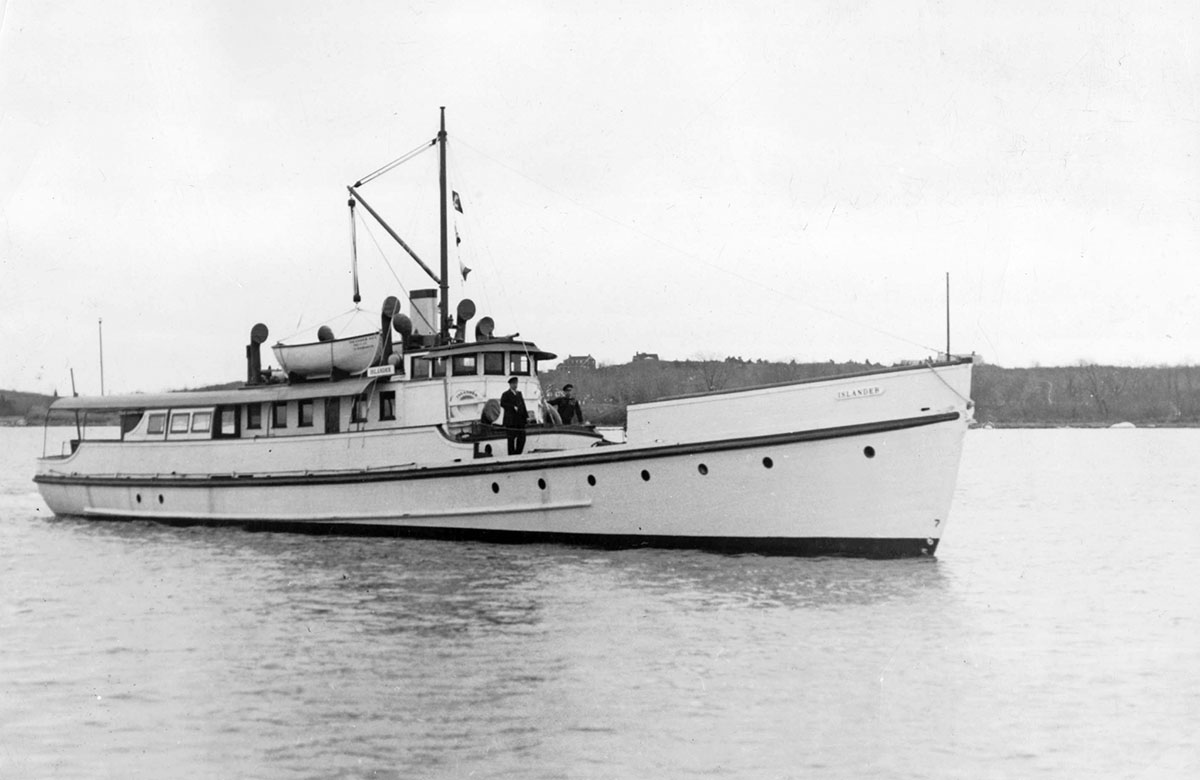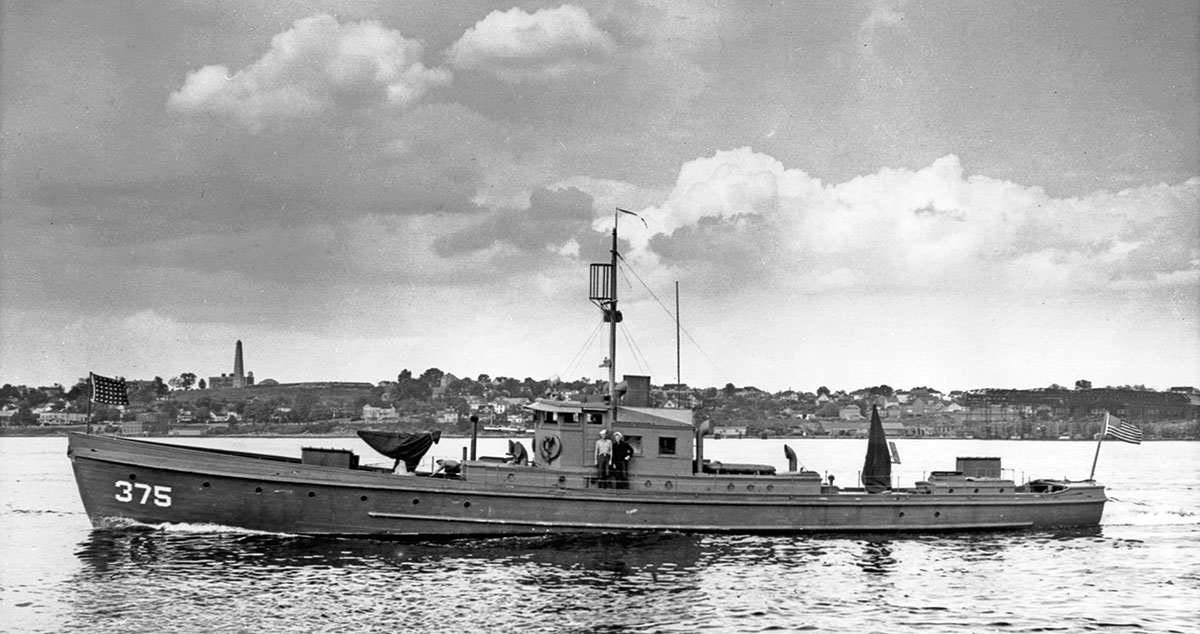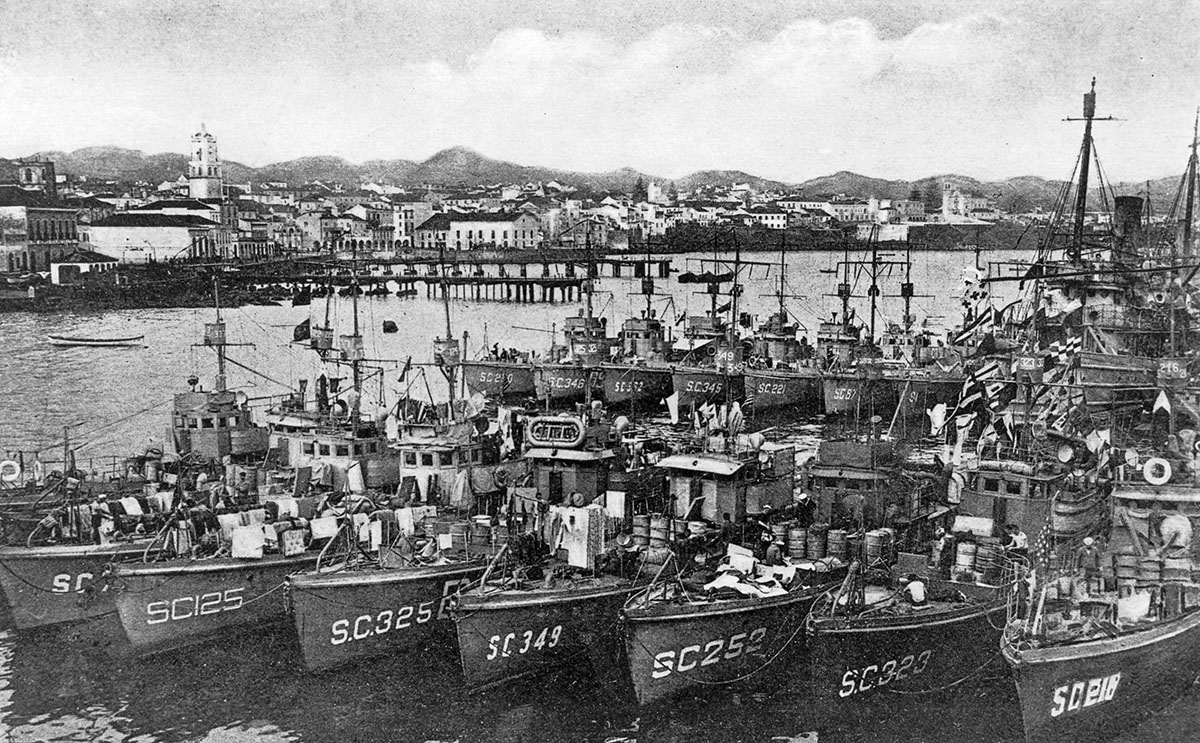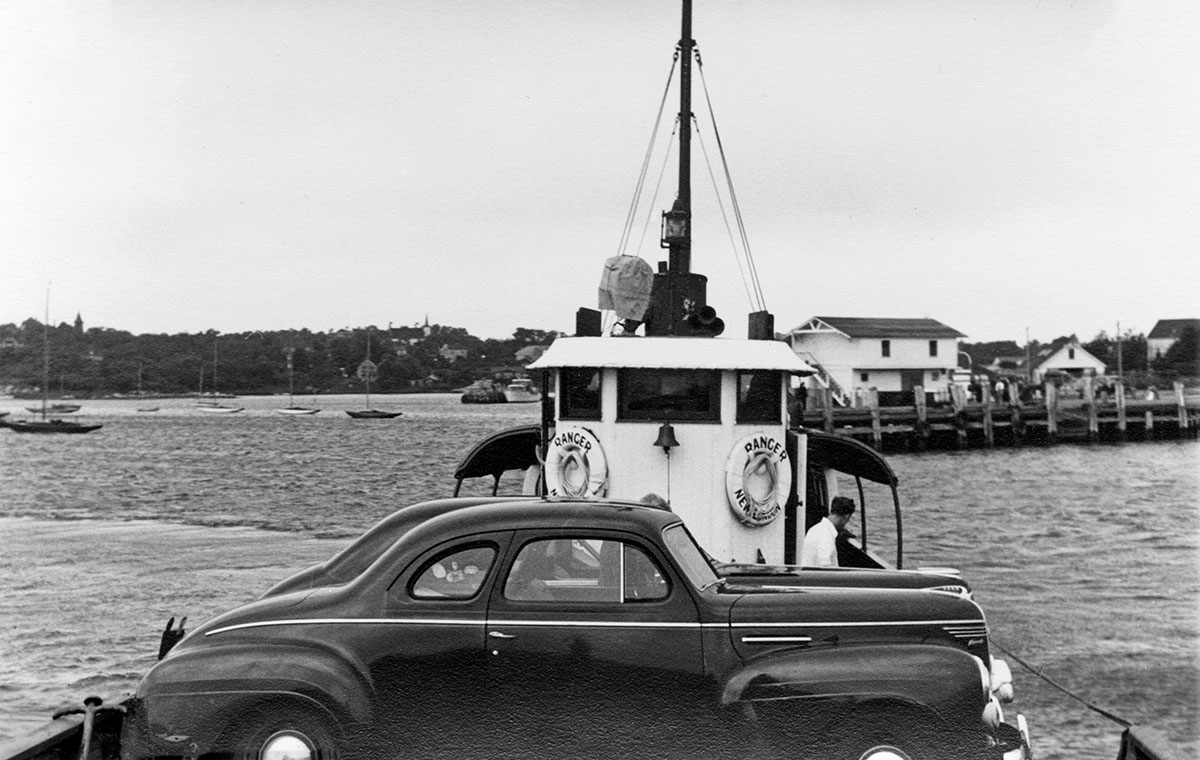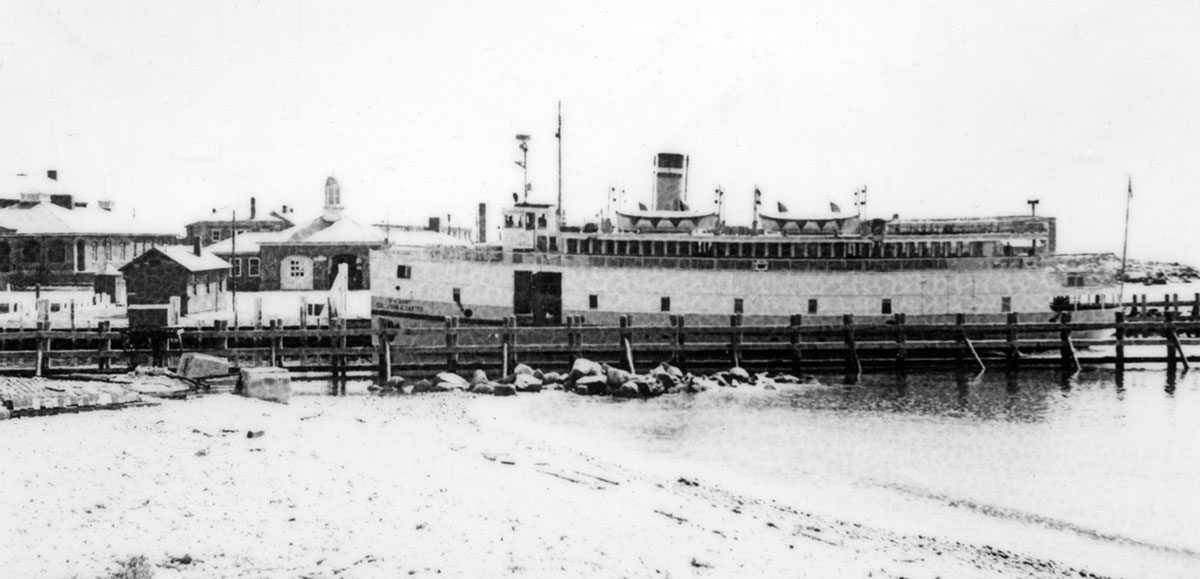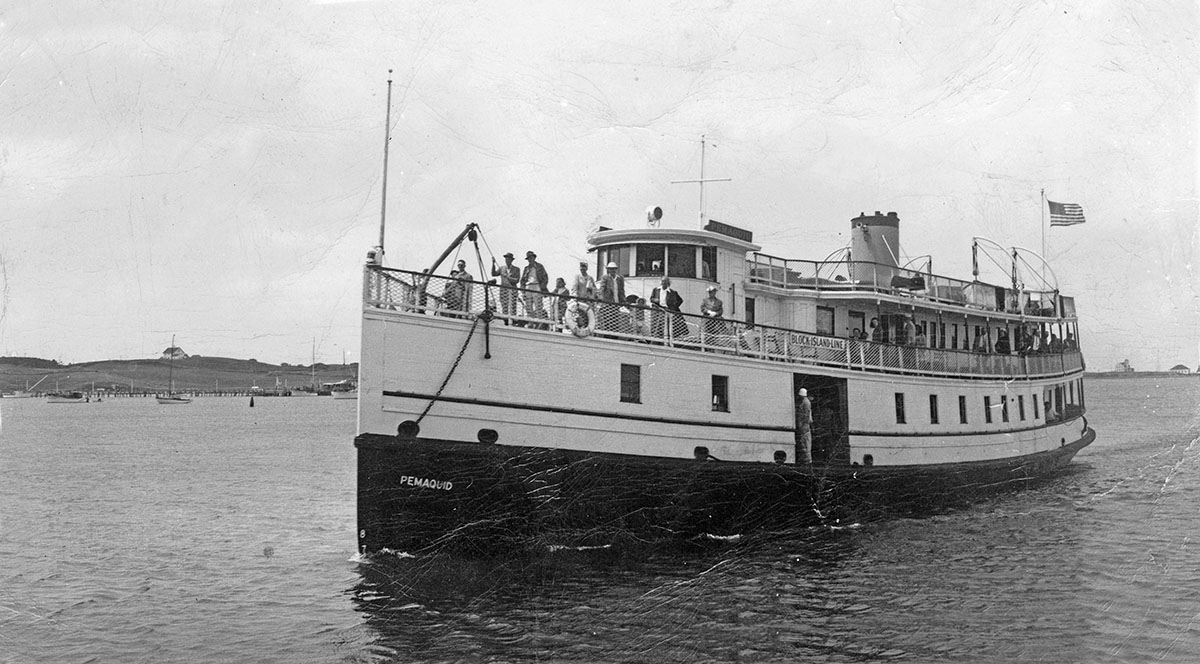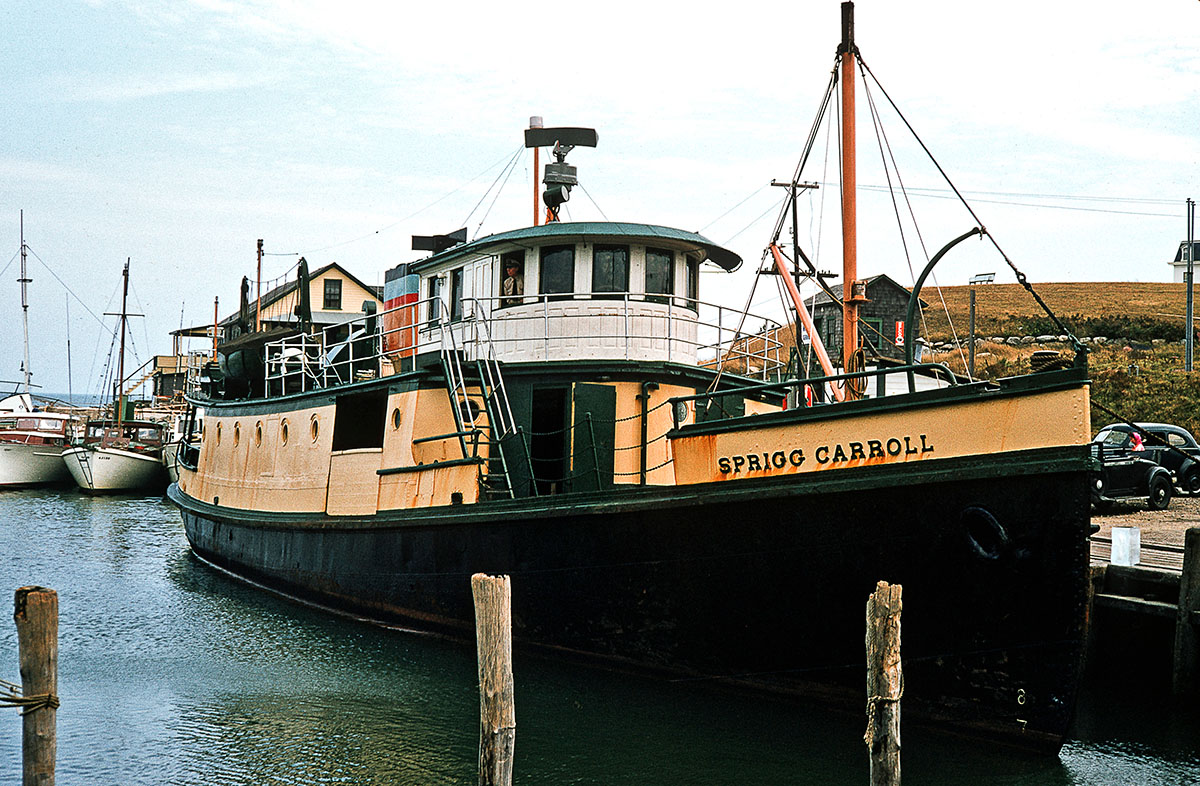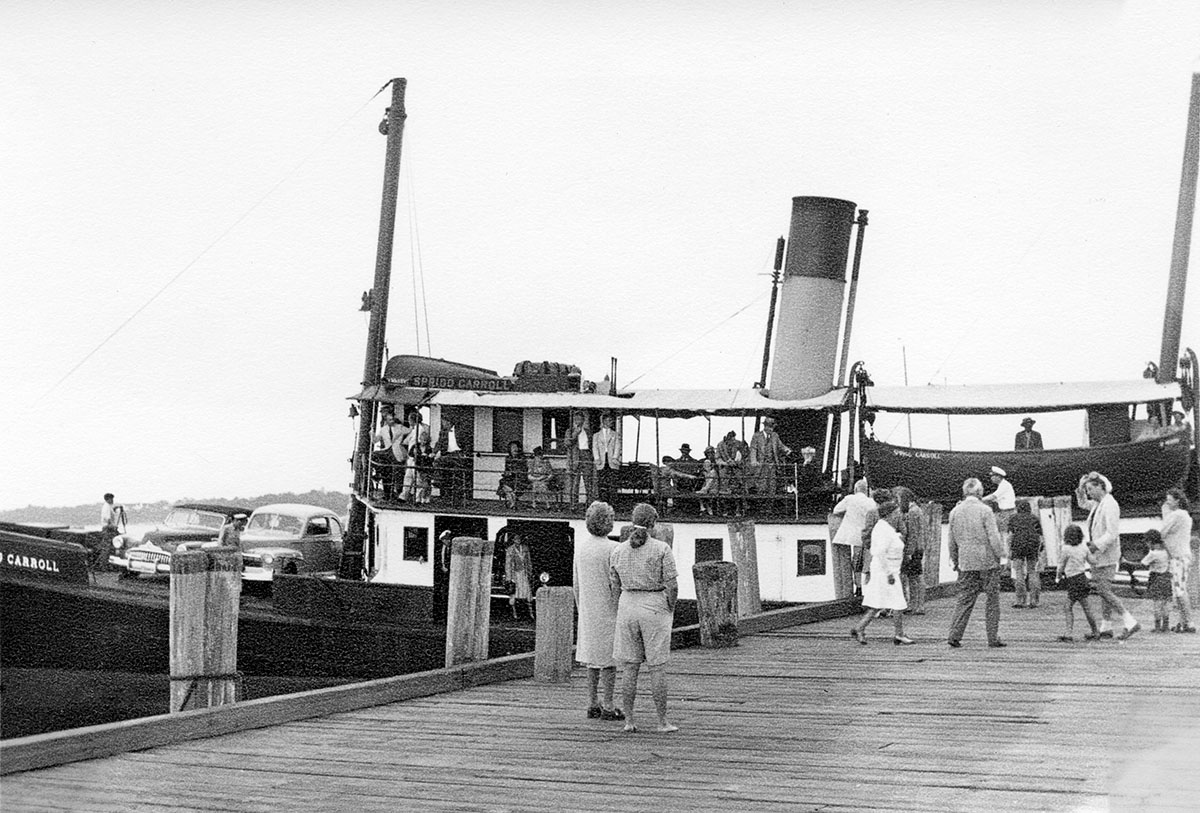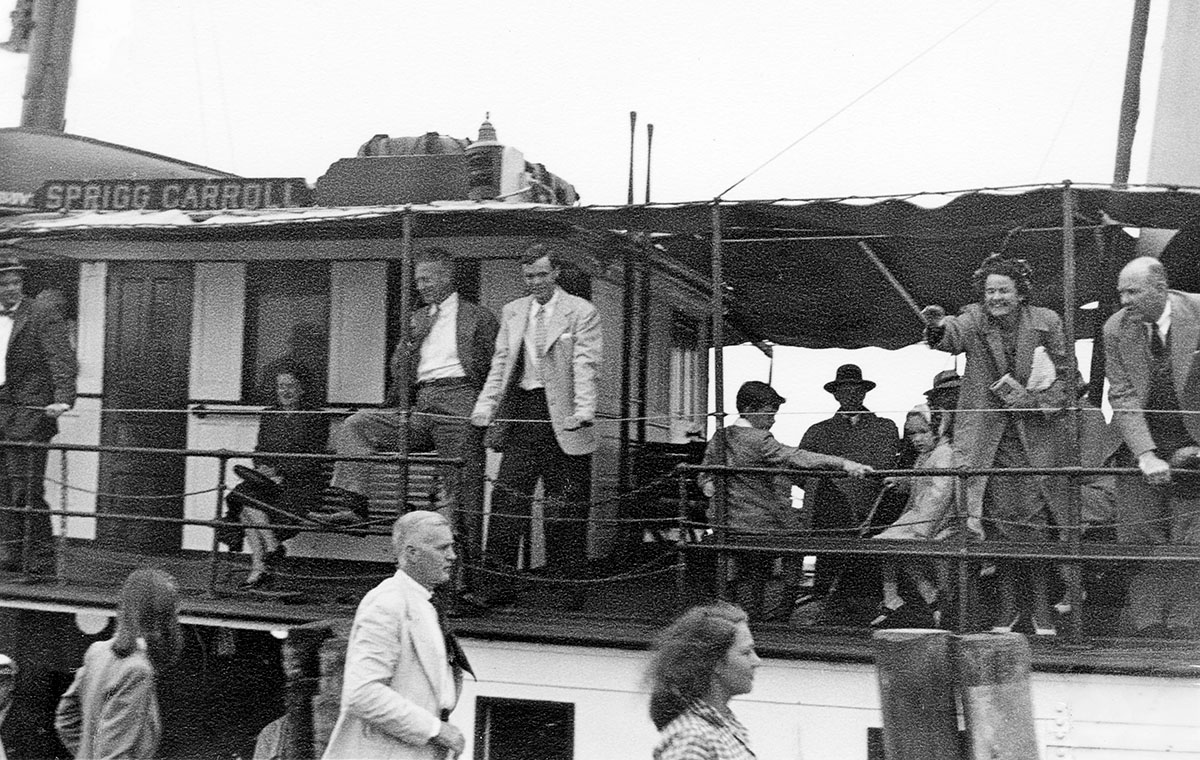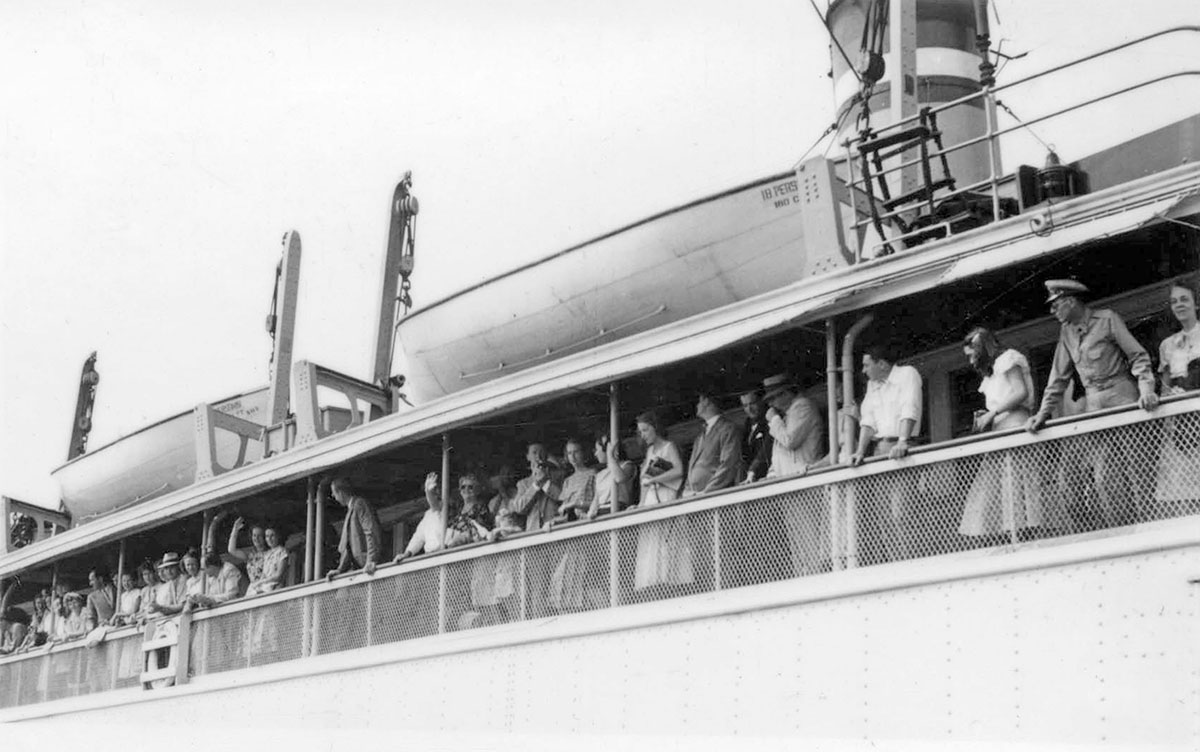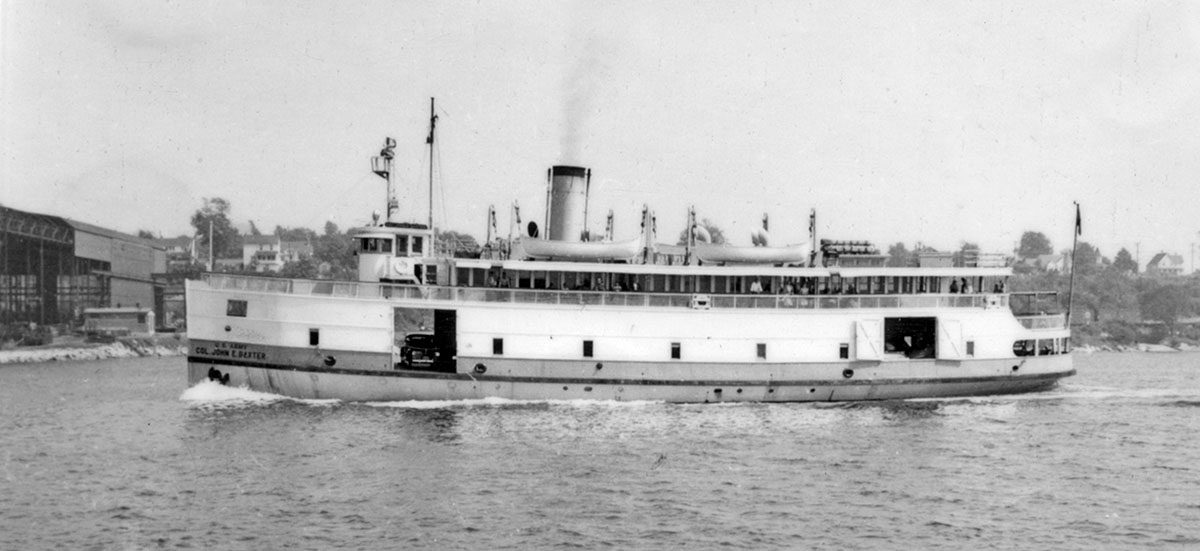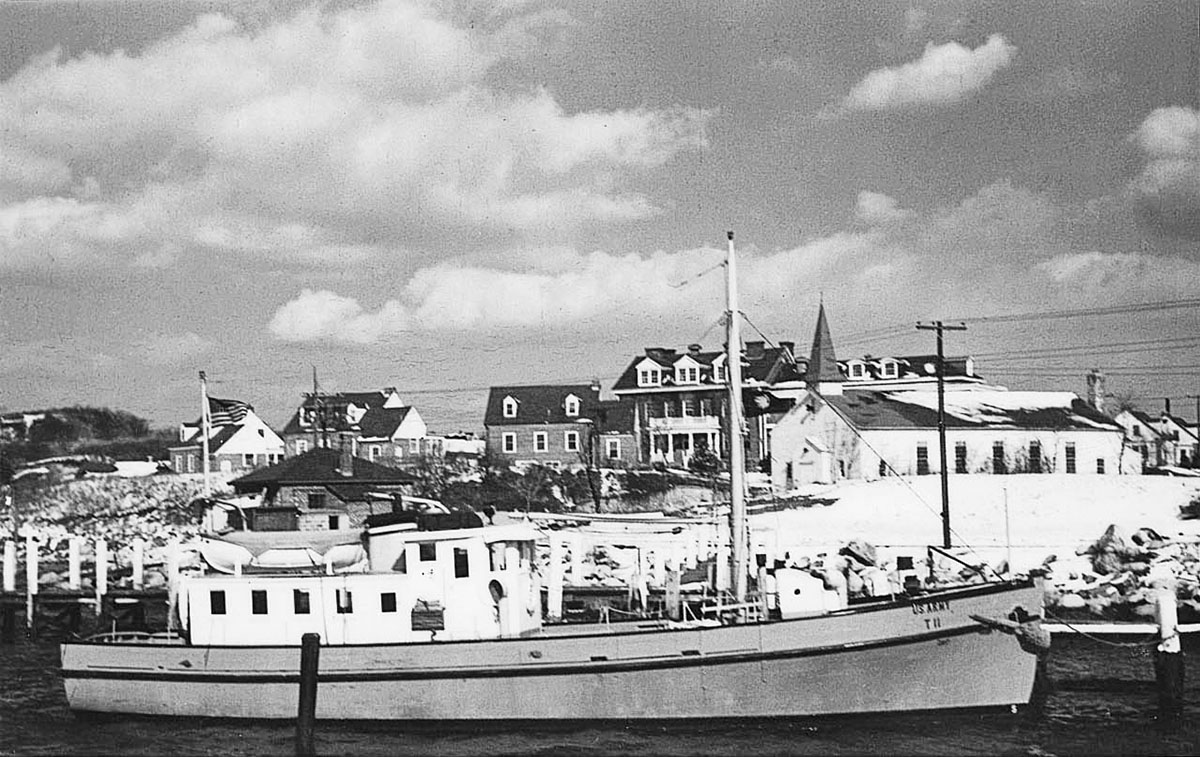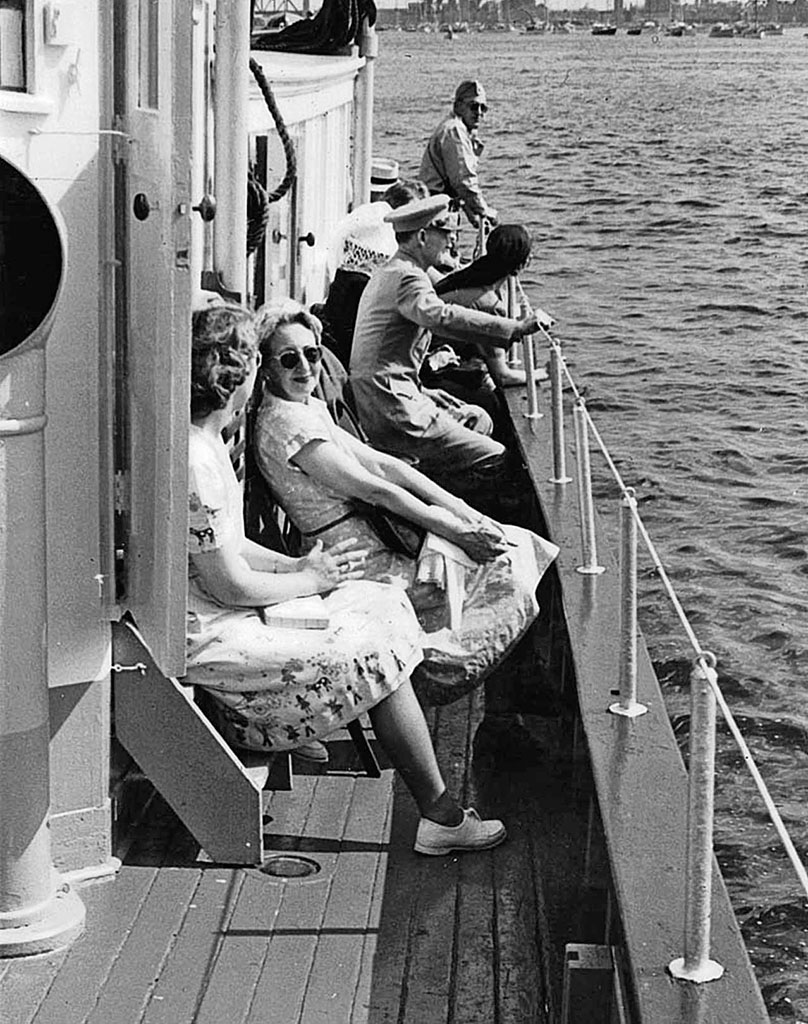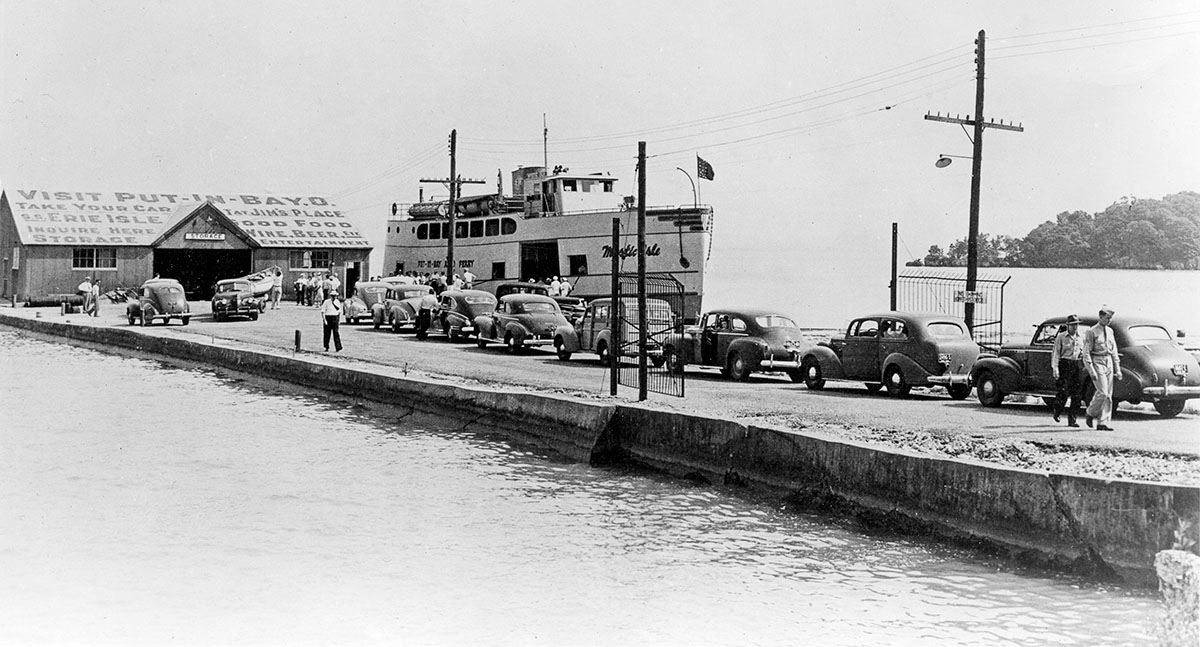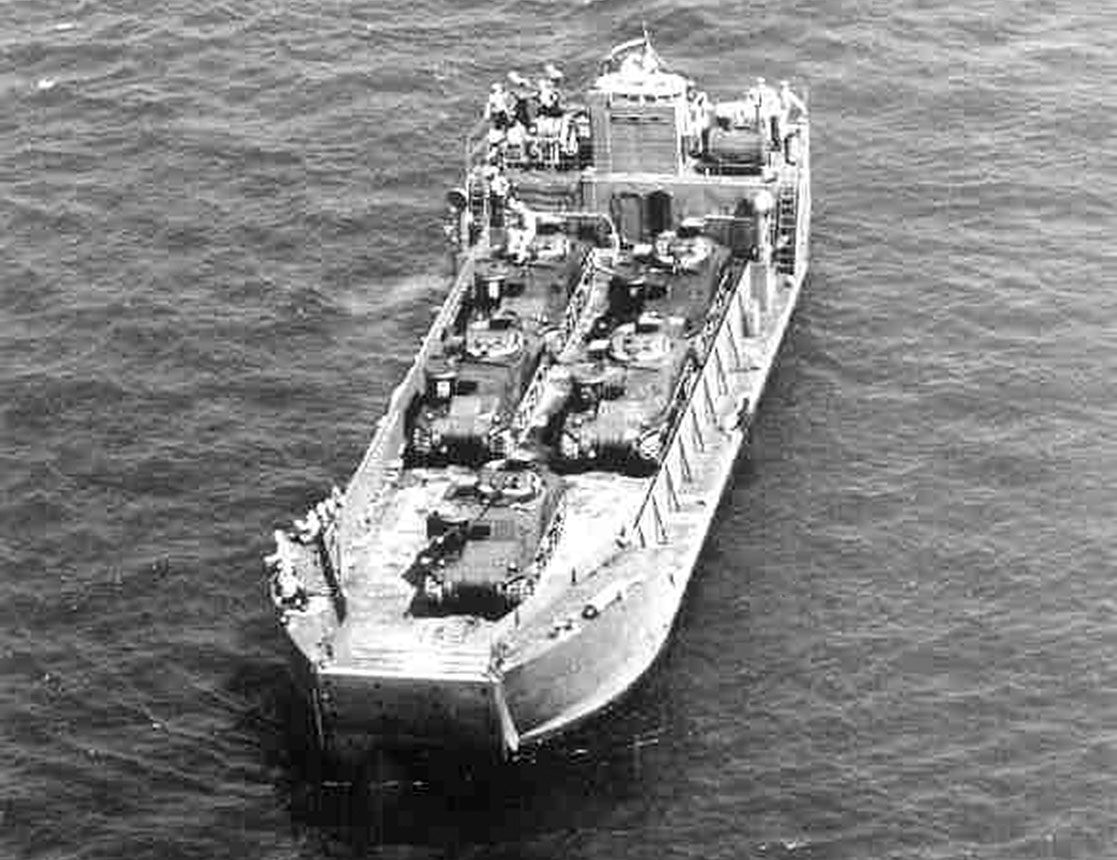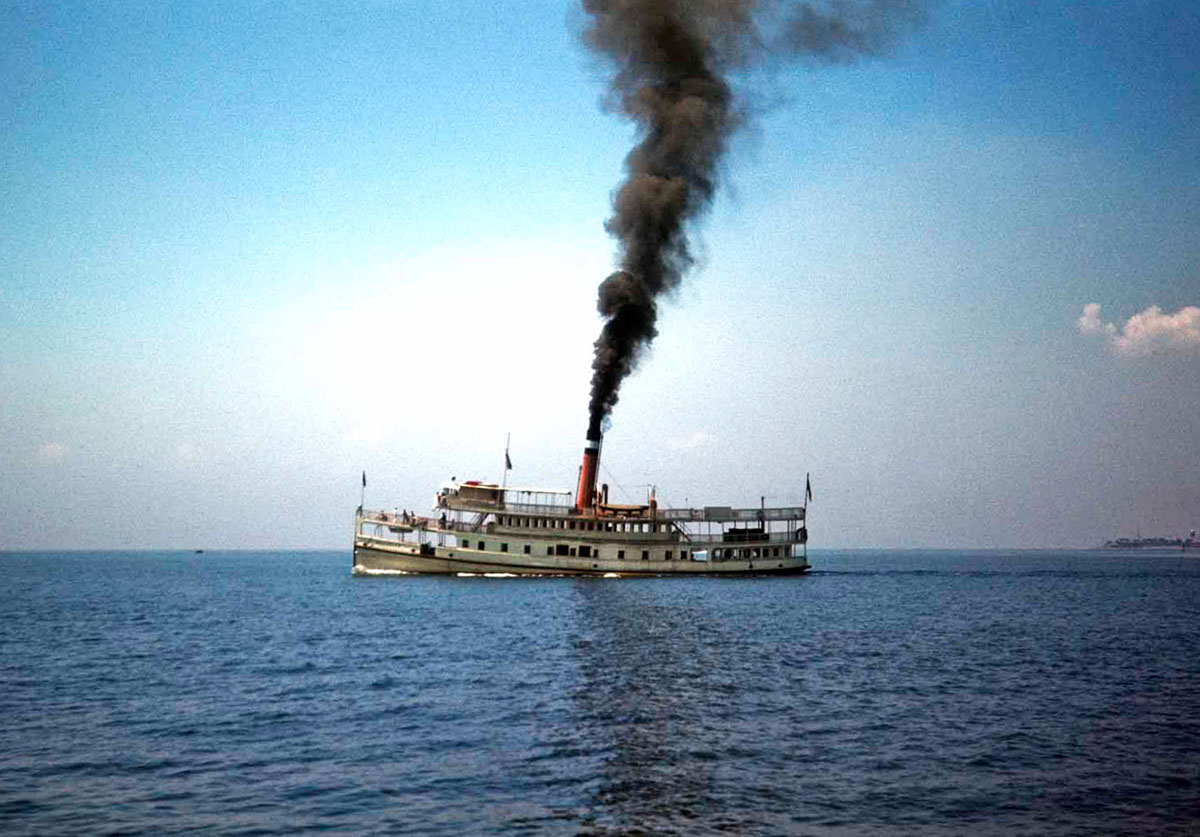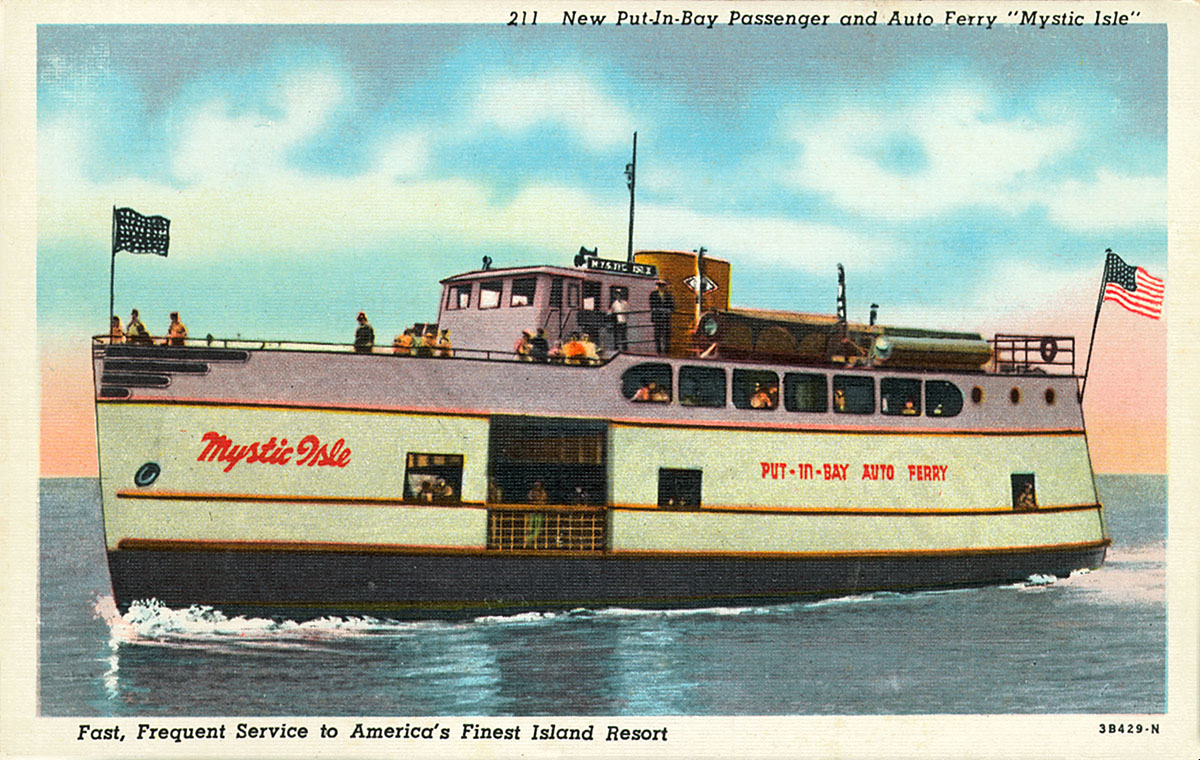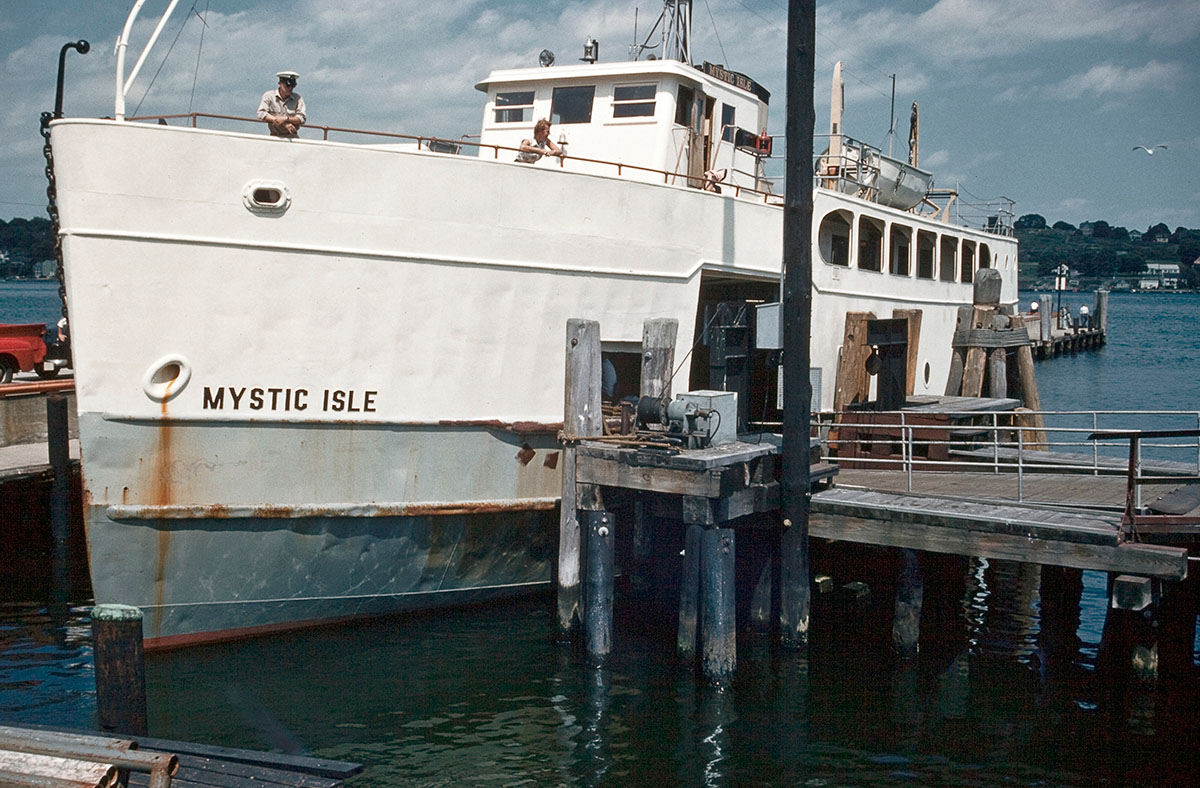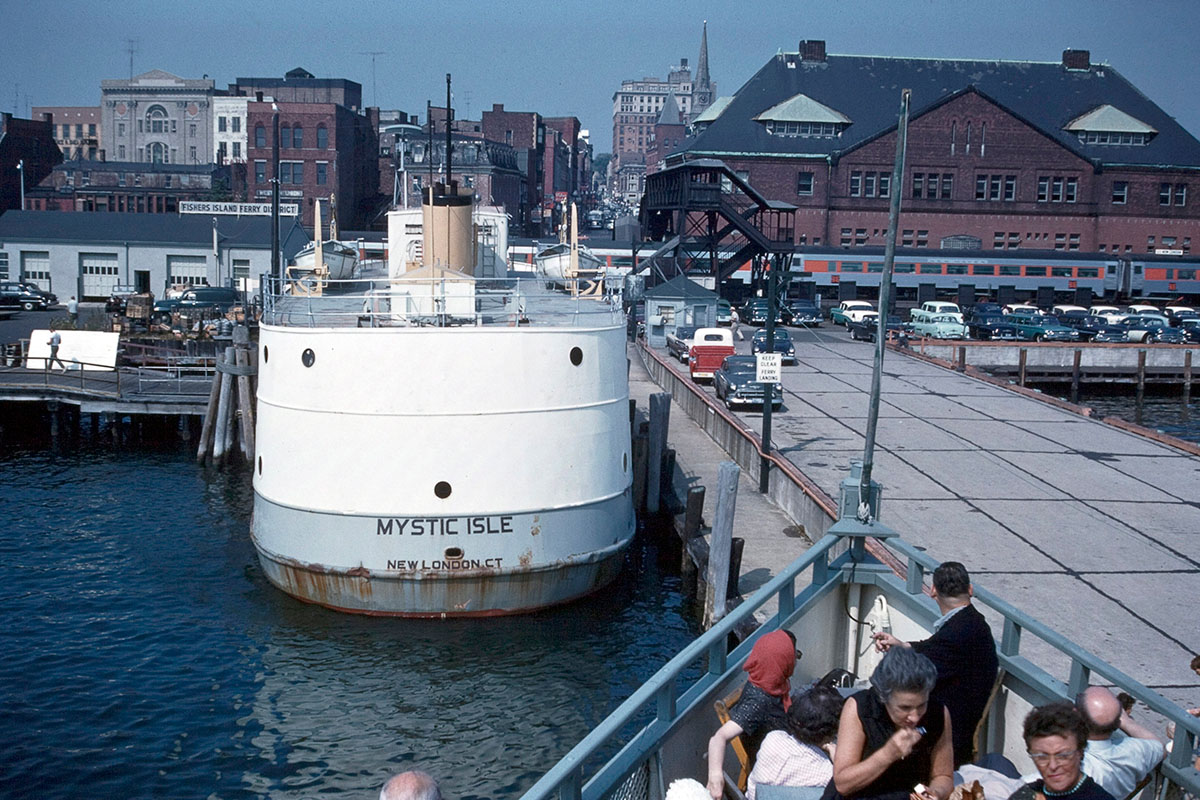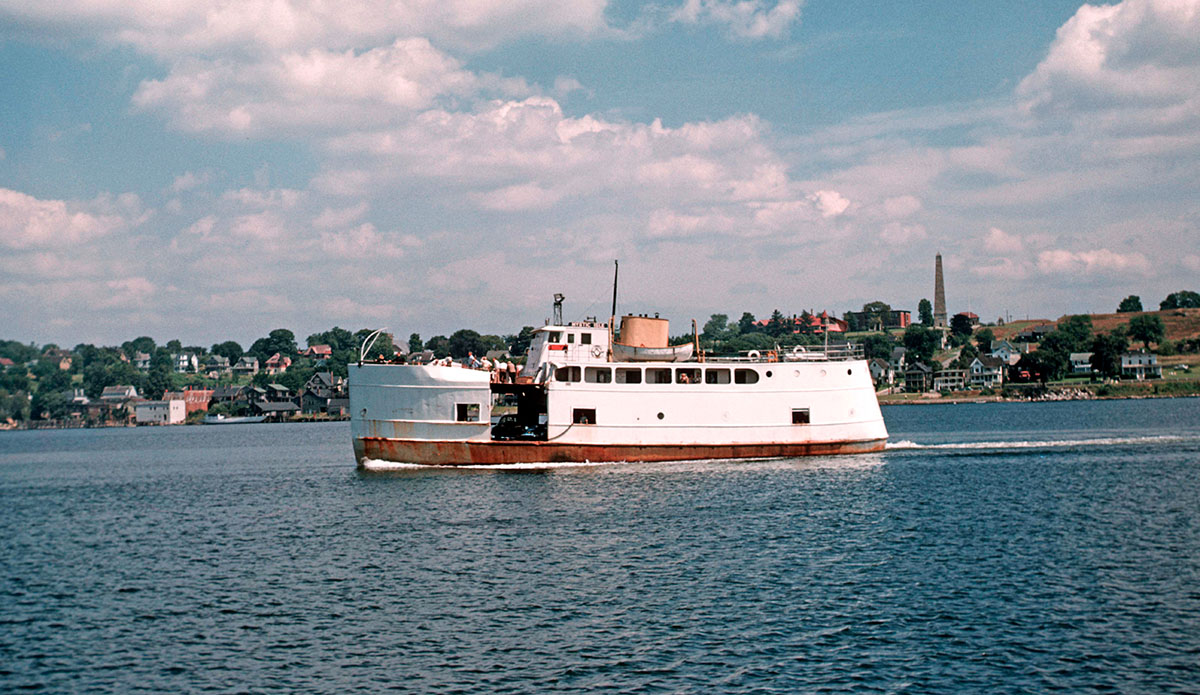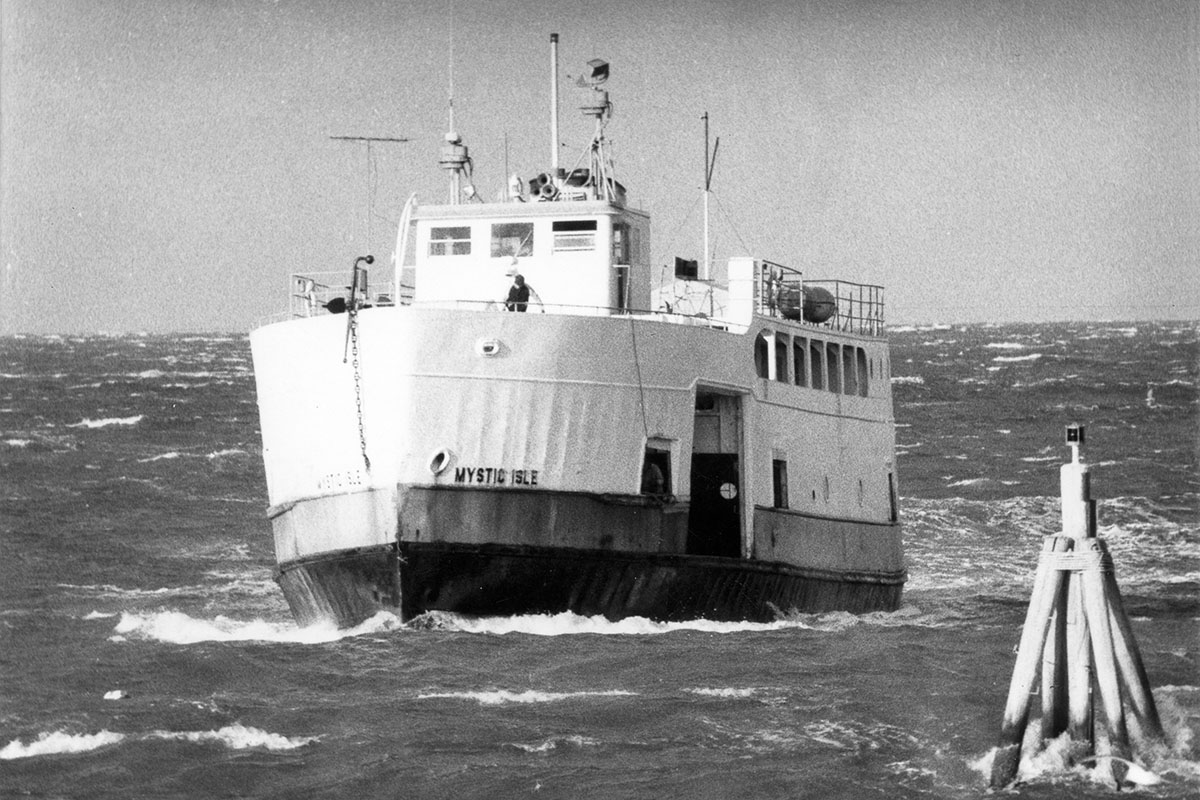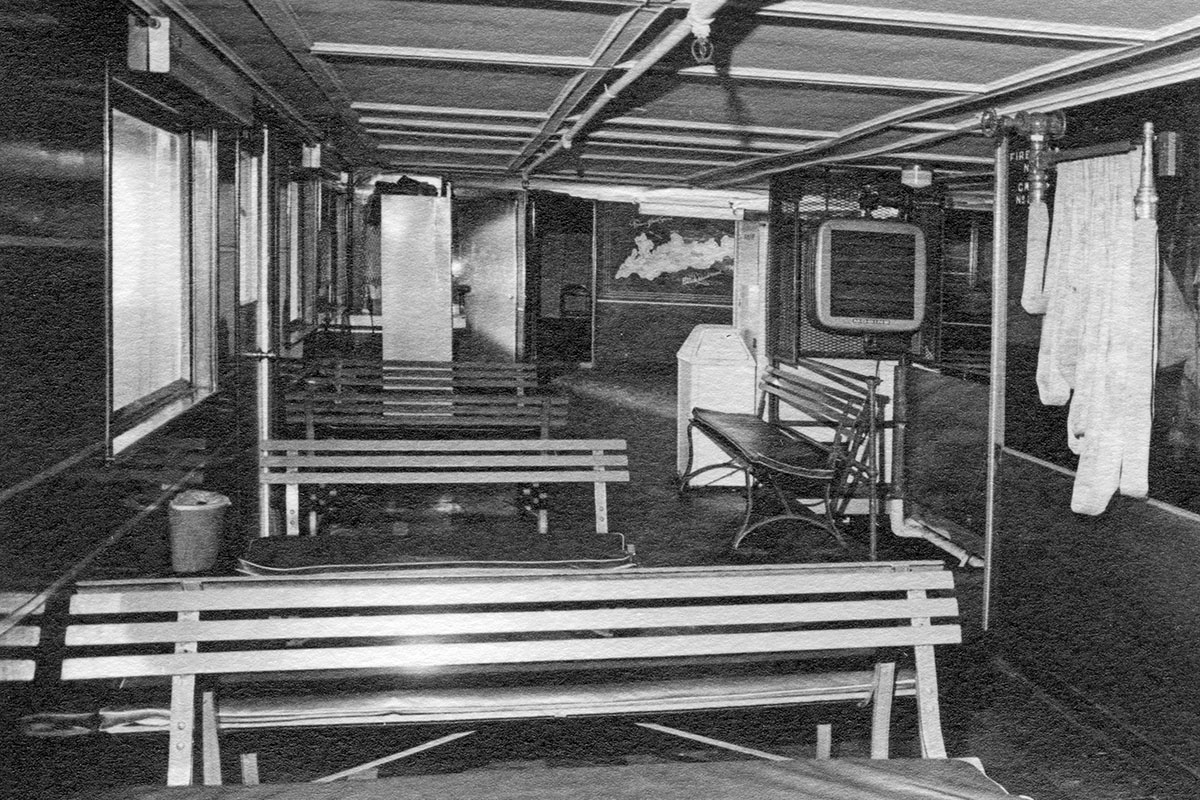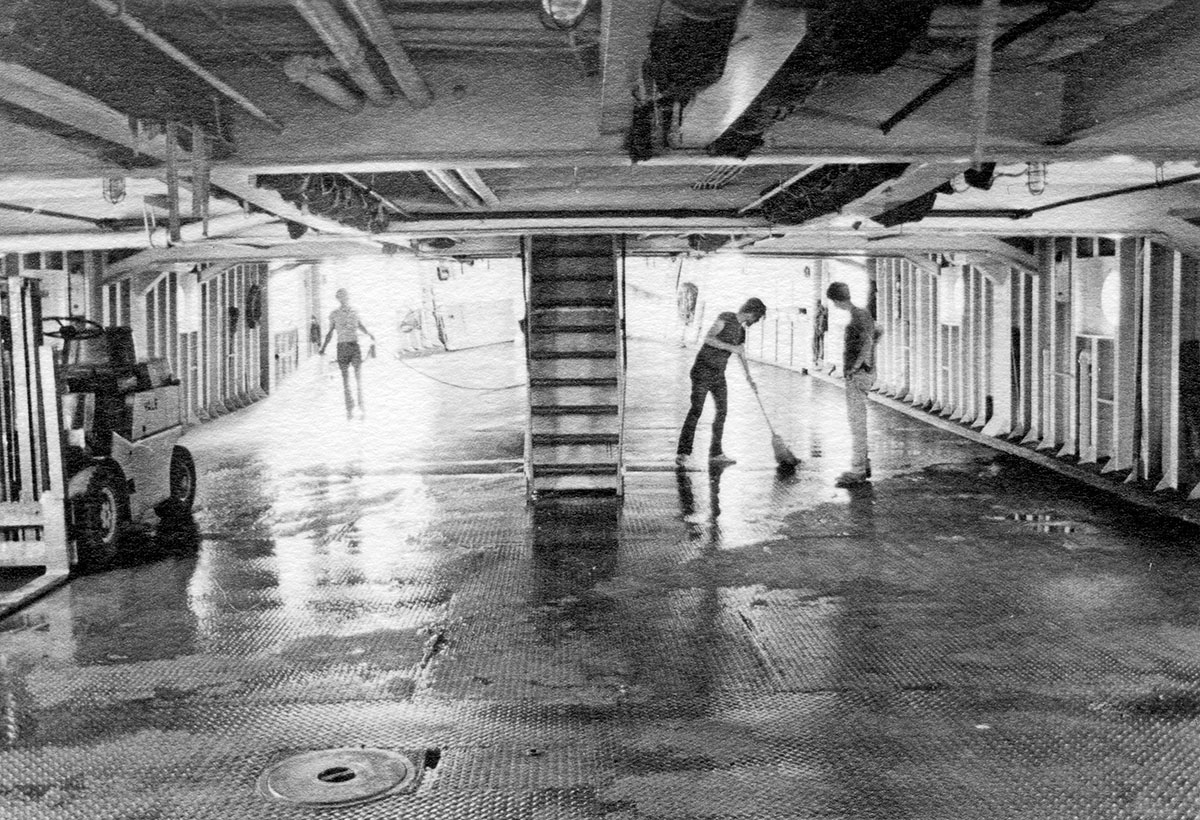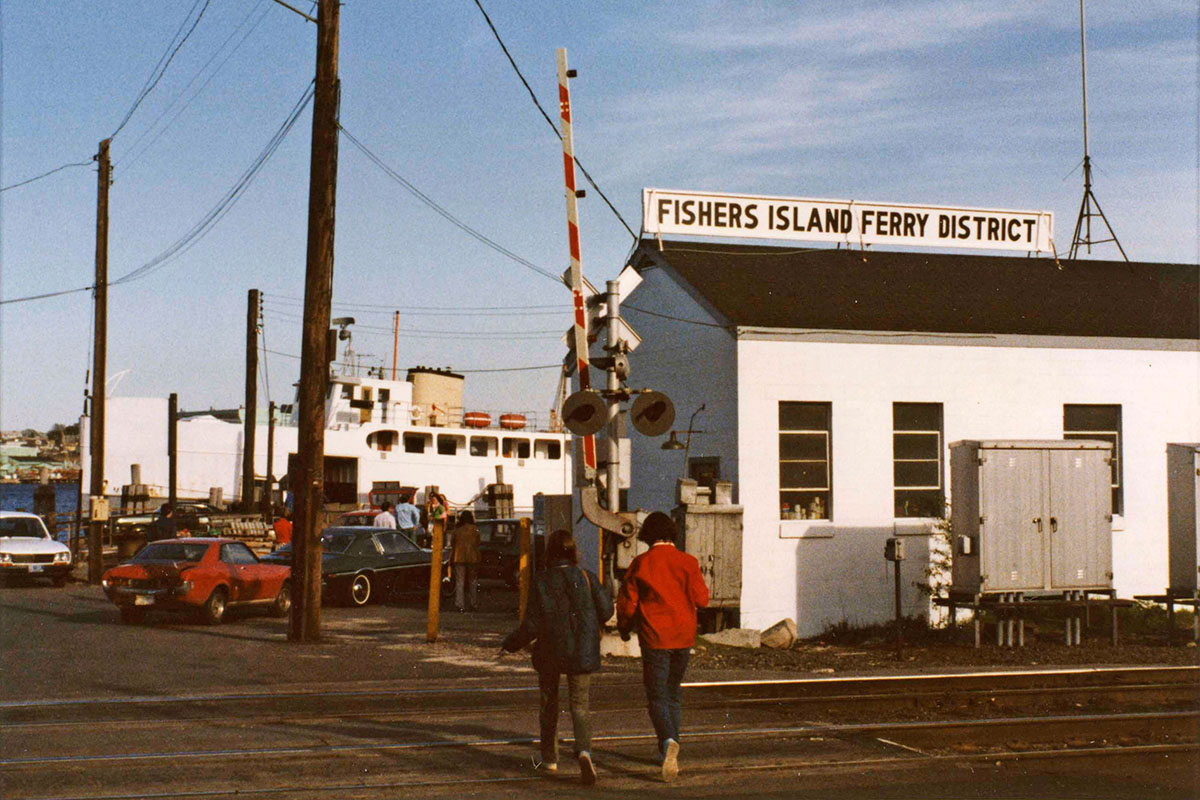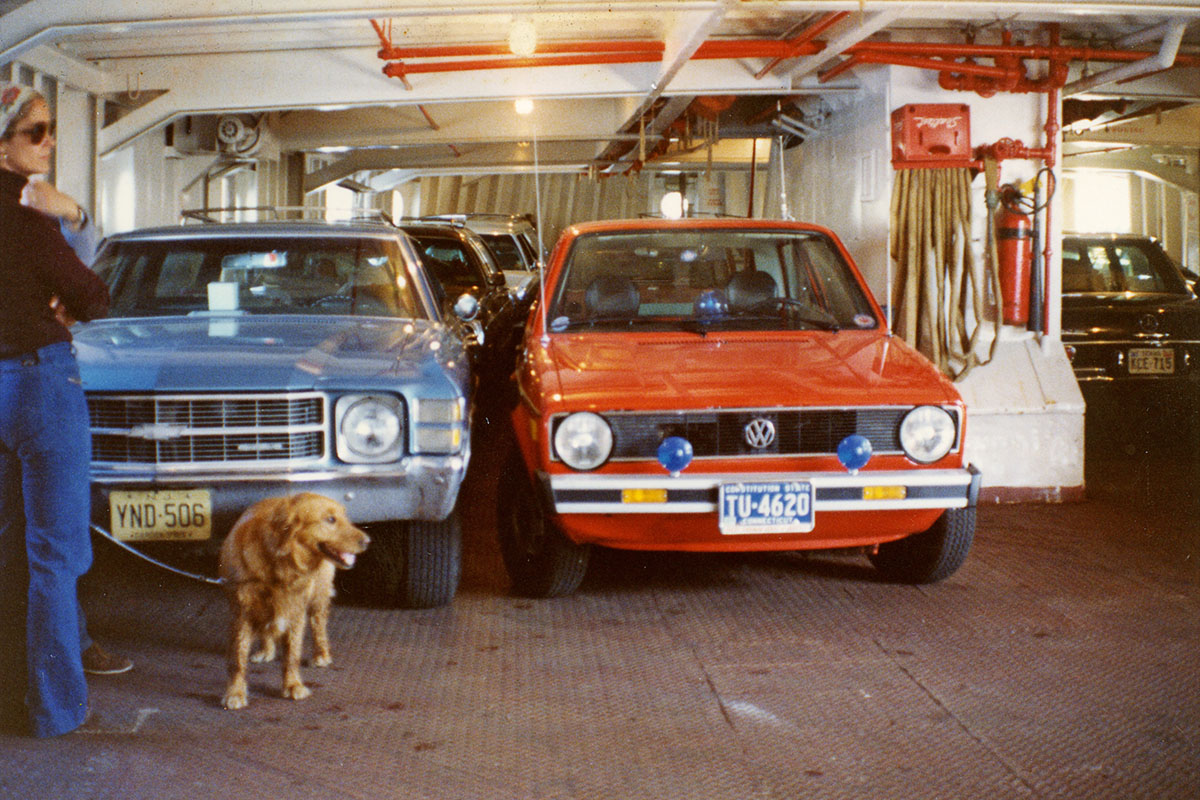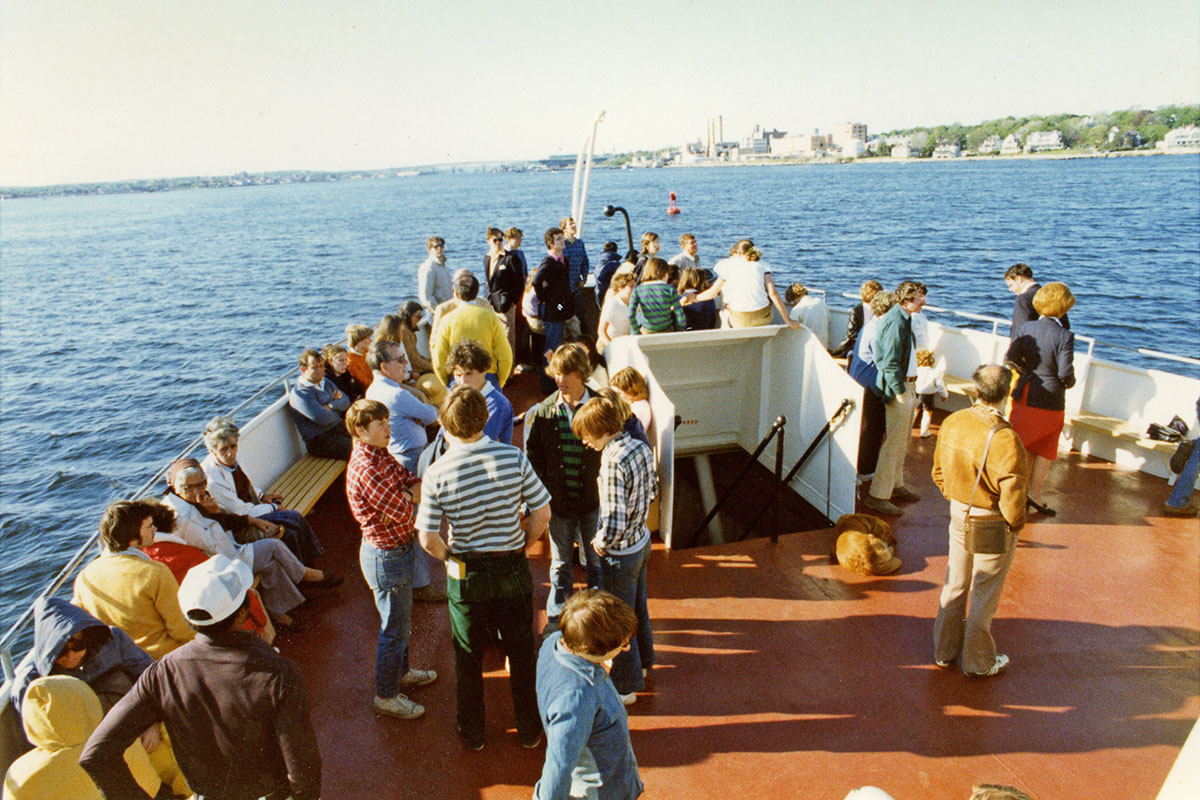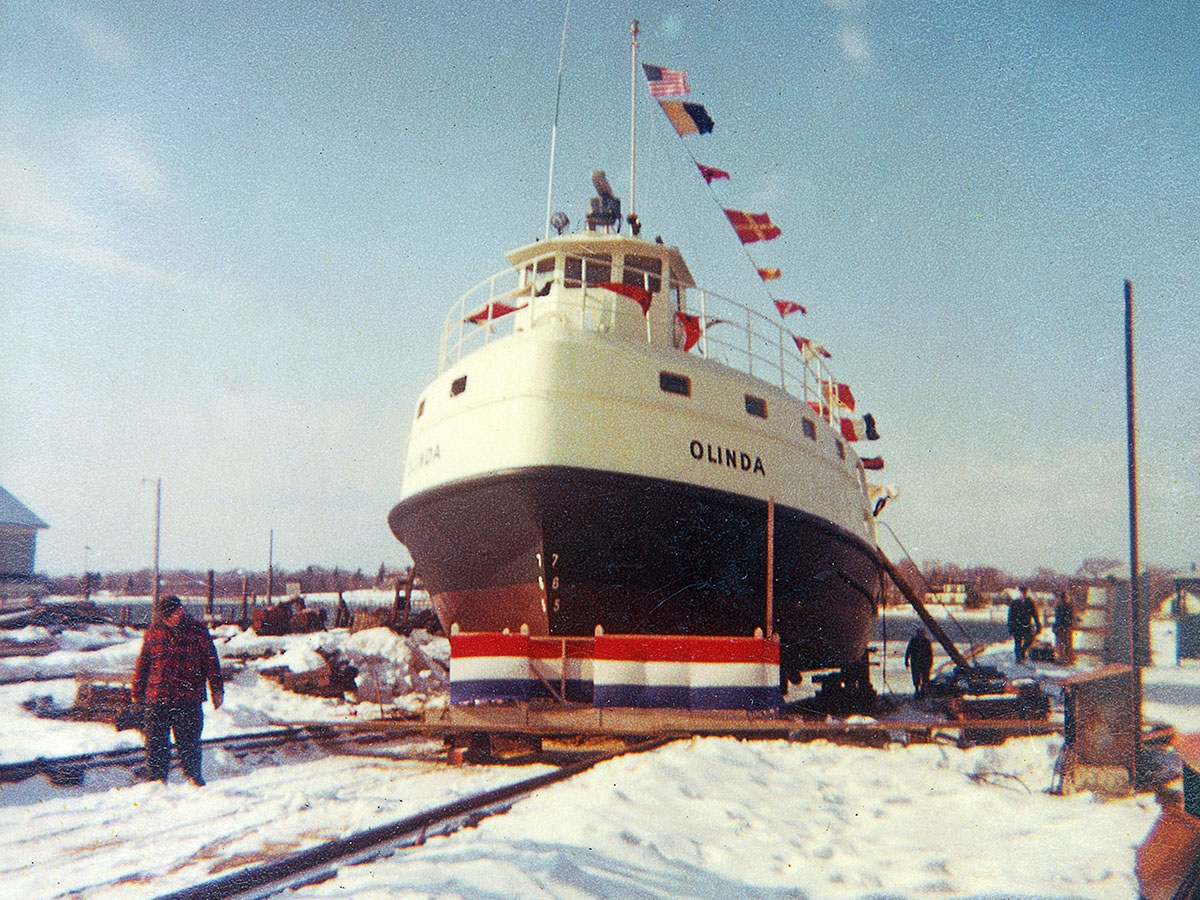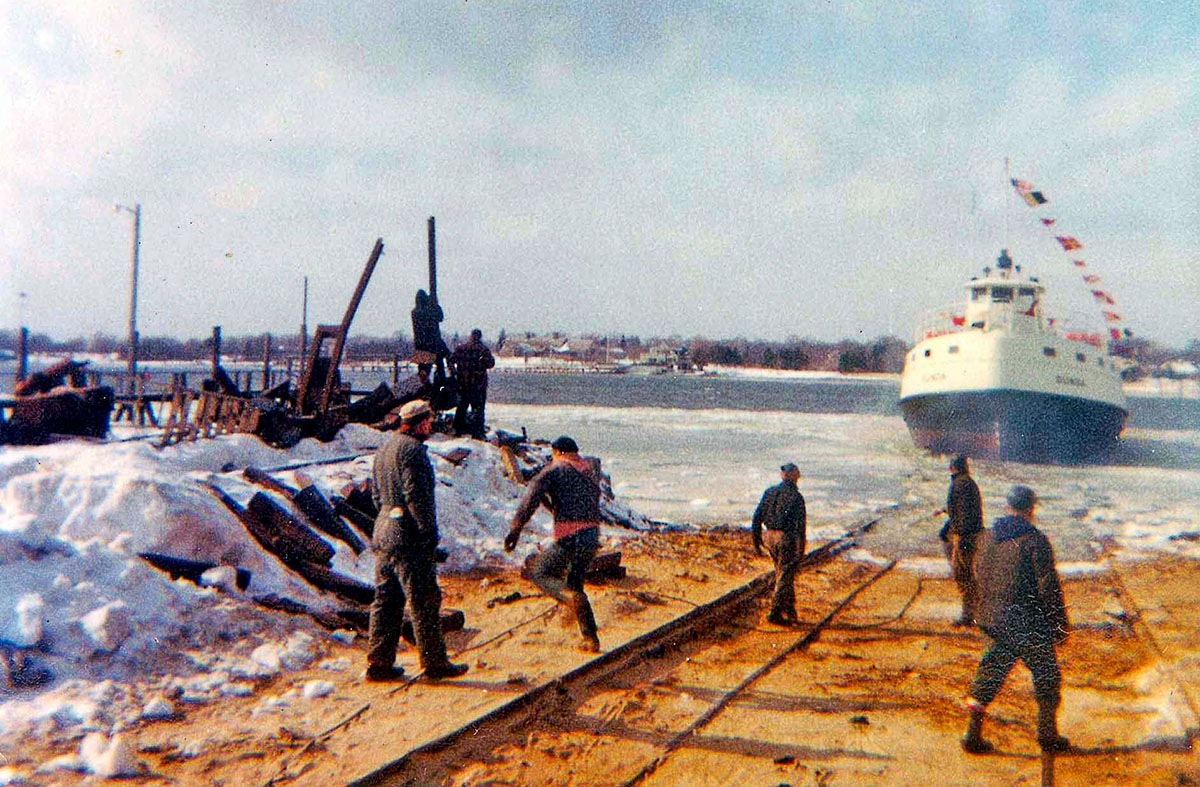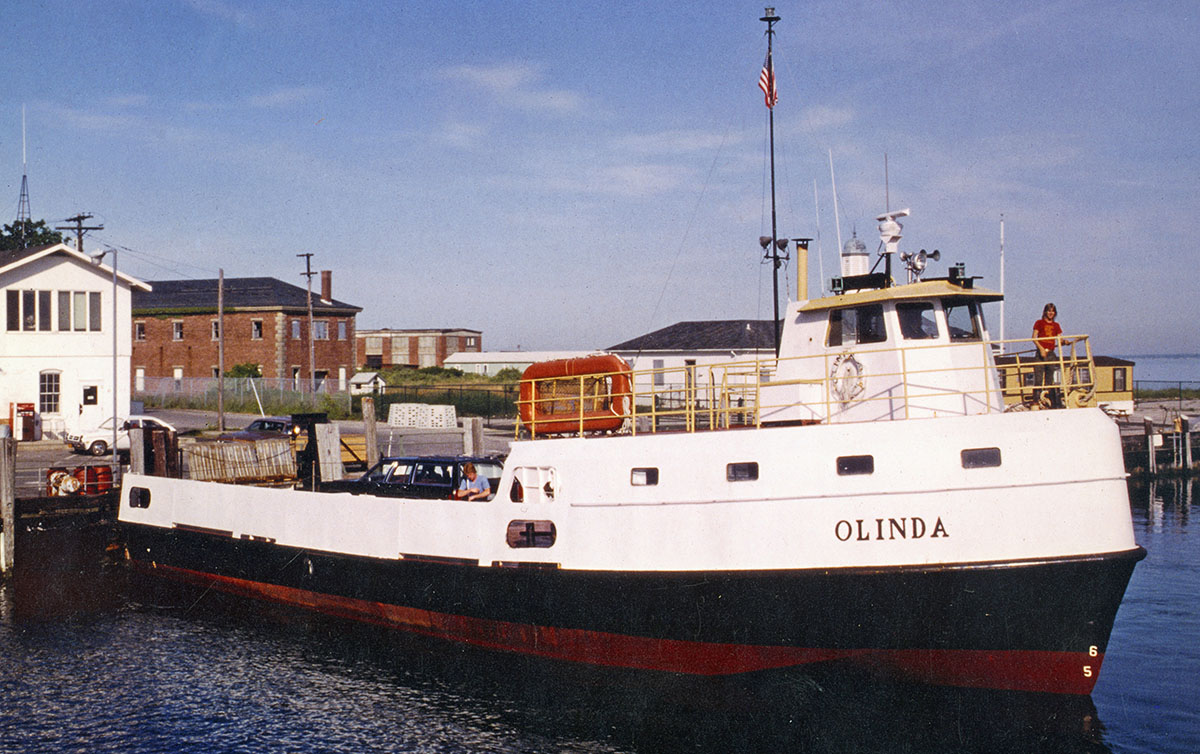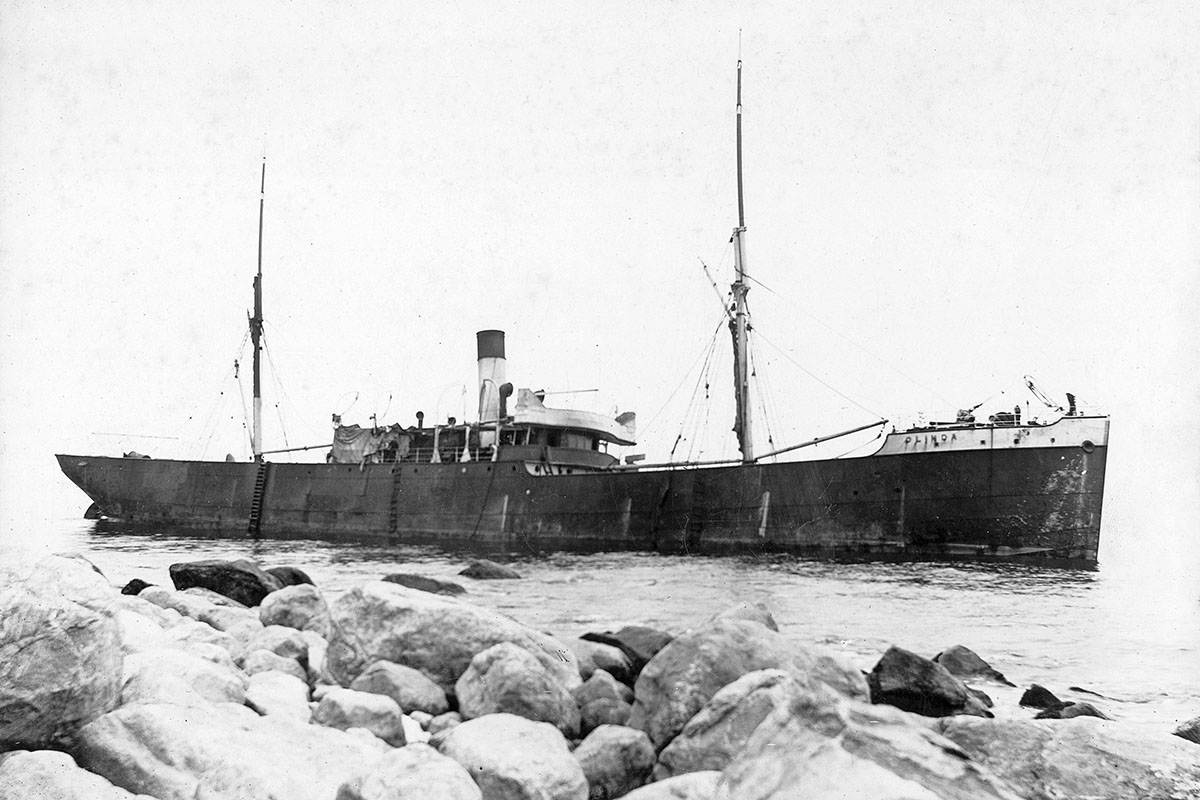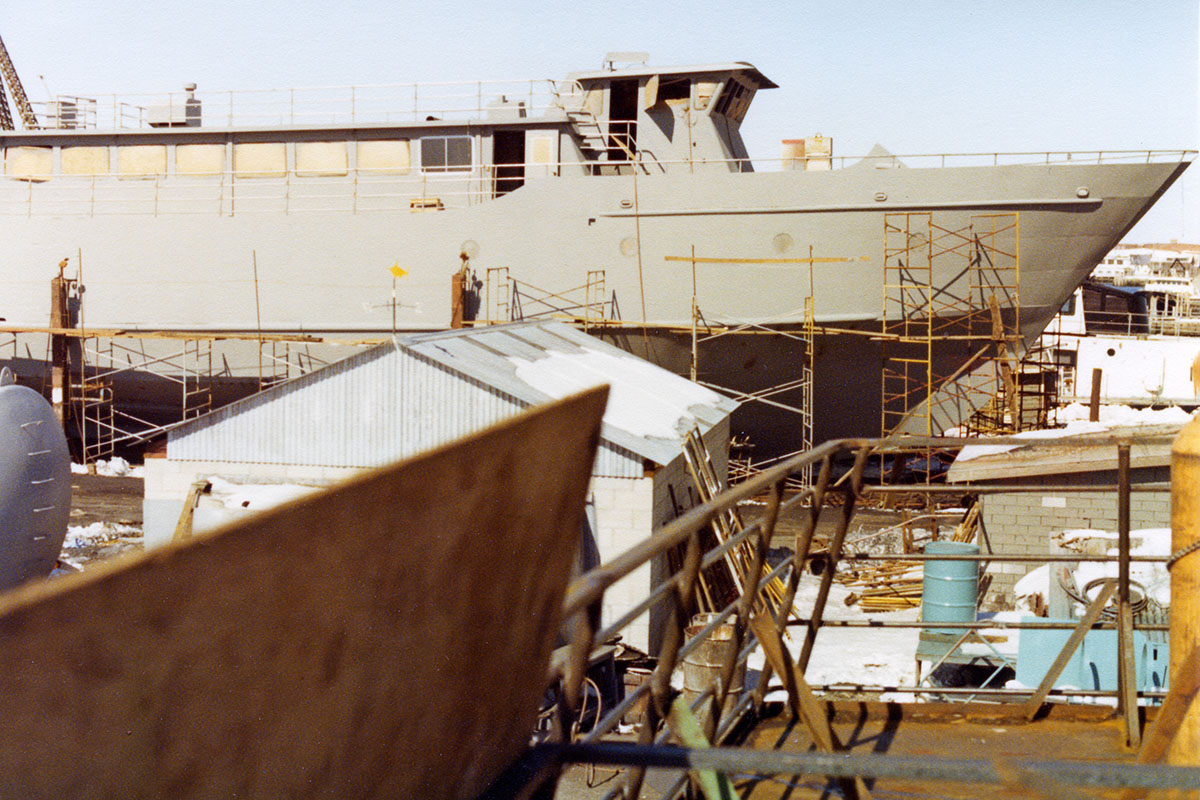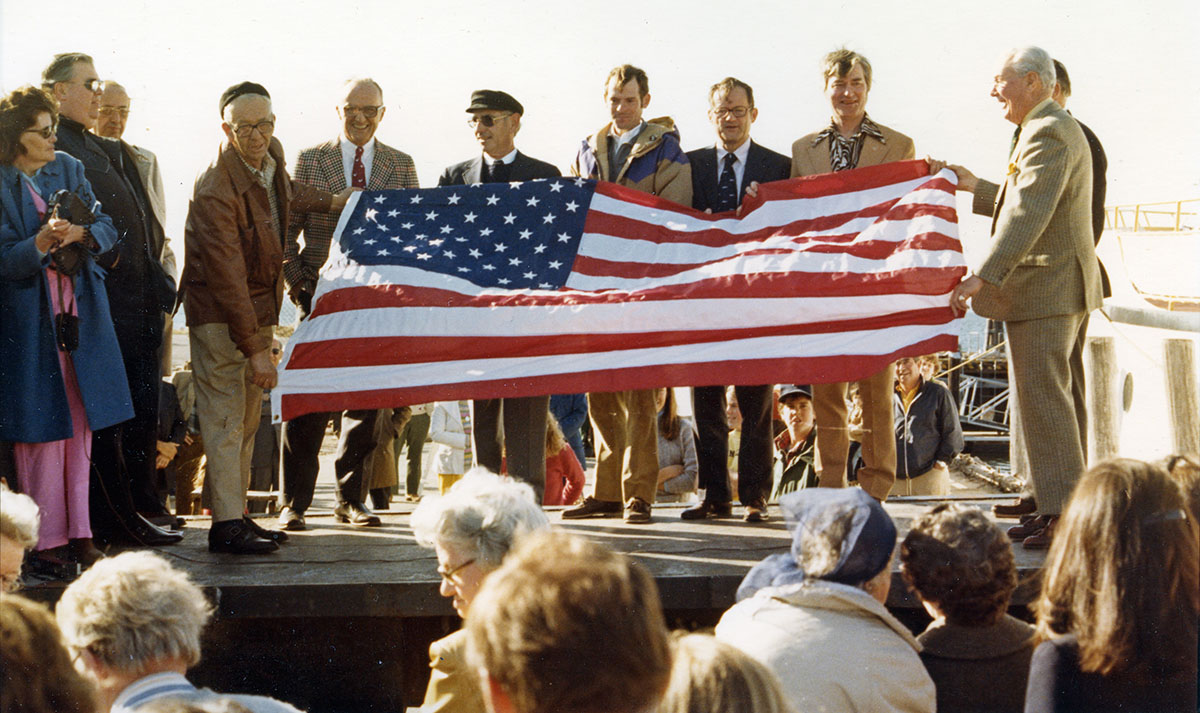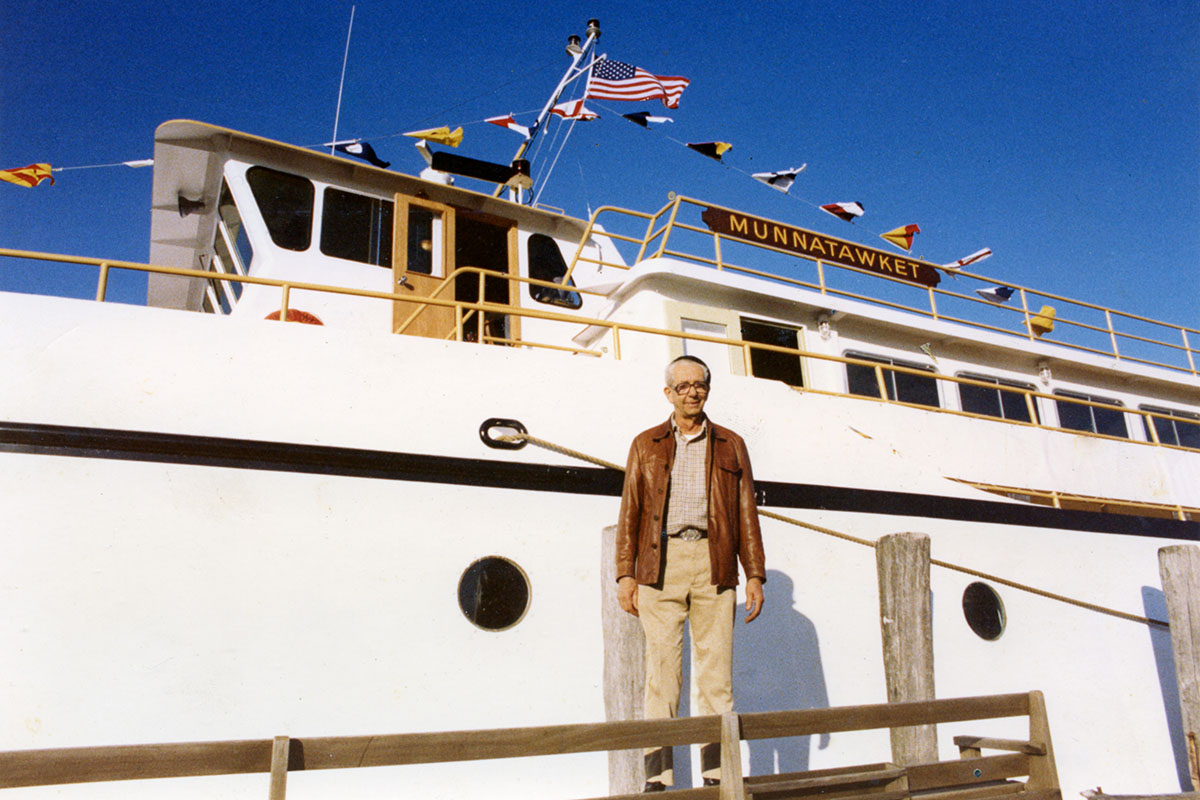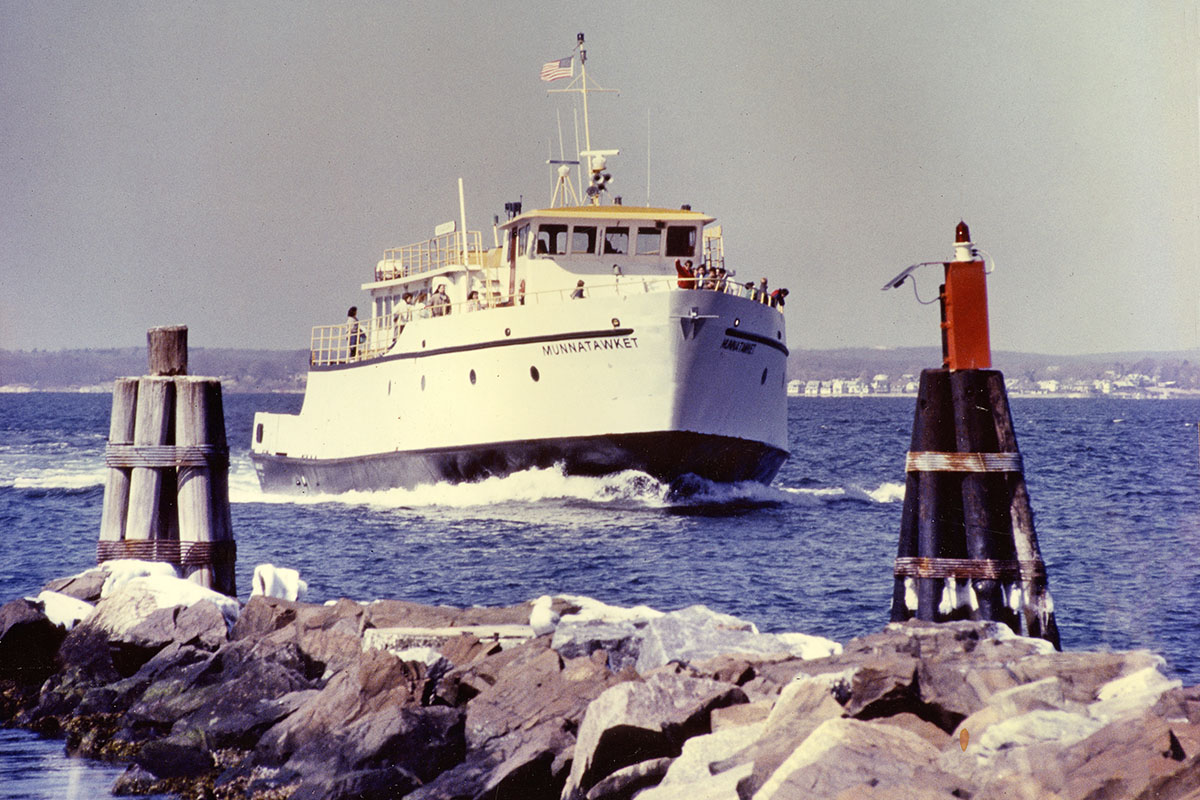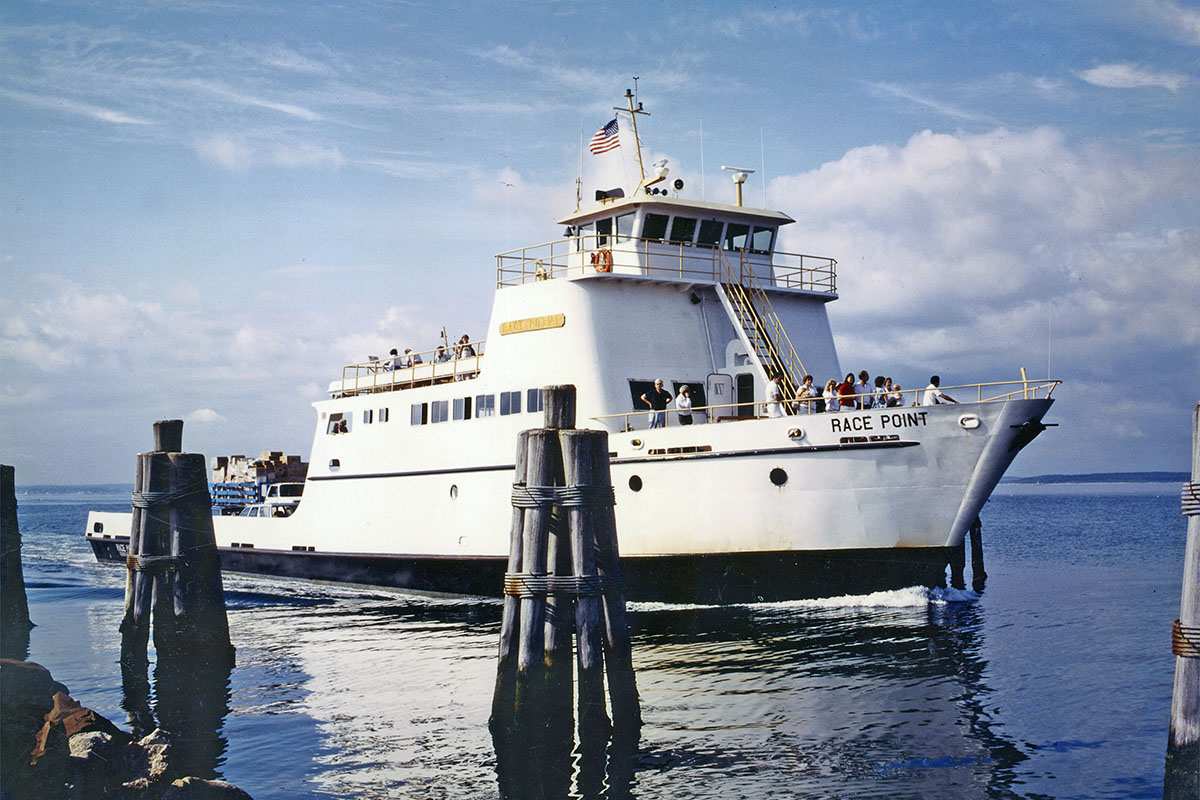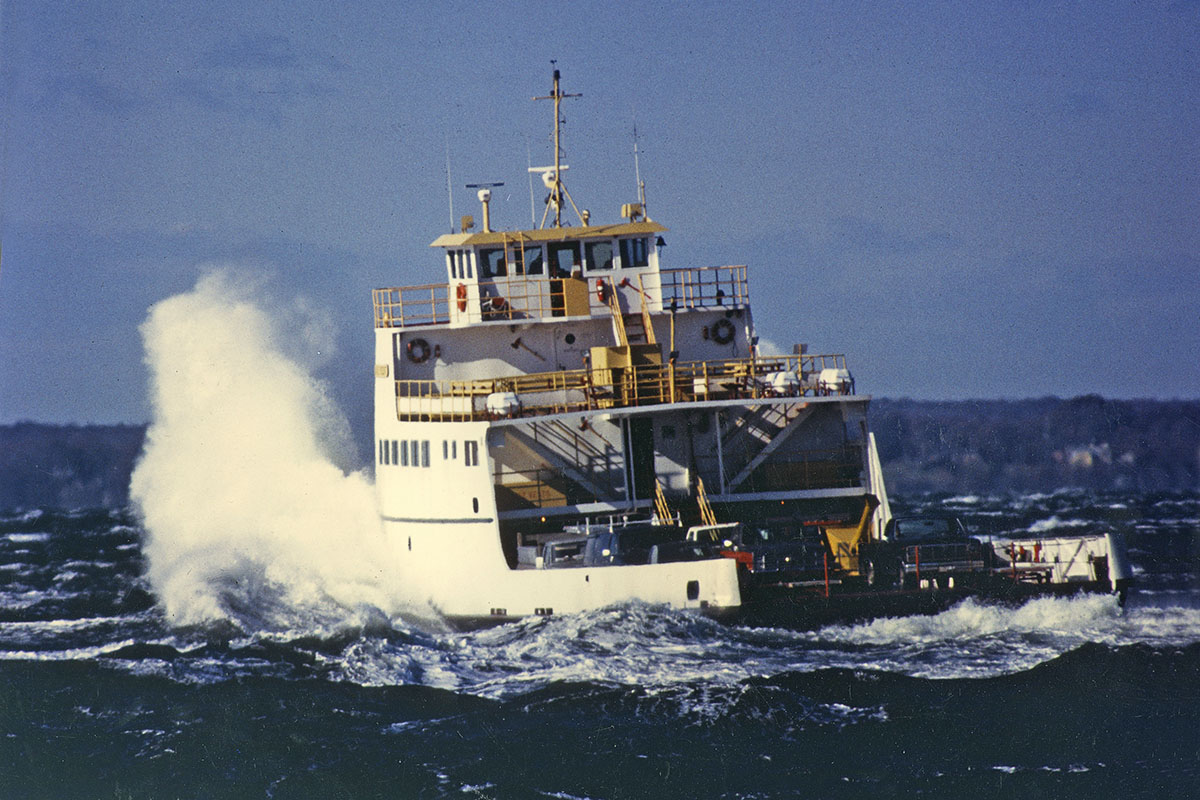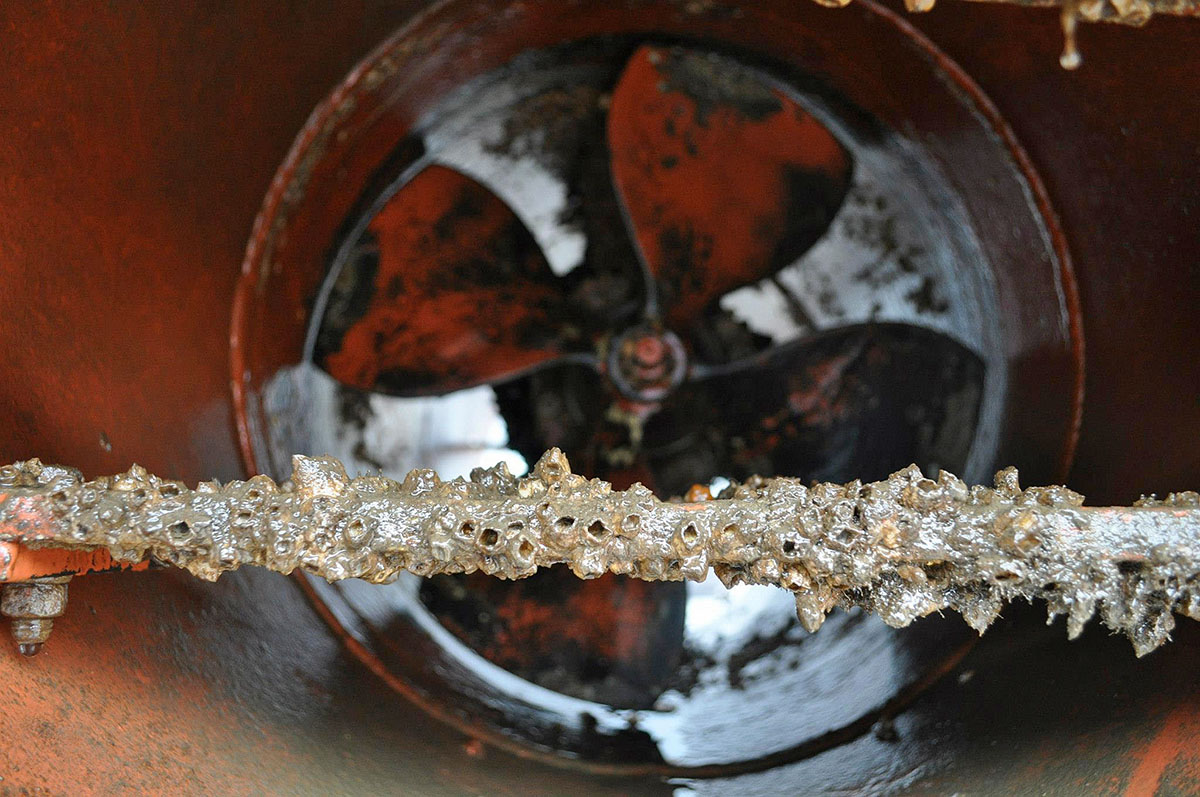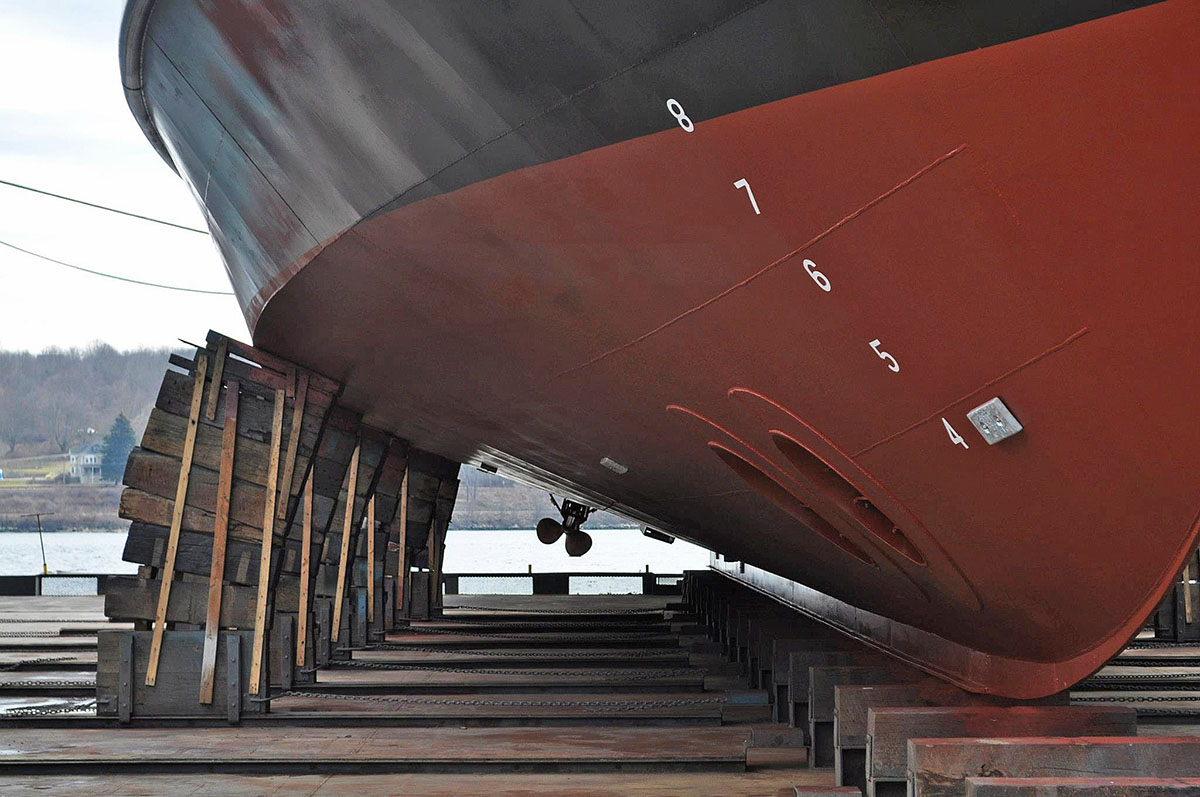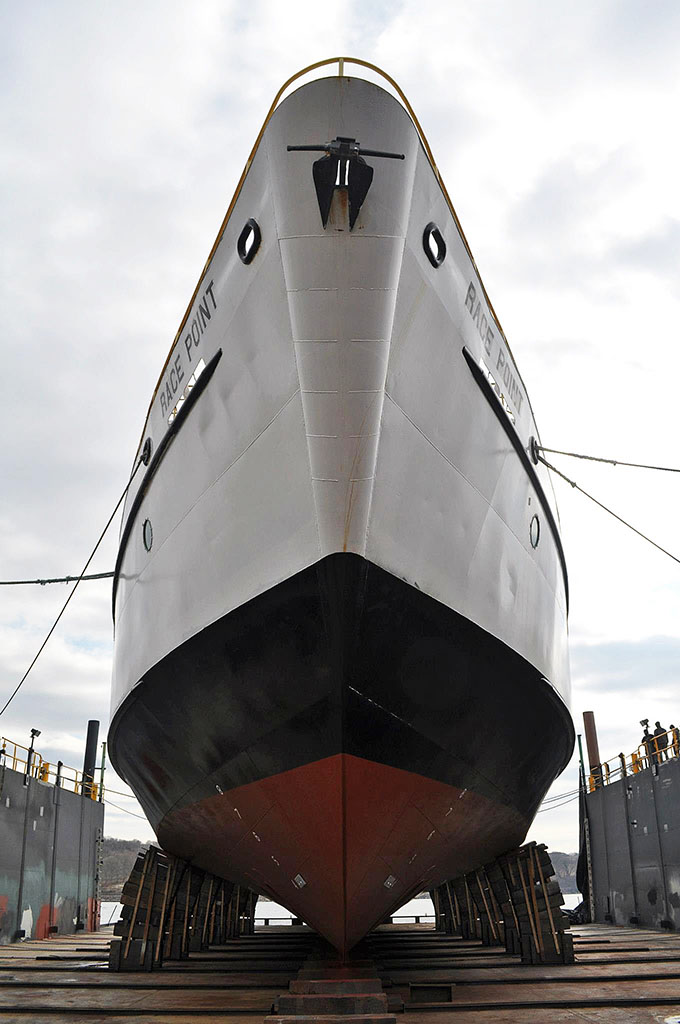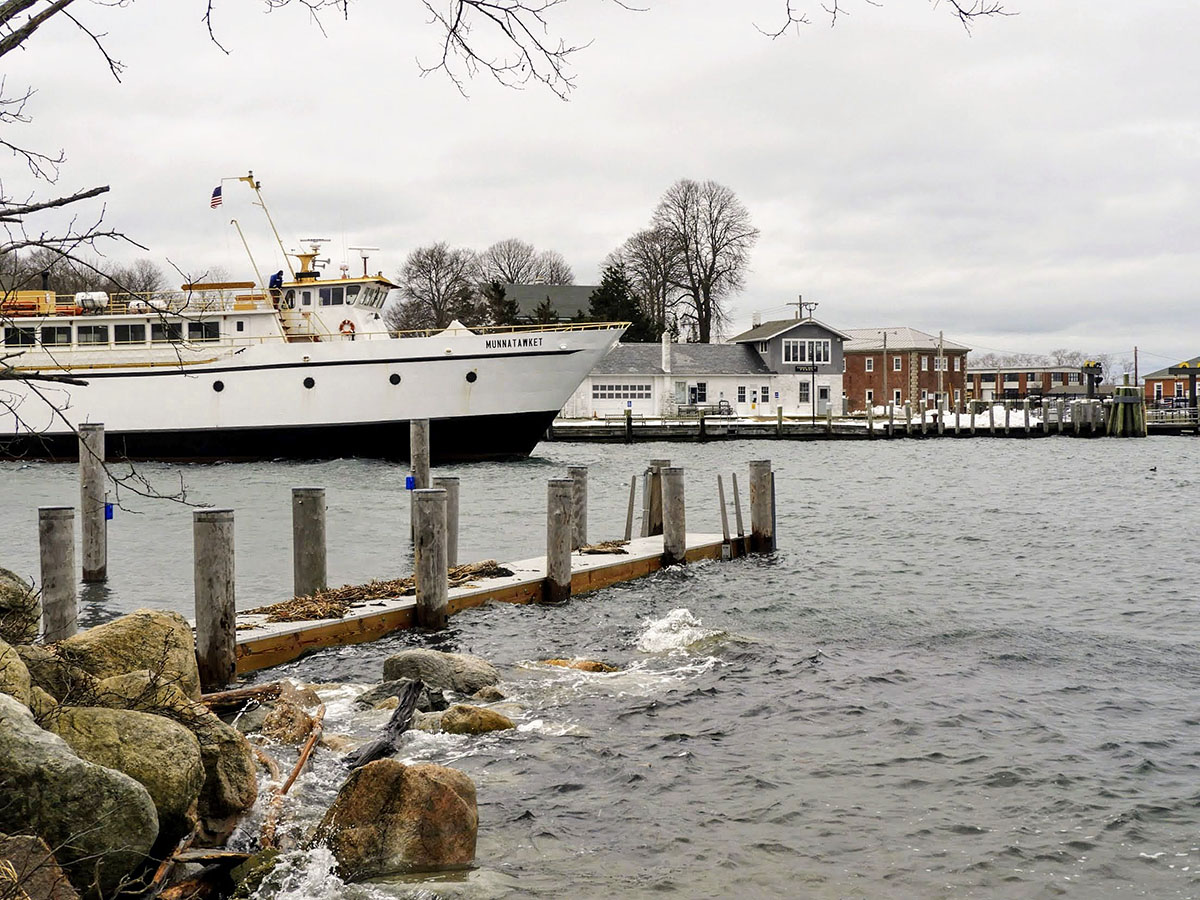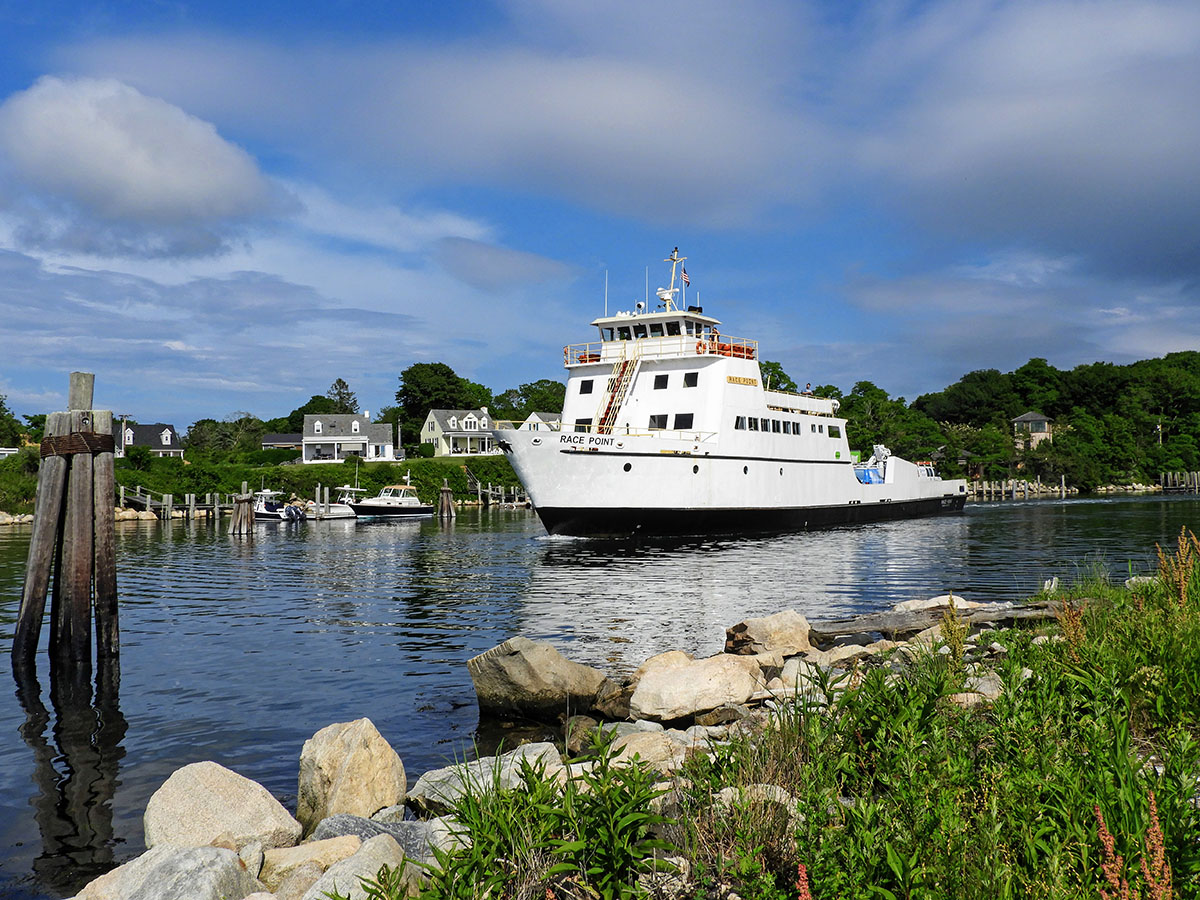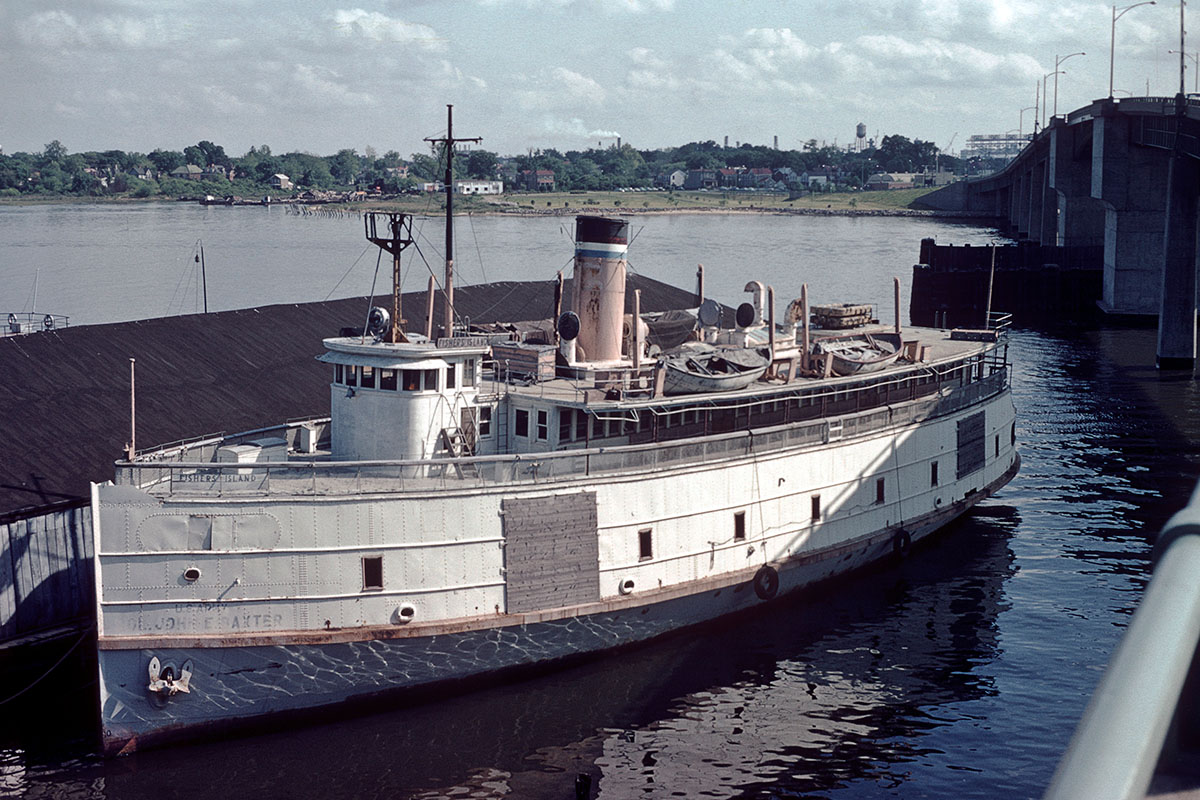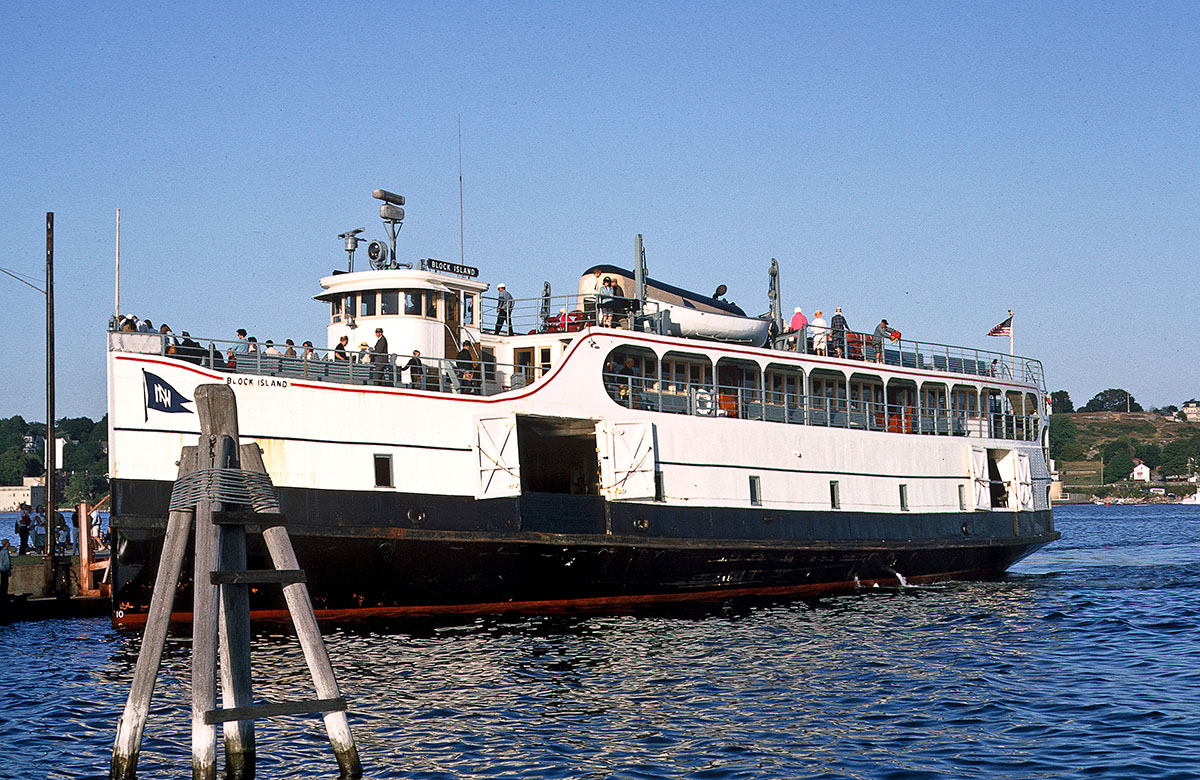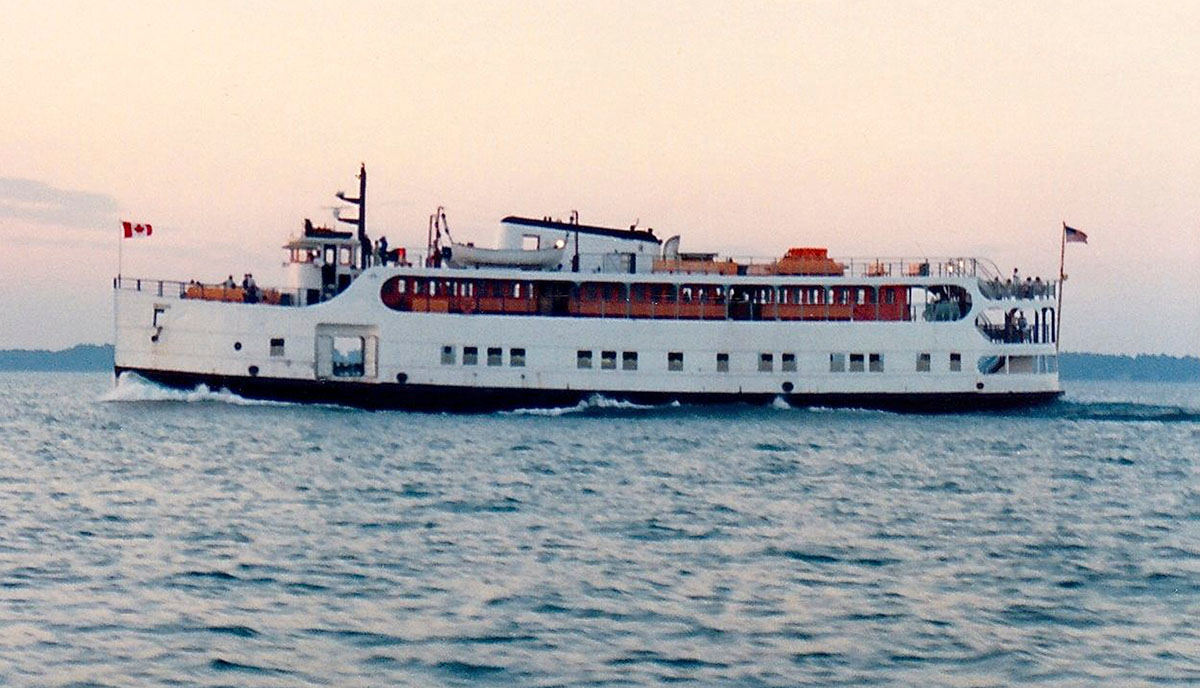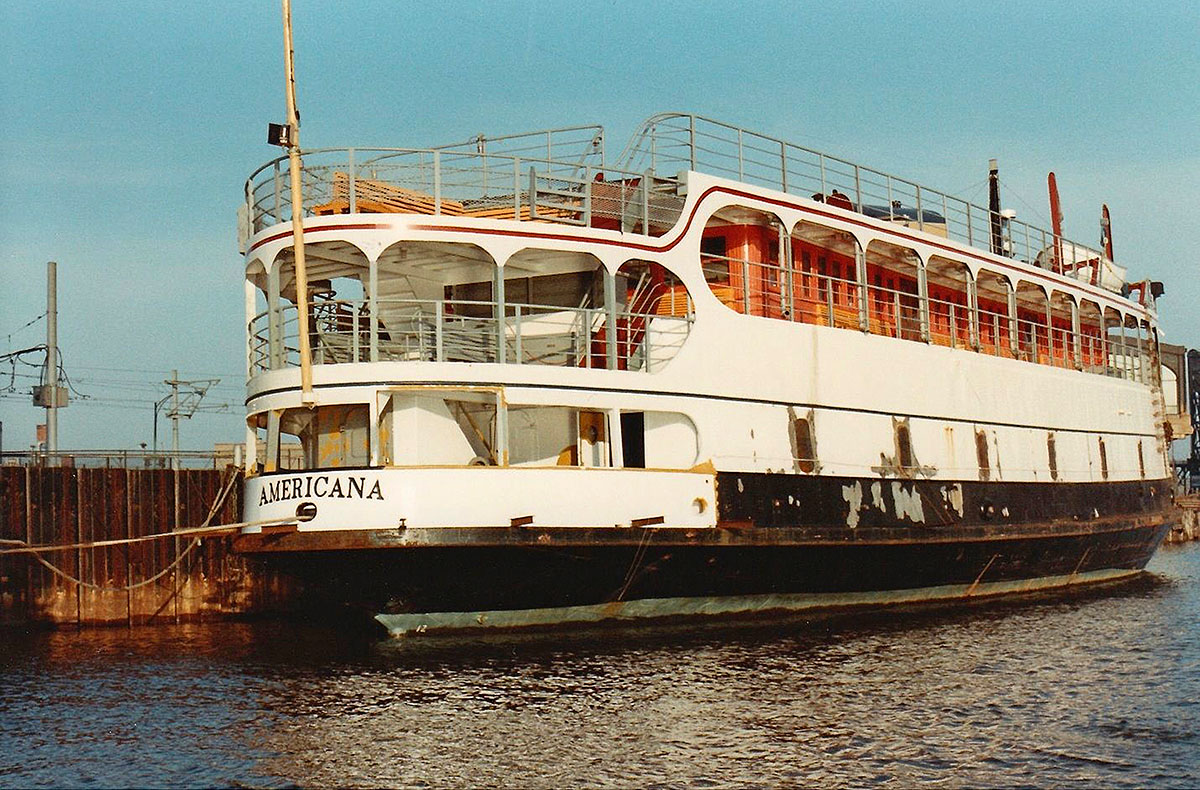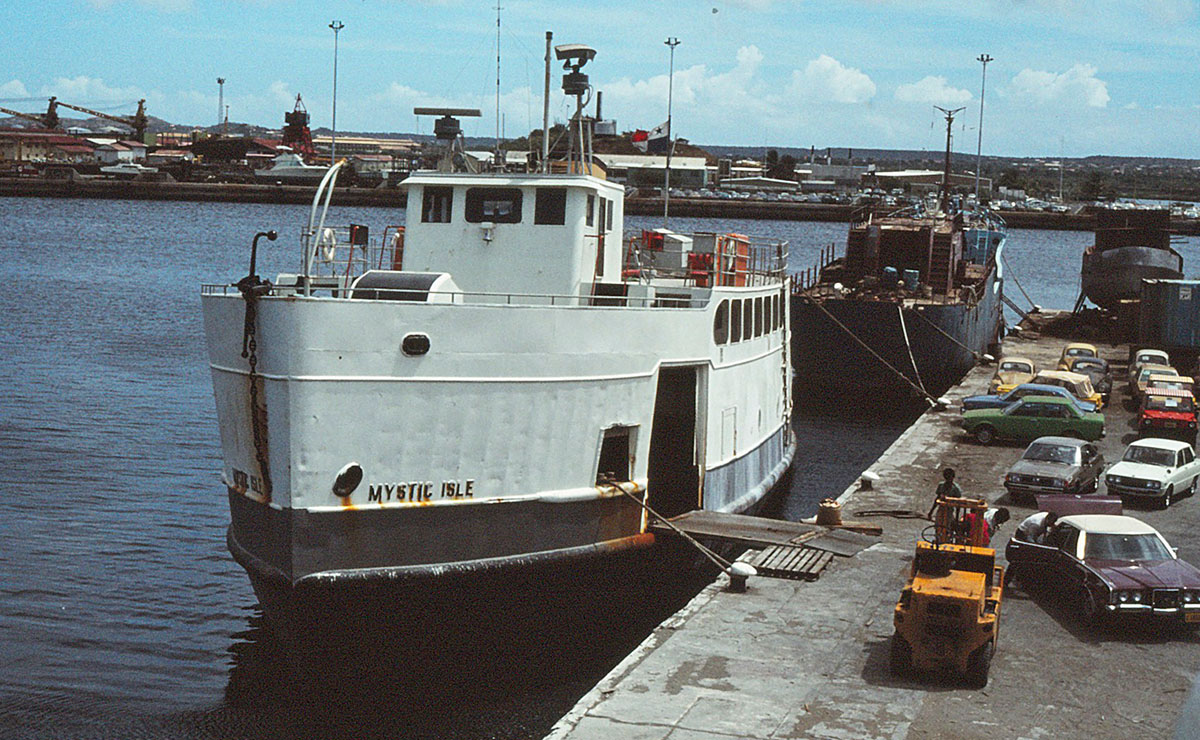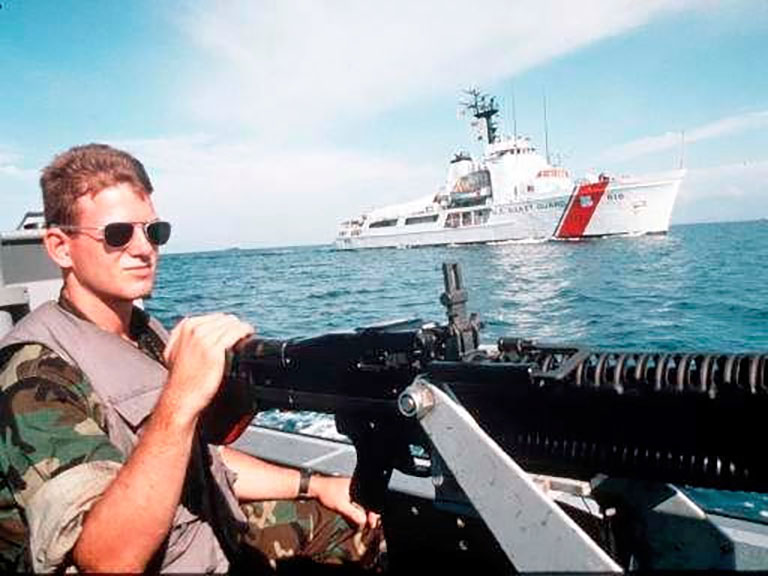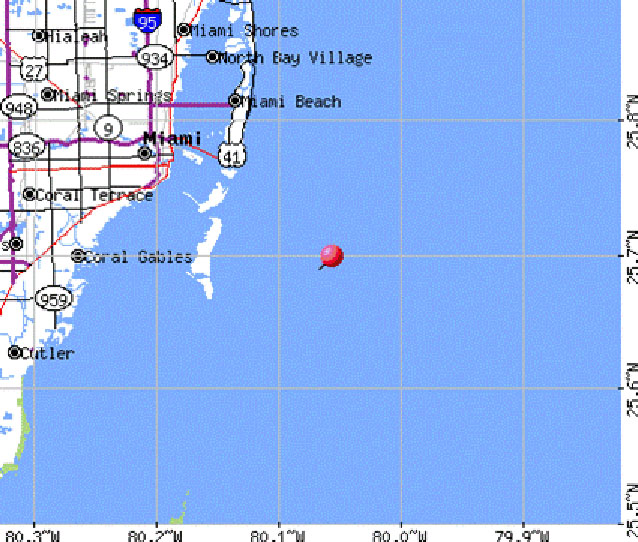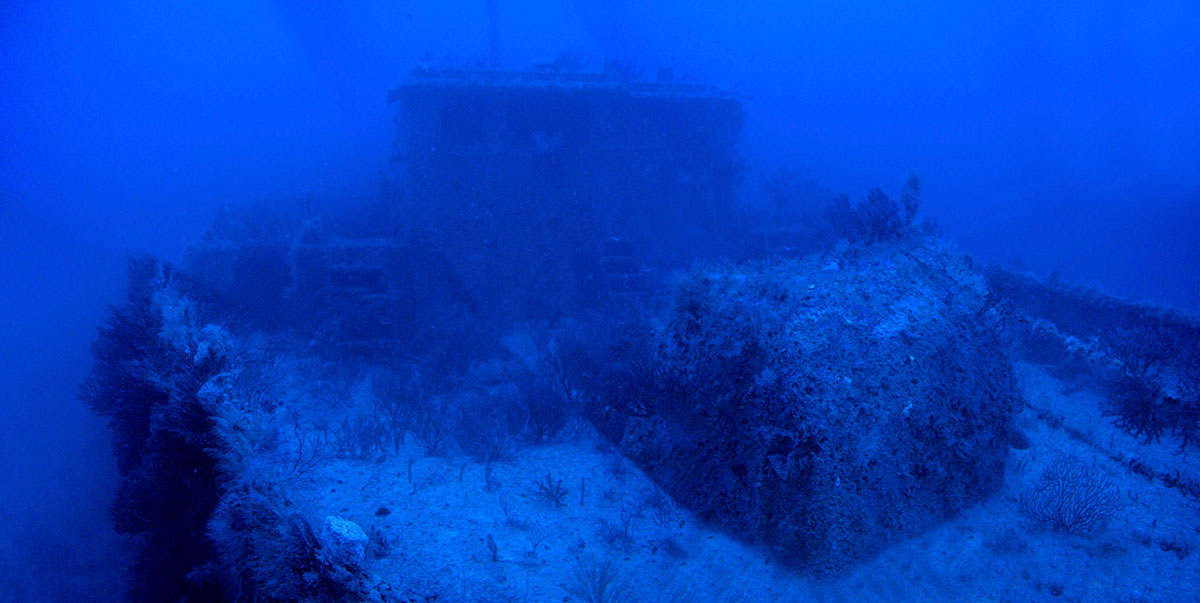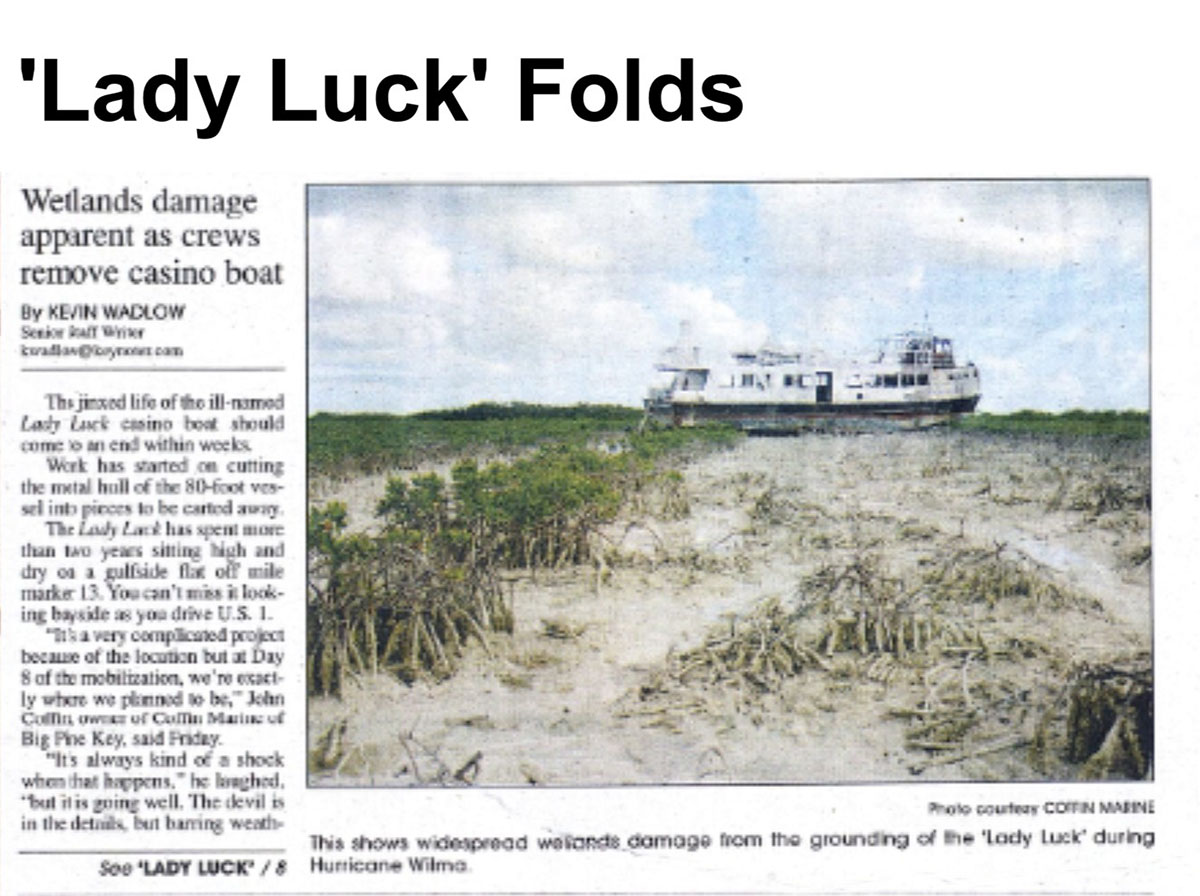ANNUAL EXHIBITION 2014
COMING AND GOING
Curated by HLFM director Pierce Rafferty
The 2014 exhibition chronicled modes of transportation to and from Fishers Island with a focus on the period from the late-1870s to date. Why this time focus? Remarkably, there was little reason for boats to come to our shores for the two and a half centuries that followed settlement by the Winthrops in the 1640s. Fishers Island was a private working stock farm with a population that rarely exceeded 40 people. Barges and flat-bottomed boats transported livestock to and from the mainland. The small number of necessary workers—primarily caretaking farmers and their families—made their way back and forth on smacks, or small sailboats.
With a few outlier exceptions, it wasn’t until the late-1870s, the time period when Fishers Island began to develop as a seaside resort, that boats of all shapes and sizes, sail and steam-powered, working boats and pleasure craft, began arriving and departing from Fishers Island on set schedules, or with a degree of documented frequency.
Detail illustration from Nova Belgica et Anglia Nova
Map by Willem Janszoon Blaeu
1635
Courtesy of John Carter Brown Library at Brown University
Dugout canoes were a primary mode of transportation to and from Fishers Island for countless centuries before European discovery. The dugout canoe shown here would have been capable of making voyages between Fishers Island and today’s Long Island or the adjacent mainland.
Under Sail
Trading sloop (left) and periauger (right)
Illustrations courtesy of Norman Brouwer
The trading sloops that landed on Fishers Island in the early 1800s when it was a Winthrop-owned stock farm would have included vessels like the one shown at left. The square topsail had been dropped by mid-19th century.
The type of schooner-rigged periauger seen at right was popular from the late 18th century to the mid-19th for use as ferries or for coastal freight. Of shallow draft and often flat-bottomed, they would have arrived on Fishers Island carrying people, livestock, supplies or produce.
Sloops under sail
Circa late 19th century
Unknown artist
Courtesy of Helen Bonsal
For more than two hundred years following settlement of Fishers Island by the Winthrop family in the 1640s, there was little reason for boats to come to our shores. Fishers Island was a working stock farm with no population beyond hired hands or lessee tenants.
The small number of farmers and their families working on Fishers Island often travelled on small smacks or sloops like the ones seen in this painting.
Detail from Fisher’s Island New York
Published by US Coast and Geodetic Survey
1882
Museum Collection
When land sales began on Fishers Island in the late 1870s, two businesses were started that brought large working schooners and barges to Fishers Island. One was the Fishers Island Brick Manufacturing Co. Its dock was located on the east shore of West Harbor. The Brick Yard’s dock was a center for shipping activity.
The other business was an ice company run by the Barlow family for whom Barlow Pond is named. Coasting schooners tied up at Barlow’s Ice House dock and loaded ice directly from the adjacent Ice House into their holds.
Detail from US Coast Survey Sounding Sheet No. 99. Fishers Island Sound and Pawcatuck River
1839
Courtesy of Map and Geographic Information Center, University of Connecticut
In addition to the docks at the Brick Yard and Ice House, the primary docking area for sailing vessels coming to Fishers Island from the mid-17th to the late 19th century was on or near the site of today’s Yacht Club dock.
Note the drawing of the “West House”—later renamed “Mansion House.” The road stretched down from the residence to a dock that was expanded in the 1860s and again in the 1890s.
The Steam Era
After our first hotel, the Mansion House, was established in 1877, Fishers Island instantly became a destination for small, mainland-based steamers. By the mid-1880s, a Fishers Island Steamboat Company had formed to promote transportation to Lyles Beach, a large day-excursion hotel on our north shore. Two successful bankers, Edmund and Walton Ferguson bought most of Fishers Island in 1889 and established their own private transportation company the following year. When their Fishers Island Navigation Company failed in 1947, today’s Fishers Island Ferry District was established as an emergency replacement. At the heart of “Coming and Going” is the evolving story of all the steam and motor vessels these navigation companies deployed to get people to and from the mainland.
Steamer Fanny
Reproduction of watercolor painting by James Bard
1831
Courtesy of Mariners’ Museum, Newport News, Virginia
Beginning in late June 1825, the Steamer Fanny took “parties of pleasure” — i.e., picnickers, on Wednesday excursions to Fishers Island. These were outlier visits occurring more than 50 years before any regular passenger steamer service to Fishers Island was established.
The Steamer Fanny, built in New York in 1825, was 104-feet in length. Her regular route was between Norwich, Conn. and New York.
Advertisement for Steam-Boat Parties, EVERY WEDNESDAY on the Steamer Fanny
Published in the Norwich Bulletin
June 29, 1825
The Winthrops, owners of the entire island, likely allowed the visits of the Steamer Fanny in order to generate additional income as their economic position was in decline during this period.
Time Card Steamer Cygnet—New London and Fishers Island
1877
Museum Collection. Acquisition
In 1877, the New London-based Pequot & Ocean Transit Company began running a small excursion steamer named the Cygnet over to the newly opened Mansion House on Fishers Island. The trips were scheduled during the summer season only. At the time, the Mansion House was part hotel, part boarding house, and part B & B.
Fox Mansion House, Fishers Island
Circa 1880s
Museum Collection. Donated by Linda Goodyear
As the fledgling resort took form on Fishers Island in the late 1870s, the rustic Mansion House became Fishers Island’s first destination site. The Steamer Cygnet’s owners evidently believed that this venue was capable of attracting and engaging their mainland customers for they added trips to the Mansion House to their preexisting ferry routes.
Time Card Steamer Cygnet: Commencing July 1st, 1877
1877
Museum Collection. Acquisition
The Steamer Cygnet was the first ferry to make scheduled daily runs to Fishers Island for any sustained length of time. Her owners had founded the Pequot & Ocean Transit Co. in 1872 specifically to ferry excursionists to two Thames River hotels: the Pequot House on the New London side of the Thames (near Ocean Beach), and the Ocean House at Eastern Point on the Groton side. Their two steamers soon replaced the less efficient fleet of sailboats that had been carrying this cross-river traffic.
Edgcomb House, Groton, Conn.
Trade card
Circa 1870s
Courtesy of Jim Streeter, Groton historian
By 1877, the Edgcomb House, also located on Eastern Point, had replaced the Ocean House as the primary Groton destination for the cross river steamers. As this schedule reveals, the Cygnet made repeated trips to Fishers Island from New London and from both mainland hotels, with return trips only to New London.
Steamer Cygnet
Circa 1870s
Courtesy of The Steamship Historical Society of America
The 62.2-foot Steamer Cygnet, the pioneer ferry as far as scheduled travel to Fishers Island goes, was built at the Robert Palmer shipyard in Noank, and launched in 1876. She had a passenger capacity of only 144.
The Steamer Cygnet was the second boat in the Transit Co.’s fleet, the first being the Steamer Cecile, 60.5-feet in length, built in Noank in 1872. She also ran to Fishers Island on occasion.
Steamer Osprey
Circa 1880
Courtesy of Mystic Seaport
Launched in 1882 at Mystic Bridge, Conn., the Steamer Osprey, 78.4 feet in length, was added to the Pequot & Ocean Transit Co.’s fleet to carry passengers between the city of New London, the Pequot House and the new resort at Osprey Beach on the west side of the Thames River near Ocean Beach. She was the third and final boat built for the Pequot & Ocean Transit Co.
In the summer of 1883, the Osprey made numerous moonlight excursions to Fishers Island that were reported by the The Day to be “delightful.”
Osprey Beach (New London, Conn.)
Oil on canvas by William Gooding, 1881-1911
Courtesy of Lyman Allyn Art Museum, New London, Connecticut
Circa 1885, the Pequot & Ocean Transit Company ceased all operations and sold off her steamers. This sale was triggered by the shuttering of Osprey Beach in New London as an excursionist destination. With the Pequot & Ocean Transit Co. out of business, Fishers Island’s first sustained steamer connection to the mainland, albeit only a seasonal one, was severed.
Steamer Skip Jack
Circa 1885
Museum Collection
Steamer Skip Jack, built at New London in 1882, was only 47-feet in length, but quickly earned a reputation as a plucky “can do” vessel. In February 1884, she ran the first scheduled winter steamer trips to Fishers Island while under contract to carry the U.S. mail. The Day somewhat humorously noted the impending end of the Island’s winter isolation in an article published on January 12, 1884:
“The permanent residents of the island as well as the birds of passage will appreciate this arrangement linking them to civilization. Its effect will be felt in the development of the real and imaginary resources of this isolated fragment of the state of New York.”
Ferries For Excursionists
Located on the north shore of Fishers Island just west of today’s Three Sister Cottages, the Lyles Beach opened in 1882 as a destination hotel for excursionists, in other words “day trippers.” On any given day, visitors might include groups of Odd Fellows or Masons, workers from a given factory, members of a mainland yacht club, Civil War veterans holding reunions, church congregations, trade groups, or political conventioneers. The range of activities included swimming, sailing, dancing, bowling, billiards, arcade games, baseball, and a shooting range “better than the military.” Drinking was also a primary attraction, as some sections of southeastern Connecticut were then “dry.”
With the Lyles Beach open and active, Fishers Island became an active participant in the bustling ferry traffic of excursionists that was flourishing in our region in the early 1880s.
Steamer Block Island at Lyles Beach Hotel dock
Circa 1885
Museum Collection. Donated by Diane Dawson Dexter
The size of steamers visiting Fishers Island during the summer season expanded dramatically after the construction of the Lyles Beach and its associated dock. Of the regular vessels, the Steamer Block Island was the largest, measuring 187-feet in length. Her stops varied over time, but included Norwich, New London, Mystic Island, Watch Hill, Block Island, and Fishers Island. Her capacity during this period was 900 passengers.
Steamer Julia
Circa 1885
Courtesy of the Westerly Historical Society
“NEXT Sunday, September 7th, the Irish-American Social Club has invited all its friends—and its enemies too, if they have the necessary change—to go with it on the steamer Julia to Lyles Beach and New London. The boat will leave Westerly at 7:15 A. M., rather an early hour, perhaps, but this excursion is for all day. If anybody should not get a personal invitation, they will please consider this notice to be for them individually.” Narragansett Weekly, Sept. 4, 1884.
Poster for Fourth Season of the Barge “Frolic”
1888
Courtesy of the Connecticut Historical Society
The elegant Barge Frolic, available for charter with every convenience, could accommodate 600 passengers. Among her many destinations on the Connecticut River and Long Island Sound was Lyles Beach, Fishers Island. Remarkably, she provided an opportunity for people to dance their way to Fishers Island aboard the Frolic!
Steamer Ella underway at Norwich, Conn.
Circa 1882
Courtesy of Mystic Seaport
Built in 1864 by Charles Mallory and Sons, Mystic, Conn., the 157-foot Steamer Ella She was a regular visitor at Lyles Beach from 1882 to 1891, during the summer season only.
She operated a circuitous route between Norwich, Conn. and Watch Hill, R.I. from 1871 to 1903, making numerous stops along the way. For example, The Day reported on July 24, 1882, that “The steamer Ella will hereafter leave Norwich at 8 a.m., New London 9:15, Osprey Beach 9:45, Lyles Beach 10, Stonington 10:30, and arrive at Watch Hill about 11 a.m. Returning she will leave Watch Hill at 3 p.m., Stonington 3:30, Lyles Beach 4:15, Osprey beach 4:30, New London 4:45, and arrive at Norwich at 5:15 p.m.”
The Fishers Island Steamboat Company
To fill the void created by the collapse of the Pequot & Ocean Transit Co.,the Fishers Island Steamboat Company was founded in 1885 by a group of businessmen from the mainland with ties to the Lyles Beach Hotel, Fishers Island.
Billhead of the Fishers Island Steamboat Company, Ltd.
Circa 1888
Museum Collection. Donated by Jim Wall
By the late 1880s, the composition of the Steamboat Company’s Board had shifted. The officers at that time, listed on this billhead, were members of a small group involved with planning the development of a more exclusive resort on Fishers Island.
The Fishers Island Steamboat Company was formally dissolved in 1905. No trace of its activity has been found after 1890, likely because the two Ferguson brothers who in 1889 became primary owners of Fishers Island, Edmund M. Ferguson (listed on this billhead), and his brother Walton, started their own navigation company in 1890.
Steamer Fishers Island at dock
Circa 1888
Courtesy of Arnold Crossman, Historian of the Noank Historical Society
The primary ferry of the short-lived Fishers Island Steamboat Co. was the Steamer Fishers Island—not to be confused with the 1926 steamer of the same name. She was built in 1884 in Oneida, NY, and originally operated under the name Steamer Clarence H. Pitt. After purchase by the Fishers Island Steamboat Co. in 1885, she was overhauled, renamed, and put on the New London to Fishers Island run. She had a passenger capacity of 150 and was 71-feet long.
Newspaper advertisement for Steam Yacht Julia
June 6, 1886
Reproduction from The Day
Museum Collection
The Steam Yacht Julia—not to be confused with the Steamer Julia—was the other ferry in the Fishers Island Steamboat Co.’s tiny “fleet.” She had originally been the private steam yacht of the notorious Tammany Hall crook, William “Boss” Tweed. All attempts to locate photographs of this steam yacht have thus far failed.
A New Navigation Company For Ferguson Ferries
After purchasing most of Fishers Island in 1889, E. M. & W. Ferguson founded a new navigation company in 1890. Their first commissioned passenger ferry, Steamer Munnatawket, was built and launched in New London, Conn., in 1890. They also purchased a wharf in New London that was “ample in dimensions and convenient to the central parts of the city.” Please note New London’s Union Station in the background.
Steamer Munnatawket underway
Circa 1905
Museum Collection. Donated by Pierce Rafferty
The 117-foot long Steamer Munnatawket was perhaps the greatest “workhorse” of all Fishers Island ferries. Converted into a motor vessel in 1923, she continued her runs between Fishers Island and New London until the mid-1930s.
“The visitor to Fisher’s Island should go to New London and take the steamer Munnatawket…The boat makes several trips a day in the summer season, but crosses only once in twenty-four hours in the winter, remaining overnight in her snug island wharf. She can cover fourteen knots an hour, but usually takes from thirty-five to forty minutes to make the seven miles from dock to dock.” Quote from: Fisher’s Island: A Former Bit of New England, by H. R. Palmer, The New England Magazine (July 1903).
A new transportation system
1897
Illustration from the advertising brochure “An Island of Homes”
Published by E.M. & W. Ferguson
After their 1889 purchase, the two Ferguson brothers immediately set out to create a transportation system worthy of a first-class resort. They not only commissioned a new steamer and fashioned new docks, but also established an on-island jitney service. This colorful lithographic image promoted the ease of traveling to Fishers Island to their intended upscale clientele.
Promotional brochure travel directions: How to Reach Fishers Island
Circa 1899
Museum Collection
The evolution of steamboat and railroad systems in the latter half of the 19th century allowed the development of remote resorts like Fishers Island. By the 1890s, people from throughout New England could reach destinations that had just two decades before been inaccessible to all but local citizens or the most adventurous.
The very survival of the new resort on Fishers Island depended on the creation and maintenance of a ferry system that efficiently connected with wider transportation systems on the mainland.
Steamer Islander
Circa 1910s
Courtesy of Norman Brouwer
When the Steamer Munnatawket underwent routine overhauls or emergency repairs, a variety of chartered steamers took over her runs. One of the regular substitutes was the passenger and freight Steamer Islander of Rhode Island’s Sakonnet Line. Built in 1883 in Bath, Maine, the 106-foot long Islander was a slow-but-steady passenger and freight vessel. She was purchased by the Fishers Island Navigation Co. in 1904 and ran regularly to Fishers Island for two years, 1904 and 1905.
Steamer Sightseer
Circa 1910
Courtesy of Jim Diaz
Another ferry that occasionally was chartered for the Fishers Island run was the Steamer Sightseer. (Her very name must have made some Fishers Islanders tremble.)
Built in 1894 in Braintree, Mass., this 86-foot long passenger excursion ferry had an impressive 51-year long career, operating at one time or another out of Boston, Bermuda, New York City, and Portsmouth, N.H. She was briefly based in New London in 1910, making that a likely year when this photograph was taken.
Captain Charles E. Nash of the Fishers Island Navigation Co.
Date unknown
Courtesy of Diane Franford
Captain Charles Ellery Nash was born in Westerly, Rhode Island in 1839, the son of a whaling captain. An article in The Day following his death stated that “Capt. Nash was born to the sea, has been on the water since he was eight years old and steered a schooner through Hell Gate when he was nine.” He was captain of the Steamer Munnatawket from the time of its launching in 1890 until his retirement circa 1908. He also owned the Steamer Skip Jack for several decades. After his death, the headline in The Day was “Captain Nash Will Be Much Missed – Islanders Lose a Friend and Long Familiar Face.”
Steamer Restless, Fisher’s Island Nav. Co., New London, Conn.
Circa 1910
Postcard. No publisher listed
Museum Collection. Donated by Pierce Rafferty
A new freight and passenger steamer Restless came on line as the second commissioned ferry for the Fishers Island Navigation Co. in time for the summer season of 1904. She immediately dethroned the SS Munnatawket as the Island’s primary ferry.
Built by Robert Palmer & Son Shipbuilding Co. of Noank, Conn., the Restless was 140 feet in length, 30.5 feet in breadth with a draft of 12.5 feet. The SS Restless replaced the SS Munnatawket as the primary ferry during the season, making six round trips a day, twice the number the slower Munnatawket made during the 1903 season.
Time Table of the Fisher’s Island Navigation Company Steamer Restless
1910
Museum Collection. Acquisition
Remarkably, there were three mail deliveries a day to Fishers Island for six days a week, plus one on Sunday.
Please note that the swastika was an ancient Sanskrit symbol for “good fortune” or “well being” before its meaning was perverted by Adolph Hitler who incorporated it into the Nazi flag in 1920.
Crew of the Steamer Restless
1914
Photograph by Edward Quimby
Museum Collection. Donated by Betty Peishoff
Standing left to right: 1. Deckhand John. 2. Purser Lawrence Goodell. 3. Deckhand Fred Maynard. 4. Mate Walter Palmer. 5. Porter Emory Sears. 6. Pilot Alonzo McKown. 7. Stewardess Margaret MacPherson. 8. Ass’t. Chief Raymond W. Edwards, Sr. 9. Deckhand Al Bridges. 10. Deckhand Twinny Bonnet. 11. Fireman Edward MacDonald. 12. Fireman Eddie Freyer. 13 Deckhand Big Mike. Seated: Capt. John W. Griffin and Chief Clarence E. Edwards, Sr.
SS Restless at the Munnatawket Dock
1914
Photograph by Edward Quimby
Museum Collection. Donated by Tom Armstrong
After the Lyles Beach Hotel re-opened as the Fergusons’ Munnatawket Hotel in 1892, its dock continued to function as the Island’s primary landing for passenger ferries until the mid-1920s. When the Munnatawket was torn down circa 1926, the steamers switched to the Mansion House Wharf within West Harbor.
Please note the freight building at left. It was moved to the Mansion House Wharf circa 1926, and then salvaged again after that wharf was torn down in 1959. It is better known today as the Ahman residence on West Harbor.
Aerial View of the Munnatawket Hotel and Dock
Circa 1925
Reproduction detail
Museum Collection
In 1891, E.M. & W. Ferguson bought out the Lyles Beach Hotel and transformed it into the more exclusive Munnatawket Hotel. To provide an expanded platform for arrivals and departures, the old Lyles Beach Dock was rebuilt in 1895 and renovated once again in 1911 to the shape shown here: 345 feet long and 100 feet wide at its pier end.
Note the Three Sister cottages at right. They were built in association with the Munnatawket Hotel and are now private residences.
Aerial view of the Mansion House wharves with ferry at dock
Circa 1925
Donated by Fishers Island Utility Co.
Reproduction detail
Museum Collection
The Mansion House wharves extended into West Harbor with a two-acre approach that was comprised of fill and lined with landing docks. These wharves functioned as the main distribution point for coal, ice and fuel. Fishers Island’s passenger ferries arrived and departed from here selectively from the early 1900s and on an exclusive basis from 1926 through 1947. Built between 1902 and 1914, these historic wharves were torn down in 1959 and replaced by a smaller and shorter dock that is used today by some of the Island’s commuter ferries.
Time Table of the Fishers Island Navigation Company – 1924
1924
Museum Collection. Donated by Harry and Susie Ferguson
Please note that in 1924 both the Munnatawket Dock and the Mansion House Wharf were still being used for ferry arrivals and departures. Note also that there were two mail deliveries a day.
SS Fishers Island
The SS Fishers Island, the third and last of the commissioned ferries of the Fergusons’ Fishers Island Navigation Co., was an integral part of the mid-1920s development of the east end of Fishers Island known as the “Olmsted Plan.” Between 1906 and 1925, the number of passengers coming to Fishers Island on ferries had jumped from 21,336 to 40,629, an almost twofold increase. With a major project underway to bring up all aspects of the infrastructure of the island to accommodate the planned residential colony at the east end, a new ferry with a passenger capacity of 685 people, seemed not only appropriate, but necessary.
SS Fishers Island underway
Circa 1930
Museum Collection. Donated by John Thatcher
The new SS Fishers Island, 150.1 feet in length, replaced the Fishers Island Navigation Co.’s second ferry, the aging SS Restless. This latter vessel was only slightly shorter at 140 feet, but she had been worn down by 22 years of constant operations with prime responsibility for carrying the bulk of summer traffic.
Remarkably, the Fishers Island Navigation Co.’s first boat, the SS Munnatawket, continued running as a supplemental passenger ferry throughout the balance of the 1920s and into the 1930s, even though she had been launched in 1890. (Some ferries age better than others.)
U.S.S. Col. John E. Baxter
The civilian ferry SS Fishers Island became the US Army Steamer Col. John E. Baxter in September 1941 after being purchased for government service. The loss of their primary passenger ferry forced the Fishers Island Navigation Co. to immediately seek replacement vessels. However, the outbreak of World War II several months later ironically mitigated the problem by creating conditions in which smaller ferries sufficed. The war restricted the flow of passengers and freight to Fishers Island, as did the implementation of tight security measures like military passes and identification cards for civilians. World War II and the immediate post-war period would bring to Fishers Island substitute ferries that were mere shadows of the SS Fishers Island, the boat that they collectively replaced.
MV Islander
Circa 1930s
Museum Collection.
MV Islander, built for service as a US Navy Subchaser, operated as a supplemental ferry to the SS Fishers Island beginning in the mid-1930s. Originally commissioned as US Navy Subchaser 438, she was delivered too late for service in World War I and transferred to the Coast Guard in October 1919. As the USCGC Cook she served at Grand Marais, Michigan, patrolling for (and occasionally battling with) rum-runners who were transporting liquor from Canada. Following her transfer to New London, Conn., the Fishers Island Navigation Co. purchased her in 1936 to replace the retiring MV Munnatawket. The Navigation Co. refitted her with diesel engines, renamed her MV Islander, and placed on the Fishers Island to New London run. She operated as a relief boat for the Fishers Island during the summer season and as the primary boat during the winter months. After six years of Fishers Island service (1936 to 1942), the US Coast Guard repurchased her for military service in World War II.
Former Fishers Island ferry MV Islander as USCGC Bonneville (WIX 375), New London, Conn.
Circa 1943
Courtesy of the Naval Historical Center, Wash., DC
The MV Islander was recommissioned as USCGC Bonneville (WIX 375) in 1943. With this second ferry taken away for wartime service, the Navigation Co. hired island resident Warren Maynard to operate his 40-foot cabin cruiser Espada as Fishers Island’s ferry for the winter of 1942-43.
The Bonneville served at New London, Conn. during World War II with the 3rd Coast Guard District functioning primarily as a training vessel.
US Navy subchasers in Ponta Delgada, Azores
1918
Courtesy of US Naval Historical Center, Wash., DC
Please note Subchaser 323, second from right. She would later be much better known to Fishers Island residents as the ferry MV Ranger. Built by Kyle & Purdy of City Island, NY, Subchaser 323 was commissioned into the Navy on December 5, 1917. During World War I, she was based at Queenstown, Ireland (and possibly also at Plymouth, England). After the war she engaged in mine-sweeping operations in the North Sea.
MV Ranger (former Subchaser 323) at dock in New London, Conn.
Circa 1946
Courtesy of Mystic Seaport
Purchased by the Fishers Island Navigation Co. in 1942, the Ranger helped plug the gap created by back-to-back losses of two ferries to government service. She ran year-round to and from Fishers Island from 1942 to 1947, assisted during the summer months by larger chartered ferries. She was 104.4 feet in length and 15.5 feet in breadth.
MV Ranger leaving West Harbor, Fishers Island, NY, carrying two automobiles on deck
Circa 1946
Museum Collection. Donated by Mrs. Robert A. Campbell
The MV Ranger’s automobile carrying limit was two in clear weather, but only one in foul or foggy weather. On days when bad weather obscured the Captain’s vision, having two autos on deck was not allowed because it threw off the ship’s compass.
USS Col. John E. Baxter entering Silver Eel Cove, Fishers Island, NY
Circa 1948
Museum Collection
When the government took over the former SS Fishers Island in 1942, her docking area on Fishers Island switched from West Harbor to Silver Eel Cove, Fort H. G. Wright, foreshadowing the shift that would soon take place for all ferries.
MV Pemaquid
Circa 1947
Courtesy of Mary Pankiewicz
With the volume of passengers increasing dramatically following the end of World War II, the Navigation Company chartered the 122.5-feet long passenger ferry MV Pemaquid for the entire 1946 summer season. The Pemaquid, whose normal route in this period was New London to Block Island, docked at the Mansion House Wharf in West Harbor. In the late 1940s, she continued to be brought in as a filler boat when regular ferries needed service.
MV Sprigg Carroll at Old Harbor, Block Island, RI
Circa 1950s
Photograph by Edward O. Clark
Courtesy of the Steamship Historical Society of America
Built in 1903 as a transport for the US Army Quartermaster Corps, the 100-foot SS Sprigg Carroll thrived as a civilian passenger ferry after leaving Army service. The Fishers Island Navigation Company chartered this brightly colored vessel from the Interstate Navigation Co. for use during the entire summer of 1947. Her normal run was from New London to Block Island.
This photograph was taken after she had been converted to a motor vessel.
SS Sprigg Carroll at dock in West Harbor, Fishers Island, NY
Circa 1947
Museum Collection. Donated by Mrs. Robert A. Campbell
The Sprigg Carroll’s arrivals and departures in West Harbor were more personal events than most ferry transitions as “hellos” and “goodbyes” could be transacted between the passengers on deck and the people on the dock at almost the same height level.
The Fishers Island Ferry District
The Fergusons’ Fishers Island Navigation Co. ceased operations on October 15, 1947, ending 58 years of continuous service. The Day reported: “The navigation company is going out of business because, according to its officials, it has been losing money on the run for years and now feels it can no longer carry a burden which should rightfully be carried by the taxpayers.” Their franchise was assumed by the newly formed Fishers Island Ferry District, an entity created by act of the New York State legislature.
After the collapse of the Navigation Co., there was a “ferry gap” that threatened continuous ferry service to Fishers Island. The crisis was averted when the Town of Southold arranged with the U.S. Army to let civilians ride along with military personnel on the USS Col. John E. Baxter (former SS Fishers Island) and other government vessels between Fort Wright and the government dock in New London. This awkward transition marked the beginning of regular civilian use of Silver Eel Cove as a docking area for Fishers Island’s ferries. In various configurations, the use of government boats continued for several years as the Ferry District sought to obtain its first ferry.
The US Army Transport T-ll in Silver Eel Cove, Fishers Island, NY
Circa 1948
Museum Collection
The T-II and other Army transports assisted the Baxter in carrying civilians back and forth to New London during the period before the Fishers Island Ferry District secured its own ferry.
Joining the T-ll, the US Army Towing and Passenger Vessel-52 (TP-52) began regular runs for the Fishers Island Ferry District in December 1949 with a crew of three civilians.
Please note the Post’s Chapel and Hospital in background.
When the Army put Fort Wright into “caretaker” or “inactive” status on August 31, 1949, the arrangement to utilize the USS Baxter was threatened. Fearing her transfer to another military post, the Ferry District scrambled to find a ferry to purchase. After gaining breathing room with a lease for the Baxter for one year beginning on September 1, 1949, the District sent representatives to examine a ferry named the MV Mystic Isle that was then operating on Lake Erie, running to Put-In-Bay, Ohio. The inspectors initially rejected her because of “the windage factor” and “her thin hull plates.” The District launched a search for other suitable boats.
Landing Craft Tank (LCT) carrying five tanks
Circa 1943
Courtesy of http://www.ibiblio.org
The Fishers Island Ferry District considered many boats for purchase during 1949 and 1950, but none as unusual as a World War II Landing Craft Tank. Ferry District Chairman Jack Gada reported to the Board that the Consolidated Shipyard Corp. could convert an LCT making it suitable for District ferry service: “The vessel would have a conventional bow added, carrying about 150 passengers, 18 cars and 3 GM diesel engines developing 160 H.P. giving the vessel a speed of about 6 ½ knots.” Quote from Ferry District Minutes March 2, 1950.
The LCT was soon forgotten as new options arose.
USS LCI (L)-191 underway in unidentified harbor
1943
Courtesy of US Coast Guard Collection, NARA
During the spring of 1950, the Ferry District also considered purchasing a converted USS LCI (L)— or “Landing Craft Infantry (Large)”—for ferry service at the projected cost of $100,000. Despite a litany of unsuitable features (“adjustable pitch propellers, eight engines, thin hull plates, electric heater for engine room in winter, life expectancy 12-15 years…”), the Board of Commissioners, under pressure to act quickly, voted unanimously that “the proposed conversion of an LCI (L) would meet the requirement of the Ferry District and that the vessel should be purchased by the Ferry District before Sept. 15, 1950.” Quote from Ferry District Minutes June 30, 1950.
SS Bojangles smoking along
Circa 1950s
Photograph by Edward O. Clark
Courtesy of Steamship Historical Society of America
While pondering the conversion of vintage military landing craft for ferry service, the Ferry District sent representatives to inspect the SS Bojangles for possible purchase. She was passed over because of the cost of converting her from steamship to motor vessel. (Widely recognized as a smoke-emitting steamer, she later had a second life as the converted Motor Vessel Quonset.)
Throughout the summer of 1950, the Ferry District continued to ponder the conversion of a Landing Craft Infantry vessel, going so far as to authorize Mr. Stephens of the firm of Sparkman & Stephens “to negotiate the purchase of the LCI (L) or such other vessel as the district may purchase.” Quote from Ferry District Minutes of July 14, 1950.
The MV Yankee underway
Circa 1950s
Photograph by Edward O. Clark
Courtesy of Steamship Historical Society of America
In 1949 and 1950, while the Baxter was handling the lion’s share of all military and civilian freight plus passenger service to Fishers Island, the MV Yankee was brought in on a charter basis as a replacement vessel during service periods. She was also one of the vessels briefly considered for purchase during the District’s frantic hunt for a ferry.
MV Mystic Isle
By late July 1950, the Ferry District’s consultant, Mr. Stephens of Sparkman & Stephens, rejected the notion of converting a landing craft into a ferry. It was also reported that the SS Bojangles had been withdrawn from the market, ending any possible comeback for that boat. On July 26, 1950, the Ferry District’s Board voted unanimously that “the m/v Mystic Isle should be purchased without delay as the “Baxter” is to be returned to the Army on Oct. 1, 1950.”
The already-on-the-water MV Mystic Isle was the final choice to be the Ferry District’s first ferry. The problem was that she was on the water thousands of miles away.
New Put-In-Bay Passenger and Auto Ferry “Mystic Isle”
Circa 1942
Postcard published by R.J. Tremper Sales Co., Sandusky, Ohio
Museum Collection. Donated by Pierce Rafferty
Postcard Caption: “The ‘Mystic Isle’ is the first all steel, all welded passenger boat of its kind on the Great Lakes. 110 feet long, 32 feet wide, capacity 335 passengers and 20 cars.”
After a series of complicated final inspections and negotiations, the MV Mystic Isle was purchased by the Fishers Island Ferry District from the Erie Isles Ferry Co. in October 1950 for the sum of $99,000. After final outfitting, Capt. E. S. Wilcox and crew successfully navigated her from Cleveland, Ohio to New London, Conn. “The voyage carried the Mystic Isle over Lake Erie into the Welland canal between Lakes Erie and Ontario, through Lake Ontario into the St. Lawrence River to the Gulf of St. Lawrence, thence down the coast of Nova Scotia and New England.” She left Cleveland on October 10th and arrived in New London “storm-battered, but unscathed” on October 21st. Quotes from The Day, Oct. 21, 1950.
The arrival of the Mystic Isle brought a measure of stability to the Fishers Island Ferry District, ending several years of deep uncertainty triggered by the collapse of the Fergusons’ Navigation Co. in 1947. The palpable fear of Fishers Islanders that they would be cut off with no ferry at all was humorously reflected in the 1949 statement by a Commissioner: “We’ll run something, even if it’s a great big rowboat.” By the end of 1950, the Mystic Isle was providing actual reassurance with every trip back and forth to the mainland. She operated on the New London to Fishers Island run from 1950 until 1978, and remains the sentimental favorite of many year round and seasonal residents today.
From the spring of 1948 through the 1957 season, Fishers Island’s ferries landed at the Government dock at the foot of John Street, New London, Conn., north of today’s dock location. Circa 1955, the Ferry District drew up plans to create a new terminal and dock at the foot of State Street near the old Fishers Island Navigation Co. dock. These plans were delayed when the New Haven Railroad announced that it was contemplating shutting down Union Station and shifting its functions to a new railroad station in Waterford, or Groton, Conn. The Ferry District responded by threatening to move from New London and ceased all work on its new site. After several false starts, the NHRR reversed course in 1957 and kept Union Station as the area’s main railroad station. The Ferry District then reactivated its development project and Fishers Island ferries were once again docking at the Foot of State Street by June 1958.
People greeting MV Mystic Isle at Silver Eel Cove, Fishers Island, NY
Postcard published by the New London News Co., New London, Conn.
Courtesy of Jeff and Catherine Edwards
After the US Army left, the Ferry District stayed on. Ferry District boats have continued to operate out of Silver Eel since that time, with very few exceptions. There was emergency use of the Utility Dock in West Harbor during the winter of 1976/77 when ice made Silver Eel impassable. Only today’s smaller commuter ferries still use docking locations in West Harbor.
MV Mystic Isle underway off Groton, Conn.
Circa late 1950s
Photograph by Edward O. Clark
Courtesy of The Steamship Historical Society of America
Built by the Burger Boat Co. in Manitowoc, Wisconsin in 1942, the 103-foot long, all-welded-steel MV Mystic Isle was designed by legendary naval architect John G. Alden, Boston, Mass. Mr. Alden also functioned as a consulting broker during her 1950 purchase by the Ferry District.
In 1964, the Ferry District Board began discussing the need for a smaller boat to assist the Mystic Isle, the only boat on the line. The Mystic Isle, according to Ferry District General Manager Wilfred Sinclair, had “reached its capacity in all three phases of the ferry operation, people, cars and freight.” Realtor and Ferry District Commissioner Polly Edmonds observantly noted the growing demand for more ferry service as summer residents heated their homes and extended the season.
There were numerous proposals to inspect existing vessels for purchase, but it was decided that a boat built to desired specifications was preferable to retrofitting a “used” one. Ultimately, the Board chose Blount Marine, of Warren, R.I. for the job. The new ferry’s keel was laid October 26, 1966. By Valentine’s Day, 1967, the new auxiliary ferry, a 83-foot stern-loader, was ready to launch. Her price tag was $180,000.
MV Olinda being launched, Blount Marine Corp., Warren R.I.
February 14, 1967
Museum Collection
“Capable of accommodating 60 passengers with a full deck load of ten cars, and 200 passengers when there are no cars on board, the new ferry will supplement the service of the 110-foot Mystic Isle, which carries 18 cars and 208 passengers.” The Day, Feb. 16, 1967.
The Steamer Olinda hard aground on Fishers Island
June 1895
Photograph by James S. Casey
Museum Collection. Donated by Pierce Rafferty
It’s difficult to fathom what the Fishers Island Ferry District was thinking when they named their small, snub-nosed “boat truck” after a 250-foot Portuguese steamer that plowed into Fishers Island’s south shore on June 11, 1895. The Steamer Olinda eventually broke up and sank. Sections of the ill-fated steamer still rest in water off the Fishers Island Club’s 5th hole near Wreck Island.
MV Munnatawket
In 1978, after the Ferry District was unable to find a buyer for the Mystic Isle, they traded her in to Blount Marine for a reduction in price for the replacement ferry they were building, the MV Munnatawket.
“The Munnatawket is powered by two General Motors 12V71N diesels, and attained a speed of 12 knots on trials…The 132-foot by 33-foot by 8-foot vessel was built under United States Coast Guard supervision, and is certified to carry 210 passengers and 44 tons of vehicles and freight (3 trucks and 17 cars)2.” Blount Marine Press Release, 1978
The MV Munnatawket is still in service today. She operates alongside and as a substitute for the “newer” and larger MV Race Point.
Presentation of Ensign ceremony for MV Munnatawket, Silver Eel Cove, Fishers Island, NY
April 22, 1978
Museum Collection. Donated by Polly Edmonds
At the dockside ceremony on the day of MV Munnatawket’s christening, Fishers Island Country Club President Morgan Reichner presented her new ensign to the assembled Ferry District dignitaries. From L to R: Capt. Albert Bicknell, Kent Rhodes, Chairman Raymond Doyen, Commissioners Reynolds duPont, Jr., John Evans, Steve Morell, and Morgan Reichner. Hidden behind Mr. Reichner: Commissioner Richard S. Baker.
Capt. Al Bicknell posing in front of MV Munnatawket on her christening day
April 22, 1978
Museum Collection. Donated by Polly Edmonds
Capt. Albert Sanborn Bicknell (1909-1992) was a ferry boat captain on contract for the Fisher’s Island Ferry District for 33 years, retiring in 1980. He became captain of the MV Mystic Isle in 1951 and was associated with the Mystic Isle until she was sold in 1978. He also served as captain of the MV Munnatawket during a transitional period before Capt. Mark Easter assumed command. A true “man of the sea,” Capt. Bicknell once stated to a reporter: “I don’t think I have missed more than 20 days in the last 20 years when we couldn’t make a crossing.”
MV Race Point
In 1984, Ferry District manager Robert “Phil” Knauff told a reporter for The Day: “The need for ferry services has outgrown the capacity of the district’s current boats.” Knauff cited three factors for the increase: additional development on the island, a rise in visitors and an “increased tendency among residents to lengthen their summer season on the island…”
The Ferry District signed a contract in 1984 with Eastern Marine, Inc. of Panama City, Florida to build a new, 162-foot ferry capapable of carrying approximately 34 cars and as many as 250 people. The MV Race Point, was delivered to the Ferry District dock in New London on June 21, 1985. Her cost was 1.25 million dollars.
MV Munnatawket hauled out at Fairhaven Shipyard in New Bedford, Mass.
March 2013
Photograph by Jane Ahrens
Courtesy of Jane Ahrens
Both MV Munnatawket and MV Race Point are required by the Coast Guard to be hauled out every two years for a “Hull and Internal Structural Exam/Inspection.” This time in dry dock also allows the Fishers Island Ferry District to complete any necessary heavy maintenance or repairs.
MV Race Point bow thruster with barnacles on protective rebar (starboard side)
March 2013
Photograph by Jane Ahrens
Courtesy of Jane Ahrens
This photograph, taken at Thames River Shipyard, New London, Conn., illustrates quite well why our ferries undergo regularly scheduled inspections and maintenance.
MV Race Point at Thames River Shipyard, New London, Conn.
March 2013
Photograph by Jane Ahrens
Courtesy of Jane Ahrens
The Race Point is seen here ready to be “launched” after undergoing inspection and maintenance.
Although she looked great with fresh paint at the time of the 2014 Annual Exhibition, in the year 2022 she turned 37 years old and the Munnatawket turned 44 years old! All Fishers Islanders should support the Ferry District as it prepares to tackle its next big challenge: acquiring a new generation of Fishers Island ferries that will meet the future transportation needs of the Island.
UPDATES
MV Munnatawket leaving Silver Eel Cove
February 1, 2021
Photograph by Jane Ahrens
Courtesy of Jane Ahrens
In 2019 the Munnatawket underwent a partial re-powering replacing two 1977 330HP Detroit Diesel engines with two Cummins QSL11 340HP engines. This has resulted in cleaner burning and a more fuel efficient Munnatawket.
MV Race Point leaving Silver Eel Cove
June 30, 2020
Photograph by Jane Ahrens
Courtesy of Jane Ahrens
In 2021 Race Point had it’s first engine replacement since it went into service. With support from a $800,000 grant from the Volkswagen Mitigation Trust, the Ferry District was able to replace all five engines, including propellers and propeller shafts. The new engines are all Cummins diesel Tier 3 compliant and are designed to reduce soot, smog and other types of dangerous pollution that comes from engine exhaust. Two Cummins 575HP X15’s replace Caterpillar 530HP engines. Additionally, there are two Cummins ONAN 40kw generators and one Cummins QSL9 bow thruster engine. The end result is a cleaner burning more fuel efficient Race Point.
MV Silver Eel
The newest addition to the ferry fleet, M/V Silver Eel, was introduced in 2019. Silver Eel is a passenger only ‘high-speed’ boat that runs scheduled round trips between the Ferry District’s New London and Fishers Island Ferry Terminals. This 18 passenger catamaran cut the commute to approximately 25 minutes.
Built in 2017 by Armstrong Marine USA the Silver Eel is a 38′ Crew Lander. Equipped with twin 300hp engines, FLIR Maritime thermal imaging system (gives the captain the power to see clearly in total darkness, through solar glare, and through light fog and smoke), comfortable seating, lifeboat, personal life jackets, a certificate of inspection, while meeting all Coast Guard required safety standards.
Run by a captain and one crew member Silver Eel is available for charters when not in regularly scheduled service. She can ferry passengers to West Harbor and East Harbor as well as Silver Eel, New London and other Connecticut and Rhode Island coastline locations.
MV Silver Eel leaving Silver Eel Cove
May 24, 2019
Photograph by Jane Ahrens
Courtesy of Jane Ahrens
When introduced in 2019 as the newest addition to the ferry fleet, a boat renaming request was sent out to Fishers Island community members and Ferry District staff, captains and crew. Silver Eel, initially suggested by Trudi Edwards, was the overwhelming 1st choice for the fast ferry’s new name.
Epilogue
The final disposition of former Fishers Island ferries.
US Army Transport Col. John E. Baxter (originally SS Fishers Island) laid up in unidentified port
Circa 1950s
Photograph by Braun Brothers
Courtesy of The Steamship Historical Society of America
After running between Fishers Island and New London from 1926 to 1941, the SS Fishers Island served as the USAT Col. John E. Baxter until 1948. From 1948 to 1950 she was chartered to the new Fishers Island Ferry District. After the charter ended, the Baxter was sold and spent a decade laid up in various eastern ports, especially Perth Amboy, NJ.
MV Block Island (originally SS Fishers Island) docked in New London, Conn.
Circa 1960s
Photograph by Braun Brothers
Courtesy of The Steamship Historical Society of America
The Nelseco Navigation Company purchased the all-but-abandoned Col. John E. Baxter in 1960 and converted her to diesel power as part of a major restoration and overhaul. After a brief attempt to run her from Norwich to New London to Block Island, she was used almost exclusively for ferry service between New London and Block Island from 1961 to 1986.
MV Americana (originally SS Fishers Island) underway between Buffalo, NY and Crystal Beach, Canada
Circa 1989
Photograph by Karl Josker
Courtesy of Karl Josker
In 1987, the MV Block Island was bought for use between downtown Buffalo, NY, and the Crystal Beach amusement park in Canada. She was renamed the MV Americana.
MV Americana (originally SS Fishers Island)
Circa 1990
Photograph by Karl Josker
Courtesy of Karl Josker
After the Crystal Beach amusement park failed in 1989, the MV Americana was bought in 1991 by parties interested in running her in the Caribbean. She was sighted in St. Lucia operating under the name Lucian Queen in the early 1990s. Some accounts have her scrapped in Florida by the mid-1990s. Her time as the Lucian Queen is not well documented and additional research is needed to confirm her ultimate fate.
Lucian Queen
Lucian Queen caption to come
MV Mystic Isle in Willemstad, Curacao, Dutch Antilles
Circa 1981
Courtesy of Capt. Jan Melchers
After receiving the Mystic Isle as a trade in to help offset the cost of the MV Munnatawket, Blount Marine sold her circa 1978 to new owners; soon she was running as a ferry between various Caribbean islands, including Aruba and Curacao.
Map showing location of Mystic Isle artificial reef and dive site, Miami, Florida
Courtesy of bing.com
After seizure, the Mystic Isle was mothballed in Miami for several years until June 1986. That month she was towed off of Miami by the US Government and sunk in 198-feet of water as part of an artificial reef program designed to protect beaches from erosion and to create new fishing spots. This map pin points her final resting place.
MV Lady Luck (former MV Olinda) stranded ashore in the Florida Keys
Article from Florida Keys Keynoter
Circa 2006
Courtesy of http://floridakeystreasures.com
After the Ferry District sold the MV Olinda in 1985, she eventually was converted into a casino boat that operated in various Florida ports under the names Mr. Lucky, The Dixie Duck and Lady Luck. Operating under Lady Luck, she was tossed ashore in the Lower Florida Keys by Hurricane Katrina in 2005.
Rescued and refloated, she was thrown ashore again by Hurricane Wilma just two months after Katrina. This time the ill-named vessel was abandoned by her owners on the grass flats within sight of Highway 1. There she sat for over two years until an environmental group provided money for cleanup of the site, and for her removal and disposal. Cut up in situ by acetylene torch, sadly, the intrepid MV Olinda is no more.

